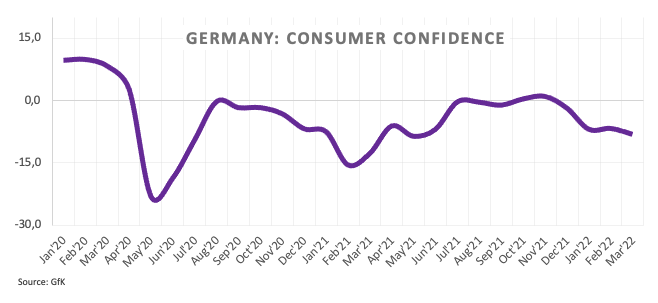- Analytics
- News and Tools
- Market News
CFD Markets News and Forecasts — 23-02-2022
- USD/CAD struggles to keep the late Wednesday’s corrective pullback.
- Bearish MACD signals, failures to stay beyond short-term key supports keep sellers hopeful.
- Monthly descending trend line restricts immediate upside.
USD/CAD prints mild losses around 1.2730 on failure to keep the latest rebound during Thursday’s Asian session.
The Loonie pair refreshed weekly low the previous day before reversing from 1.2681. The rebound portrays the quote’s another U-turn from a two-week-old rising trend line and 100-SMA.
It should be noted, however, that the bearish MACD signals join the recently sluggish moves to favor sellers eyeing another attempt to break the stated SMA and support line, respectively near 1.2715 and 1.2695.
Following that, the recent lows near 1.2680 and the 200-SMA level of 1.2655 will entertain the USD/CAD bears before the monthly bottom of 1.2636.
Alternatively, further upside needs validation from the one-month-long resistance line, near 1.2765 at the latest.
Following that, a run-up towards the 1.2800 threshold and January’s peak surrounding 1.2815 can’t be ruled out.
Though, 1.2850 and the 1.2900 round-figure may test USD/CAD bulls after 1.2800.
USD/CAD: Four-hour chart
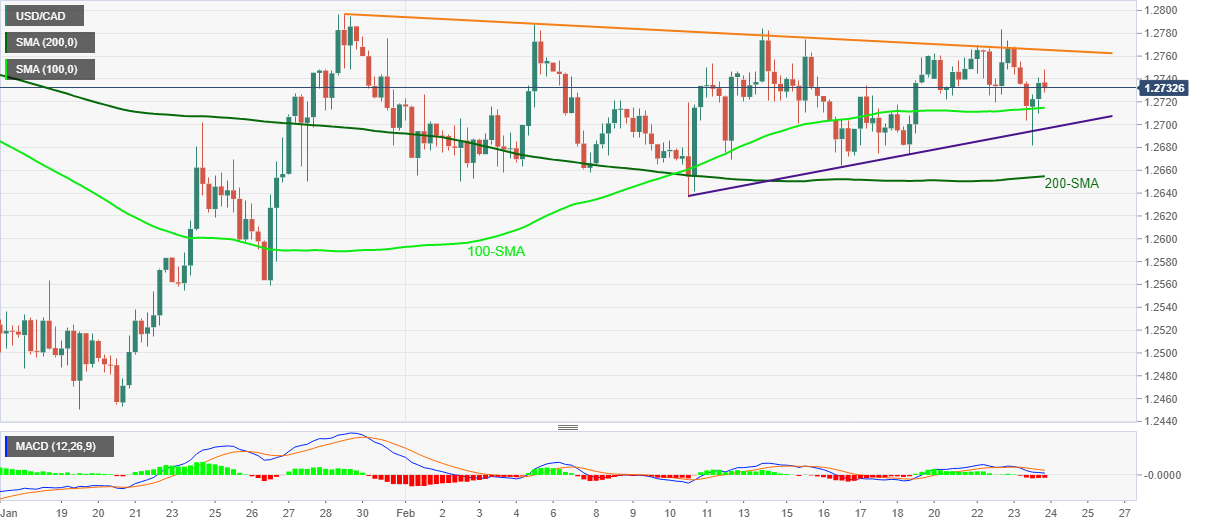
Trend: Further weakness expected
Ukraine declares the State of Emergency that markets had been waiting for.
Markets are in a trial spin of risk-off with the yen benefitting and AUD pressured to fresh risk-off lows at 0.7221.
There are also rumours that Russia's military action could begin at 4am local time (please note, this is not fact-checked but only a market rumour at the time of writing).
More to come...
- Bears are likely to strengthen once the cable slips below 1.3536.
- After violating the 50 and 200 EMA towards the south, bears have taken control.
- The RSI (14) has slipped below its range of 40.00-60.00, which adds to the downside filters.
The GBP/USD has slipped near the shared low of Tuesday and February 16 at 1.3539 in the American session as the cable loses ground after slipping below the 50-period and 200-period Exponential Moving Averages (EMA) on Wednesday.
GBP/USD is oscillating in a narrow range of 1.3536-1.3548 in the early Asian session after a bloodbath, which indicates that investors are initiating offers on expectations of a further downward move.
On an hourly scale, GBP/USD has fallen on the face after the major retreats from Wednesday’s high at 1.3621. It is worth noting that the 50 and 200 EMAs are on the verge of shaping a bearish crossover, which would add to the downside filters.
The Relative Strength Index (RSI) (14) has breached its oscillation range of 40.00-60.00 on lower side, which claims for more weakness ahead, showing no signs of divergence and oversold.
Bears are now eyeing Wednesday’s low at 1.3536, as violation of the same will push the cable towards the February 11 low at 1.3514, followed by February 15 low at 1.3486.
On the flip side, bulls can show up if the cable overstep Wednesday’s high at 1.3621 decisively towards Friday’s high at 1.3643 and January 20 high at 1.3662 respectively.
GBP/USD hourly chart
-637812531686305040.png)
- Silver record gains during the week, up 2.78%, despite rising US Treasury yields.
- San Francisco Fed's President Daly said that the Fed would need to hike more than four times, and looks to hike in March.
- XAG/USD Technical Outlook: Upward biased, as silver bulls prepare an attack towards $25.00.
Silver rally extends to six consecutive trading sessions amid rising tensions in the Russia/Ukraine conflict. At press time, XAG/USD is trading at $24.55.
Two US intelligence officials commented that Russia could invade Ukraine
Ukraine – Russia tensions increase. What started as a “calm” day in the financial markets has taken its toll, as US press via Newsweek expressed that an invasion from Russia could occur within 24/48 hours.
The article said that Ukraine’s President has been warned that Russia “will highly begin an invasion within 48 hours based on US intelligence.” As reported by a US intelligence official, Russia’s invasion would consist of airstrikes, cruise missiles, ground invasion, and cyberattacks.
At press time, the US 10-year Treasury Note yield rises five basis points sits at 1.998%, failing to weigh on the white metal, benefited by heightened tensions in Ukraine.
Appetite for safe-haven assets has increased in the last couple of weeks due to uncertainty in Eastern Ukraine. In the case of silver, the non-yielding metal rose to a four-week high above $24.60, leaving the 200-day moving average (DMA) at $24.24 below.
An absent US economic docket featured San Francisco Fed’s President Mary Daly emphasized the need to hike rates in the March meeting, though it is unclear how far the Federal Funds Rate needs to go and indicated that more than four rate hikes would be needed. Worth noting that analysts estimated the neutral rate to be somewhere around the 2.5% area.
XAG/USD Price Forecast: Technical outlook
The silver daily chart depicts neutral-upward bias after the broken ten-month-old downslope trendline, exposing the 200-DMA at $24.26. Nevertheless, a daily close over the abovementioned trendline would be required so that XAG bulls could use the $24.00-20 area as consolidation as they prepare to break the 200-DMA.
If the mentioned scenario plays out, XAG/USD’s first resistance would be January 20 daily high at $24.70. Breach of the latter would expose the $25.00 mark as the next support level. A decisive break would send XAG/USD rallying towards November’s 2021 highs at $25.40.
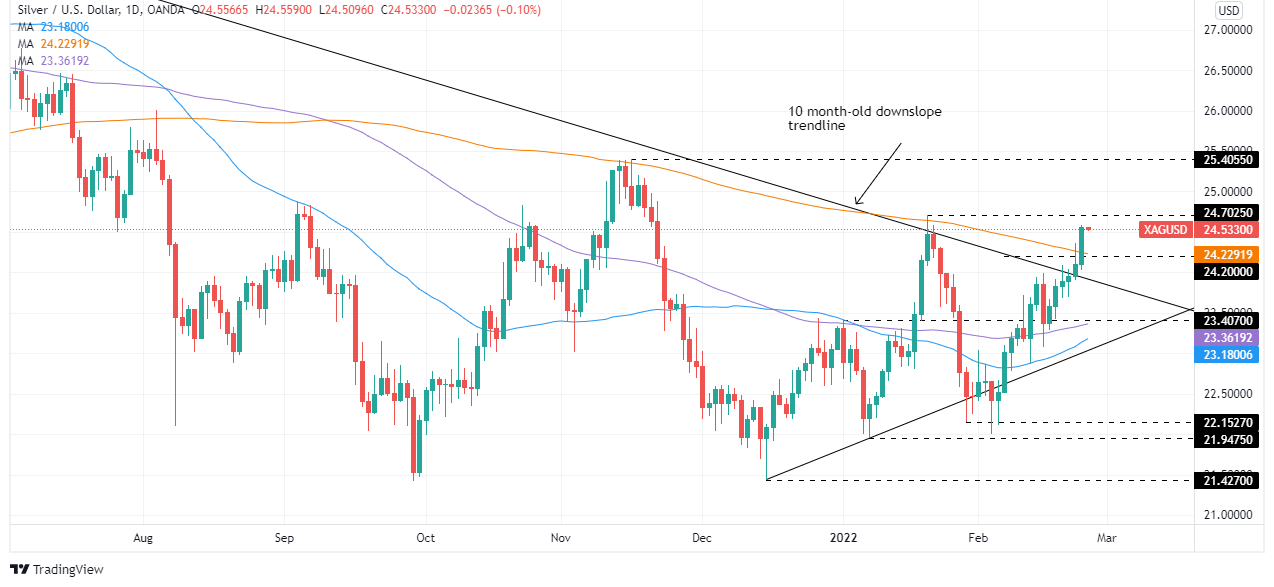
San Francisco Federal Reserve Bank President Mary Daly crossed wires, via Reuters, during an extended speech towards early Thursday morning in Asia.
The Fed policymaker initially said, “(She) No longer believes that raising U.S. interest rates every other meeting and delaying a reduction in the Fed's balance sheet until later in the year is appropriate, given signs that inflation is broadening and workers are not charging back into the labor force.”
Also read: Fed's Daly: Rates will be moved up this year to a level more consistent with where the economy is
Additional comments
I do think having a little more urgency to moving interest rates up to a level that’s in line with what the economy needs today is important.
Raising rates just once a quarter, as the Fed did after the Great Recession, ‘To my mind doesn’t satisfy the moment.’
Has also pulled forward her preferred timing for starting to reduce the Fed's balance sheet.
Expects the Fed to begin raising rates in March and subsequent meetings by a quarter-of-a-percentage point at a time, but did not rule out bigger half-point hikes if needed.
All of our possibilities are on the table.
There will be more data on inflation and on jobs before the Fed's March policy meeting.
Doesn't believe there is a case for 'frontloading' the Fed's response to inflation, especially since healing supply chains may help slow price rises.
We need to get policy in line but we can’t be impatient about doing it all today.
Market reaction
EUR/USD remains more or less the same after the latest Fedspeak while being burdened due to the risk-off mood. The major currency pair was last seen flirting with the 1.1300, after declining 0.20% the previous day.
Read: EUR/USD falls sharply towards 1.1300 as Ukraine – Russia conflict escalates
"Today, putin did not respond to a request for a phone call," said Ukraine President Volodymyr Oleksandrovych Zelenskyy during early Thursday morning in Asia.
Ukraine President Zelenskyy warned that Russia's move could escalate tensions while also saying, "Ukraine is not a threat to Russia."
During late Wednesday, Ukraine Foreign Minister Dmtryo Kuleba also requested an emergency meeting of the United Nations (UN) Security Council.
Read: Ukraine Foreign Minister Kuleba: We have asked the UN Security Council to convene an emergency meeting
Elsewhere European Union (EU) Foreign Ministyer Josep Borrell said that the EU encourages Russia to avoid escalatory moves.
FX implications
The news adds to the market's risk-off mood and weigh on the AUD/USD prices, considered risk-barometer in Asia.
Read: AUD/USD eases from six-week top towards 0.7200 as Russia-Ukraine jitters sour sentiment
- AUD/USD retreats after refreshing multi-day top, pausing three-day uptrend of late.
- Wednesday’s initially upbeat mood spoiled as Ukraine declared state of emergency, as well as chatters over Russian troops.
- Aussie wage price data came in stronger but below RBA’s target, Fed’s Daly sounds cautiously optimistic.
- Aussie Private Capital Expenditure, second reading of US Q4 GDP will decorate calendar.
AUD/USD holds lower ground near 0.7230, following a pullback from a six-week high, as market sentiment sours on escalating fears of the Russia-Ukraine war. In doing so, the Aussie pair pauses three-day uptrend during the early Thursday morning in Asia.
The risk barometer pair rallied to the highest since mid-January the previous day before reversing from 0.7285 as the odds of an imminent Russian invasion of Ukraine gained pace, backed by the US intelligence. Also keeping the risk higher were cyber-attacks on Ukrainian banks and the government.
It’s worth noting that Kyiv recently declared a 30-day state of emergency and Foreign Minister Dmtryo Kuleba also requested an emergency meeting of the United Nations (UN) Security Council. Furthermore, satellite imagery company Maxar conveyed new deployments of Moscow’s troops in western Russia.
Such headlines weighed on the AUD/USD prices and probe the previous three-day uptrend.
In addition to the geopolitical fears, cautiously optimistic Fedspeak also contributed to the AUD/USD pair’s latest pullback. Recently, San Fransisco Fed President Mary Daly said on Wednesday that interest rates will be moving up this year to a level more consistent with where the economy is, according to Reuters. "It's too early to call how far rates will need to rise this year,” the policymaker added.
At home, Australia’s Wage Price Index for the fourth quarter (Q4) closely missed the 2.4% YoY forecast despite crossing 2.2% previous readout with a 2.3% level. The wage price gauge matched 0.7% expected figures on MoM. That said, the Construction Work Done contracted to -0.4% from -0.3%, versus +2.5% market consensus, during the stated period.
Given being in the driver’s seat, AUD/USD traders need to pay attention to the geopolitical headlines due to their recent fame. Talking about data, Australia Private Capital Expenditure for Q4, expected +2.6% versus -2.2% prior, will direct immediate moves ahead of the second reading of the US Q4 GDP, expected 7.0% versus 6.9% prior.
Technical analysis
Failures to provide a daily closing beyond the 100-DMA and a descending trend line from mid-November, respectively around 0.7240 and 0.7275, keep AUD/USD buyers cautious. However, sellers need validation from a four-month-old previous resistance line, close to 0.7180 for re-entry.
- Wednesday’s choppy session witnessed GBP/JPY moving towards February 22 daily low at 155.50.
- The British pound weakened in the session, benefitting safe-haven peers.
- GBP/JPY is downward biased as a double-top chart pattern looms, with a target of 153.80.
The GBP/JPY is subdued on Wednesday’s choppy trading session, as market sentiment fluctuated between risk-on/off. The GBP/JPY is trading at 155.73.
The market sentiment is downbeat as US equity indices fell 1.38% and 2.60%. In the FX space, the mood is mixed, as safe-haven peers like the US dollar, the Japanese yen, and the Swiss franc edged up vs. the British pound.
GBP/JPY Price Forecast: Technical outlook
GBP/JPY daily chart depicts a double-top, following the rally from January 24 low at 152.90, to February 10 high at 158.06. That said, in the last five days, the risk-off market mood boosted the prospects of the JPY, leading to a leg-down followed by a sudden spike to the 157.00 area retreating afterward to current levels.
Therefore, the GBP/JPY is downward biased, despite the daily moving averages (DMAs) residing below the spot price. Further, the double top’s target would be 153.50, 50-pips above the 200-DMA. That said, the GBP/JPY first support would be the “neckline” around 155.50. Breach of the latter would expose the 50-DMA at 155.27, followed by the 100-DMA at 154.37, and then the 153.80 double-top target.
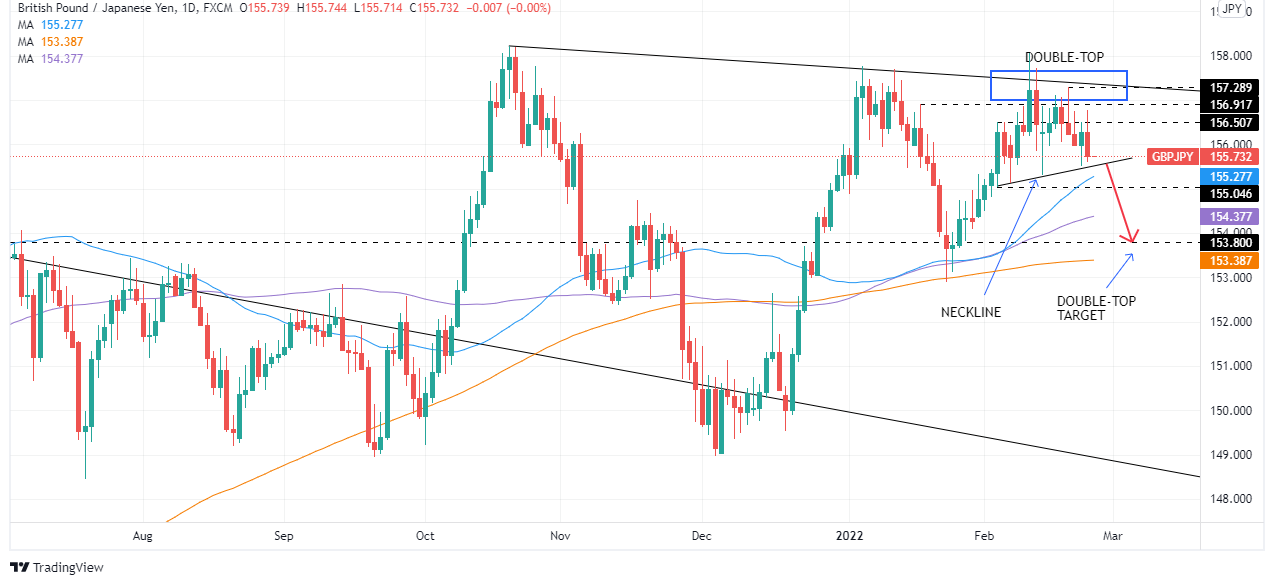
Ukraine Foreign Minister Dmtryo Kuleba’s briefing on geopolitical tensions with Russia recently added to the risk-off mood as the diplomat conveyed the emergency meeting request to the United Nations (UN) Security Council.
Ukraine Foreign Minister Kuleba also said, “The plea by separatist leaders to Russia for military support is a further escalation of the security situation.”
Meanwhile, a satellite imagery firm Maxar also mentioned new deployments of Moscow’s troops in western Russia.
Additionally, the Dnipro International Airport in eastern Ukraine is closed to arrival and departures until 7:00 AM local time Thursday.
FX implications
AUD/USD is considered risk-barometer pair and holds lower ground near 0.7230 amid recent challenges to market sentiment. On the contrary, gold prices remain firmer due to the metal’s safe-haven appeal.
Read: Gold Price Forecast: XAU/USD looks to reclaim $1914 amid risk-aversion theme
- Gold price is eyeing $1914.34 as investors prefer precious metal amid safe-haven appeal.
- The tensions between Russia and Ukraine escalated after the latter declared a state of emergency.
- Investors are eyeing Thursday's US GDP and Initial Jobless Claims.
Gold price is set to reclaim Tuesday’s high at $1914.34 as the uncertainty in the market reaches ceilings amid the geopolitical tensions between Russia and Ukraine. The economy is bracing for high inflation in the coming trading sessions as escalating sanctions fall on Russia to punish it for violating international law may continue to push oil prices higher.
On Wednesday, Ukraine called its citizens back from Russia and declared a state of emergency. While, Moscow began evacuating its Kyiv embassy, in the latest ominous signs for Ukrainians who fear an all-out Russian military onslaught, as per Reuters.
The lack of positive developments over the Russia-Ukraine tussle has put the investors on their toes and investors are very harsh on risk-sensitive assets.
The galloping volatility in the market has improved the safe-haven appeal and investors are pouring funds into the precious metal.
Meanwhile, the US dollar index (DXY) surpasses 96.00 on expectations of improvement in US Gross Domestic Product (GDP) numbers and Initial Jobless Claims, which are due on Thursday. An aggressive tightening policy by the Federal Reserve (Fed) in March’s monetary policy meeting is losing momentum as the economy can go through tough times amid the expectation of the most destructive war since 1945.
Gold Technical Analysis
On a 15-minute scale, XAU/USD has retreated after kissing the trendline placed from Monday’s low of $1886.66. The precious metal is expected to extend gains towards Monday’s high at $1914.34. The Relative Strength Index (RSI) (14) is likely to strengthen bulls after overstepping 60.00.
Gold 15-min chart
-637812499299111853.png)
- The shared currency in the week is recording a loss of 0.12%.
- Ukraine – Russia tensions keep grabbing the spotlight amid diplomacy failure.
- EUR/USD path of least resistance is downwards and soon could break under the 1.1300 handle.
On Wednesday, the EUR/USD slides as Ukraine – Russian tensions increase as US intelligence officials reported that Russia could invade Ukraine within the next 24/48 hrs. During the day, the EUR/USD reached a daily high at 1.1358, but worsened market mood witnessed ebbs flowing to the greenback. At the time of writing, the EUR/USD is trading at 1.1309.
During the day, the Eurozone reported inflation figures for January, with headline HICP Flash annual based increased 5.1%, barely unchanged, while so-called Core HICP came at 2.3% as estimated. ECB speakers parade continued in the day. Most ECB officials commented about inflations, seeing upside risks on it, and it could remain higher than expected and for longer than thought. ECB Vasle commented that it is time to move towards a normal monetary policy.
On the US front, San Francisco Fed President Mary Daly emphasized the need to hike rates in the March meeting, though it is not clear how far the Federal Funds Rate needs to go and indicated that more than four rate hikes would be needed. Worth noting that analysts estimated the neutral rate to be somewhere around the 2.5% area.
In the meantime, the US Dollar Index, a measure of the greenback’s performance vs. a basket of six rivals, is up 0.18, sitting at 96.20, while the US 10-year benchmark note sits at 1.984%, up three and a half basis points, a headwind for the EUR/USD.
EUR/USD Price Forecast: Technical outlook
The EUR/USD is downward biased from a technical perspective. EUR/USD bull’s failure to hold above the 100-day moving average (DMA) at 1.1389 exposed the pair to a significant amount of selling pressure. That said, the EUR/USD path of least resistance is to the downside.
The EUR/USD first support would be 1.1300. Breach of the latter would expose February 3 low at 1.1267, followed by 2021 December 15, at 1.1221, and then the 1.1200 mark.
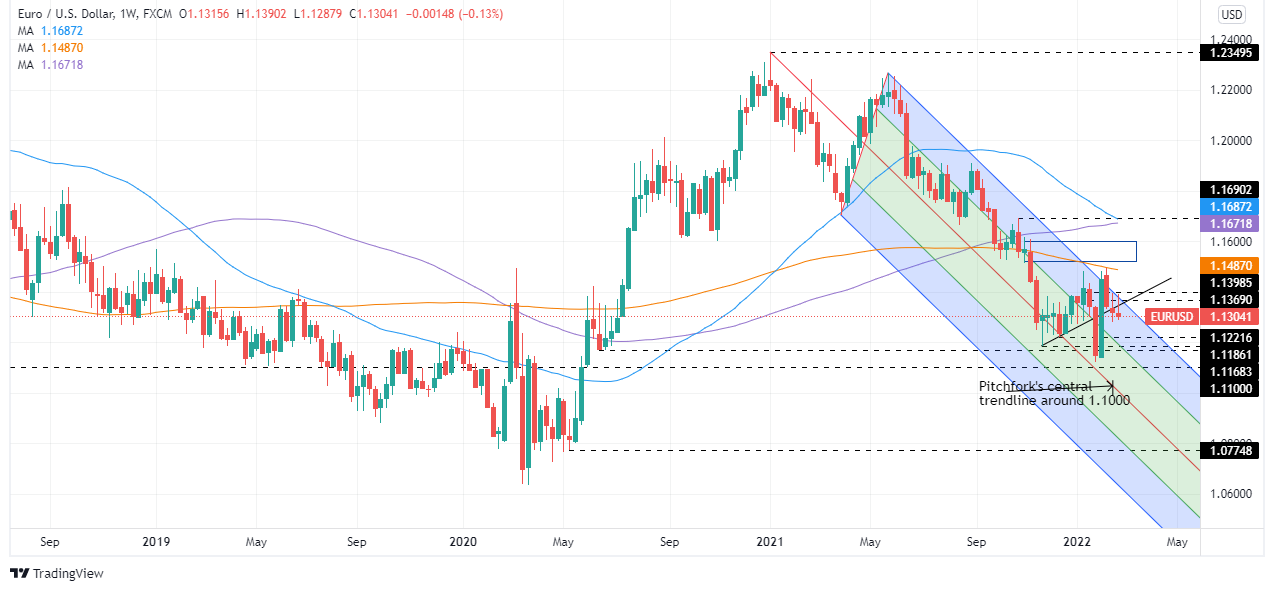
San Fransisco Fed President Mary Daly said on Wednesday that interest rates will be moving up this year to a level more consistent with where the economy is, according to Reuters.
Additional Remarks:
"It's too early to call how far rates will need to rise this year."
"We are on a path toward an economy with tighter monetary policy."
"I expect we will start raising rates in March, and will be raising them in subsequent meetings to get closer to neutral."
"How close to neutral rates will get is not certain and will depend on the data."
"I don't see anything right now that would disrupt plans for a March rate hike."
"The geopolitical situation is part of larger uncertainty to navigate, but is not disrupting plans for liftoff."
"Inflation is well above our goal."
"We need to demonstrate that the Fed is committed not to allow perpetuating spiral of inflation."
"Raising rates at least four times would be my preference."
"Most likely it will need more than four rate hikes."
"I am committed to getting demand and supply in balance."
"Raising interest rates isn't slamming the brakes on the economy."
"The last thing you want is an economy that's going too fast."
"We want to gradually move rates up."
"Fed policymakers will deliberate whether balance sheet reductions will start after two rate hikes, or three rate hikes."
The S&P 500 index has pierced the weekly lows (24 Jan 4,222.62), printing a low of 4,221.51.
As per the prior analysis, If Russia does invade Ukraine, this could finally spark off the crash 'puts' have been telegraphing, the Ukraine crisis has started to play out as warned:
Amid Ukraine/Russia tensions and the potential for slowing growth, markets have been trading far more defensively on Wednesday, tipping the stocks markets over the edge of the abyss, almost:
SPX weekly chart
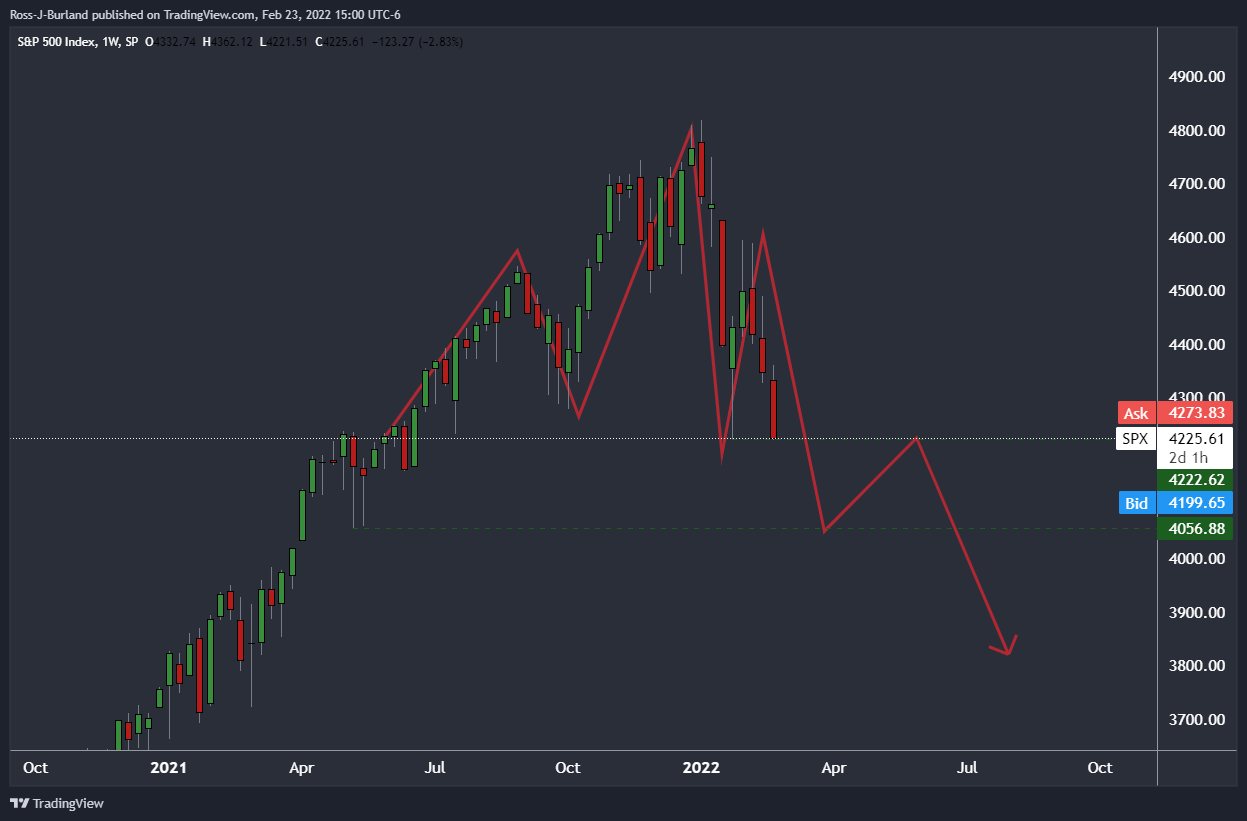
In the above analysis, the index has been shown to form a topping head & shoulders on the weekly chart with the price just having broken the prior weekly lows of Jan 24 2022. This is a significant development for financial markets are a pivotal point in the Ukraine crisis that just turned up a notch.
More to come...
- Risk appetite took a turn for the worse during US trade, forcing EUR/JPY to hand back early session gains.
- Amid fears that Russia is on the brink of invading Ukraine, the pair dropped back to the 130.00 area.
Risk appetite took a turn for the worse during US trading hours on Wednesday, forcing EUR/JPY to hand back early session gains that took it as high as the 130.70 mark. The pair has since dropped back to the 130.00 area, where it now trades with losses of 0.2% on the day versus the 0.3% gains it was trading with at session highs.
Market commentators citing the rising risk of a Russian military incursion into Ukraine as the major reason for the downturn in sentiment during US trade. Reports suggesting US intelligence had warned Ukraine of Russian plans to invade within 48 hours and Ukraine has just approved a state of emergency and urged its citizens to flee Russia.
Despite choppy, two-way trade on Wednesday that saw EUR/JPY swing within a more than 70 pip range, the day’s volatility has remained easily contained within Tuesday’s 129.40-130.80ish ranges. Indeed, as market participants continue to monitor the unpredictable geopolitical landscape and react to developments headline by headline, trading conditions are likely to remain choppy and difficult.
To the downside, weekly lows in around 129.40 is the major support to watch and below that is the long-term uptrend from November 2020. Given the ECB’s ongoing hawkish shift towards admitting that it will tighten in Q4 this year (see ECB’s Philip Lanes comments on Wednesday), a longer-term move under 129.00 seems unlikely.
US Department of Defence spokesperson Joh Kirby said on Wednesday that Russian forces are in an "advanced" state of readiness near Ukraine. Separately, the White House reiterated on Wednesday that US President Joe Biden does not have any plans to send soldiers to Ukraine to fight.
San Fransisco President and FOMC member Mary Daly on Wednesday said that it is now time to move away from the Fed's extraordinary support for the US economy, according to Reuters.
Additional Remarks:
"The timing and magnitude of rate hikes and balance sheet adjustments will depend on how the economy and data evolve."
"It is appropriate to begin policy adjustment in March, absent any significant negative surprises."
"By almost any measure, the economy is doing well and labor market gains have been broad-based."
"The focus for the next few years will be on bringing inflation back down, delivering a labor market that works for everyone, despite uncertainty."
"Inflation is too high and has spread beyond Covid-affected sectors."
"As the Fed adjusts policy and we move to a post-pandemic world, we need to keep in mind pre-pandemic challenges, including downward pressure on inflation."
Market Reaction
Daly's comments are nothing new and thus have not moved FX markets.
RBNZ Governor Adrian Orr said on Wednesday that the official cash rate (OCR) will be above neutral by this time next year, according to Reuters. There is a heightened global inflation environment, he warned, explaining why the RBNZ has decided to step off the gas pedal. There is a clear path of rate hikes ahead of us, Orr added, with inflation at currently unacceptable levels.
Market Reaction
Orr's remarks are in line with what he said in wake of the recent RBNZ policy meeting during Wednesday's Asia Pacific session and thus have not prompted a market reaction.
- AUD/JPY bears sink in their teeth and are plenty hungry.
- The Ukraine crisis has been turned up a notch and the cracks in risk sentiment and flowing through to the yen.
As per the prior analysis of AUD/JPY, as illustrated in the following article that warned of prospects of a turn in risk appetite due to blatant prospects of escalated tensions surrounding, the Ukraine crisis has started to play out as warned:
- If Russia does invade Ukraine, this could finally spark off the crash 'puts' have been telegraphing
AUD/JPY structure and a blueprint for potential price trajectory were drawn out on the daily chart with a bearish bias as follows:
AUD/JPY, daily chart, prior analysis
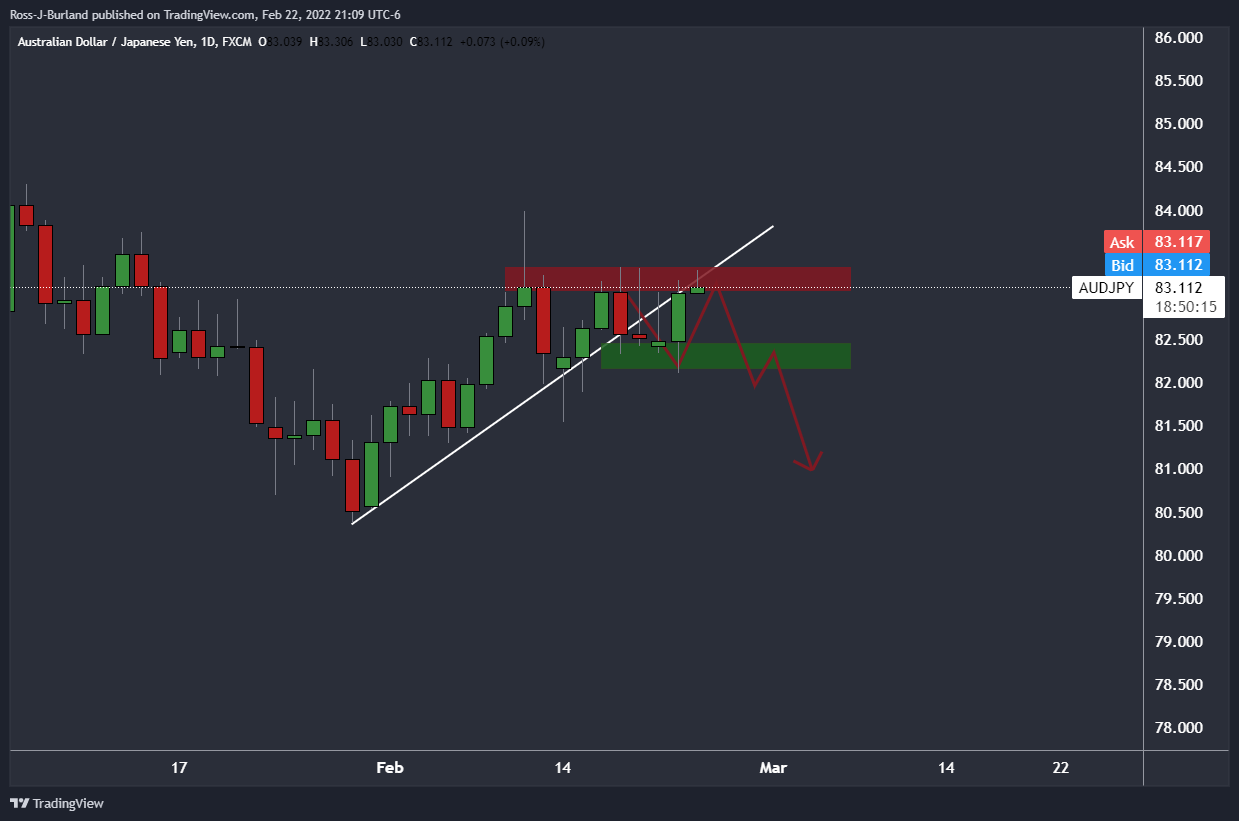
''If there is going to be a meaningful move in sentiment, the forex markets risk barometer, AUD/JPY, that is retesting the daily counter-trendline, could be shaken out of its tree in the coming days. Eyes will be on whether it can take out the recent lows of 82.12: ''
AUD/JPY live market analysis
Meanwhile, although we saw a secondary breach of the resistance in Asia and European sessions amidst a market that continued to price more benign outcomes of the crisis, the price has indeed succumbed to the growing angst:
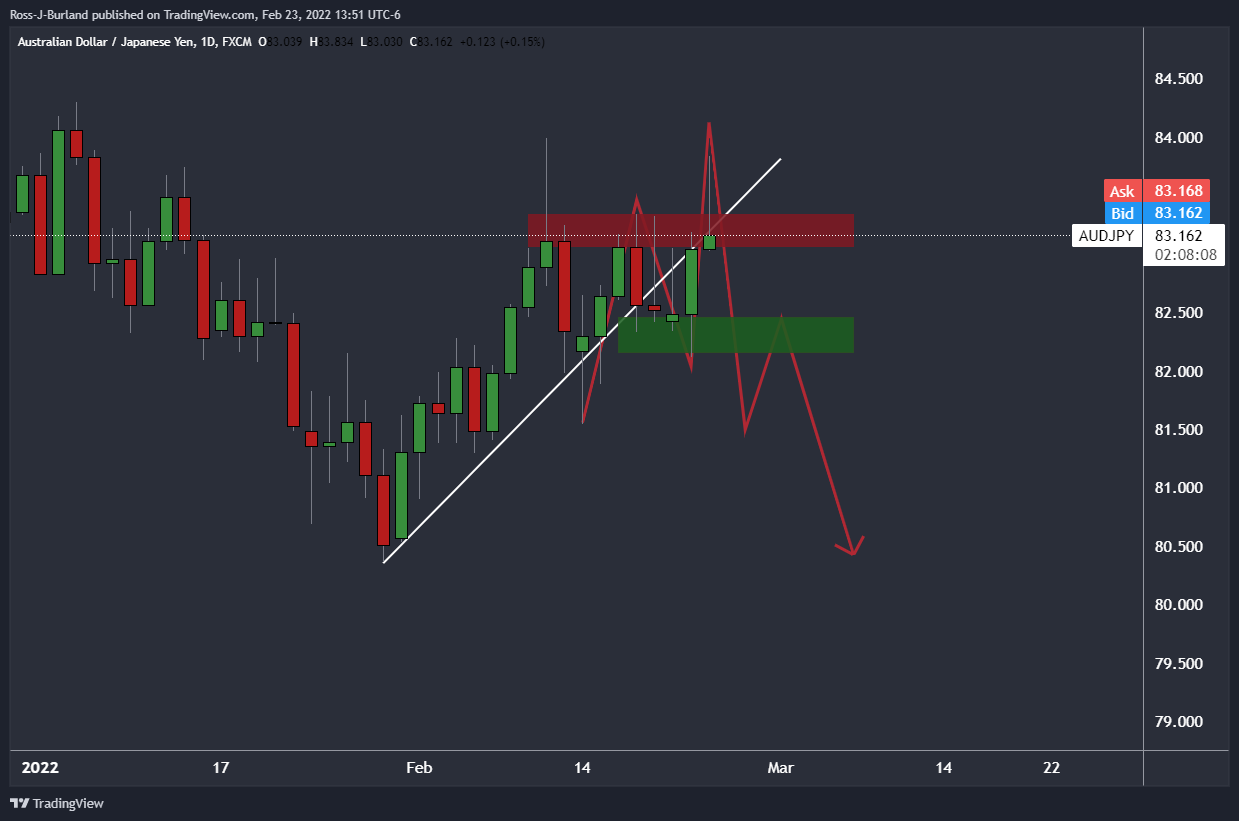
Given the latest escalation of the Ukraine crisis, it would only be fair to forecast a more extreme outcome in price action that might be representative of the grave troubles that lie ahead for the global economy. After all, the volatility on the pair today has seen the price move between a range of 80 pips, most of which occurs in the first half of the New York session.
What is key to acknowledge on the daily chart is the prospect of today's close leaving an accompanying double top wick, similar in length to that of 10 Feb. If the price is to react to the news feeds just as it did on Feb 10, when UK Foreign Secretary Liz Truss and Russian FM Sergey Lavrov held fruitless talks, in the first signs that diplomacy was never going to be an option, then it wouldn't be too ambitious to expect a similar 2% follow through to the downside in the coming days.
-
USD/JPY's Price Analysis: Weekly and daily pin bars are highly bearish
If there risk sentiment continues to be beaten down into the end of the week, taking into consideration the bearish market structure in USD/JPY as well, along with a less hawkish outlook for the Reserve Bank of Australia, then we could see the makings of a bearish structure below the counter trendline once again resulting in a bearish M-formation, as illustrated on the drawings above. The key levels in this respect are 83.05, 82.50 and 82.12 with 81.50 as the longer-term, target.
USD/JPY daily chart
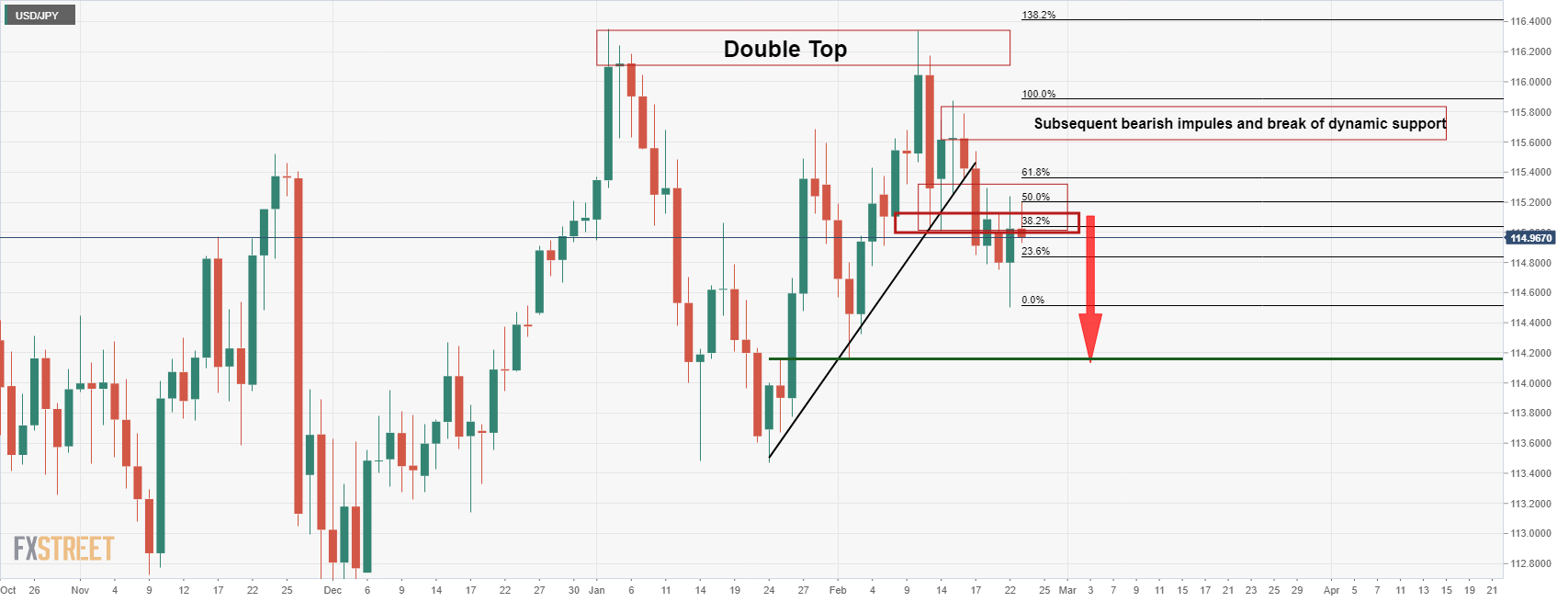
''The above analysis, as per USD/JPY's Price Analysis: Weekly and daily pin bars are highly bearish, illustrates the bearish bias given the series of bearish events in price action since the double top was accompanied by a bearish engulfing close on Feb. 11. We have since seen a break of the trendline support and retests back into the cluster of offers below 115.30.
The price is failing there and near a 50% mean reversion of the bearish impulse that broke the dynamic support. This leaves the attention on the downside towards 114.20 for the days ahead as the last defence for much lower levels.''
What you need to take care of on Thursday, February 24:
The day started with investors optimistic about Eastern Europe developments, but the market’s sentiment deteriorated during US trading hours, resulting in the greenback strengthening against most of its major rivals.
Ukraine declared the State of Emergency starting February 24 and for 30 days amid reports from US intelligence indicating Russia will likely invade within the next 48 hours, despite multiple sanctions imposed on Russia from West countries. Also, multiple Ukrainian government websites went offline after a DDoS attack blamed on Russia.
In the UK, Bank of England Governor Andrew Bailey said they would consider selling assets after the main rate hit 1%, and referred to a “quite gradual” path to unwinding the balance sheet. He also added that the word transitory for inflation was becoming overused.
The EUR/USD pair trades around the 1.1300 level, approaching its weekly at 1.1287. The GBP/USD pair is firmly lower and at weekly lows in the 1.3530 price zone. Commodity-linked currencies, on the other hand, are correcting lower, but still holding on to intraday gains. Generally speaking, risk aversion is likely to persist.
The Japanese yen and the CHF edged higher against their American rival, although gains were limited.
Spot gold is up, trading at around $1,908 a troy ounce. Crude oil prices ended the day little changed, with WTI trading little changed at around $91.80 a barrel.
Wall Street start the day with gains, but gave up on risk aversion and ended in the red.
Binance dives into play to earn gaming with Netmarble’s ‘Golden Bros’ NFT collection
Like this article? Help us with some feedback by answering this survey:
- NZD/USD has pulled back to near 0.6770 from earlier highs above 0.6800 as risk appetite deteriorates amid geopolitical concerns.
- But the kiwi is still the best performing G10 currency in the afterglow of Wednesday’s hawkish RBNZ meeting.
- NZD/USD continues to trade higher by about 0.6% on the day.
NZD/USD has pared a significant portion of its earlier gains and now trades back near the 0.6770 level, having at one point been as high as 0.6810, where it was up about 1.2% at the time. Risk appetite has taken a turn for the worse since the onset of US trade this Wednesday as a result of rising fears that Russia might be on the brink of invading Ukraine, weighing on risk assets like the kiwi. But the pair still trades with gains of about 0.6% on the day and remains the best performing currency in the G10, as the kiwi retains an underlying bid as a result of Wednesday’s more hawkish than anticipated RBNZ meeting.
To recap quickly, the bank lifted interest rates by 25bps to 1.0% as expected, disappointing some calls for a 50bps hike, but said it had been close to implementing the larger rate hike. The central bank also revised higher its projected interest rate path to a peak of 3.35% from 2.6% previously, much more than previously expected and announced plans to start actively selling down its New Zealand government bond holdings. “Given how much work the RBNZ believes it has ahead of it,” analysts at Westpac said, “the risk of a 50bp move at any given meeting remains live”.
The RBNZ’s hawkish shift arguably makes it the first G10 central bank to signal that it wants to take monetary policy into tight territory, i.e. interest rates well above the so-called “neutral rate”. That may help underpin NZD in the coming weeks/months, though an important FX market driver in the near-term is set to remain geopolitics and Fed tightening expectations. If Russia really does plan on invading Ukraine anytime soon, it might be a while before NZD/USD is able to get back above 0.6800 again. Rather, a move back under 0.6700 on risk aversion/USD safe-haven bid, seems more likely.
- US equities are down for a fourth successive session on Wednesday as fears of a Russian invasion of Ukraine build.
- The S&P 500 fell back under the 4300 level to then hit fresh monthly lows under 4260.
US equities were down for a fourth consecutive session on Wednesday fears about a full-scale Russian invasion of Ukraine continued to rise. The S&P 500 fell back under the 4300 level and hit fresh monthly lows under 4260, with bears eyeing a test of annual lows around 4222. At current levels near 4250, the index trades with losses of about 1.2% on the day. The Nasdaq 100 index dropped 1.7% to hit fresh annual lows under 13.7K, while the Dow fell a further 0.9% and back below 33.5K and is also eyeing a test of annual lows in the 33.3K area. The S&P 500 CBOE Volatility Index rose about half a point into the mid-29.00s, still a little below February’s double top in around 32.00.
Regarding the latest on the Russia/Ukraine front, following various sanction announcements from the likes of the US, UK and EU over the last two days, satellite imagery has continued to show a build-up of Russian troops on Ukraine’s borders. In response, Ukraine declared a national emergency and instructed citizens in Russia to flee, while Moscow started an evacuation of its diplomatic staff in Kyiv. Elsewhere, reports earlier in the session citing US intelligence officials said that the US had warned Ukraine of a Russian plan to mount a full-scale assault within the next 48 hours.
As investors question whether there will or won’t be a major Russia/Ukraine conflict, and ponder how Western sanctions against Russia in the event of a full-scale assault would impact the global economy, US equity markets unsurprisingly remain tetchy. In the absence of more certainty, and against a backdrop of expectations for a significant degree of Fed tightening this year, the prospect for any meaningful rebound looks slim at present.
- Bears take charge and are testing below critical support structures across the timelines.
- USD/JPY has been pressured by a chorus of concerning headlines surrounding the Ukraine crisis.
USD/JPY is under pressure as the yen picks up a safe-haven bid amid the latest bullish developments for the currency pertaining to the onset of war between Russia and the West.
Following news that Russian President Vladimir Putin had sent troops into separatist regions of Ukraine, the prospects of a deeper infiltration into the country was announced just after the Wall Street open by the United States of America. According to US intelligence, Russia will invade within 48hrs.
Further reports enhanced the risk-off moves on Wednesday that cited convoys of military equipment moving towards Donetsk in eastern Ukraine from the direction of the Russian Frontier. Consequently, Ukraine has planned to declare a state of emergency and the yen started to breakdown the hourly support vs the US dollar as follows:
USD/JPY H1 chart
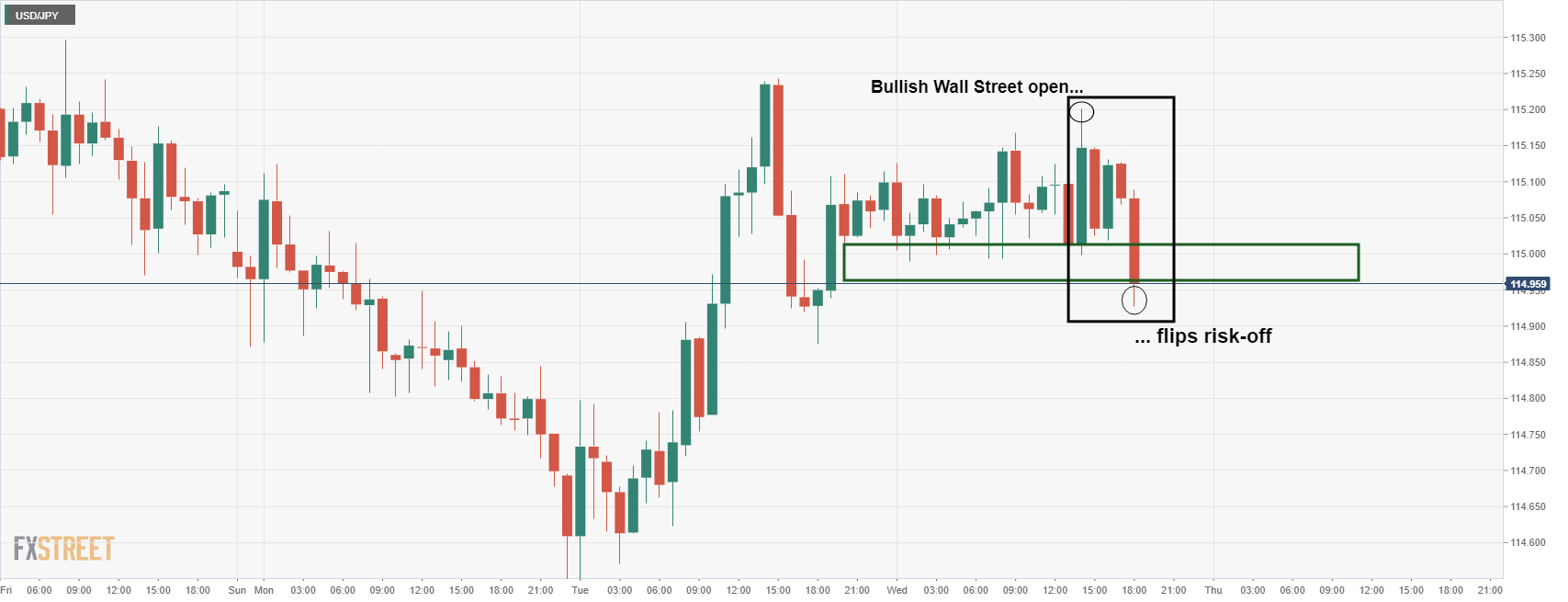
The price action on the hourly time frame is making for a bearish structure, confirming the bias:
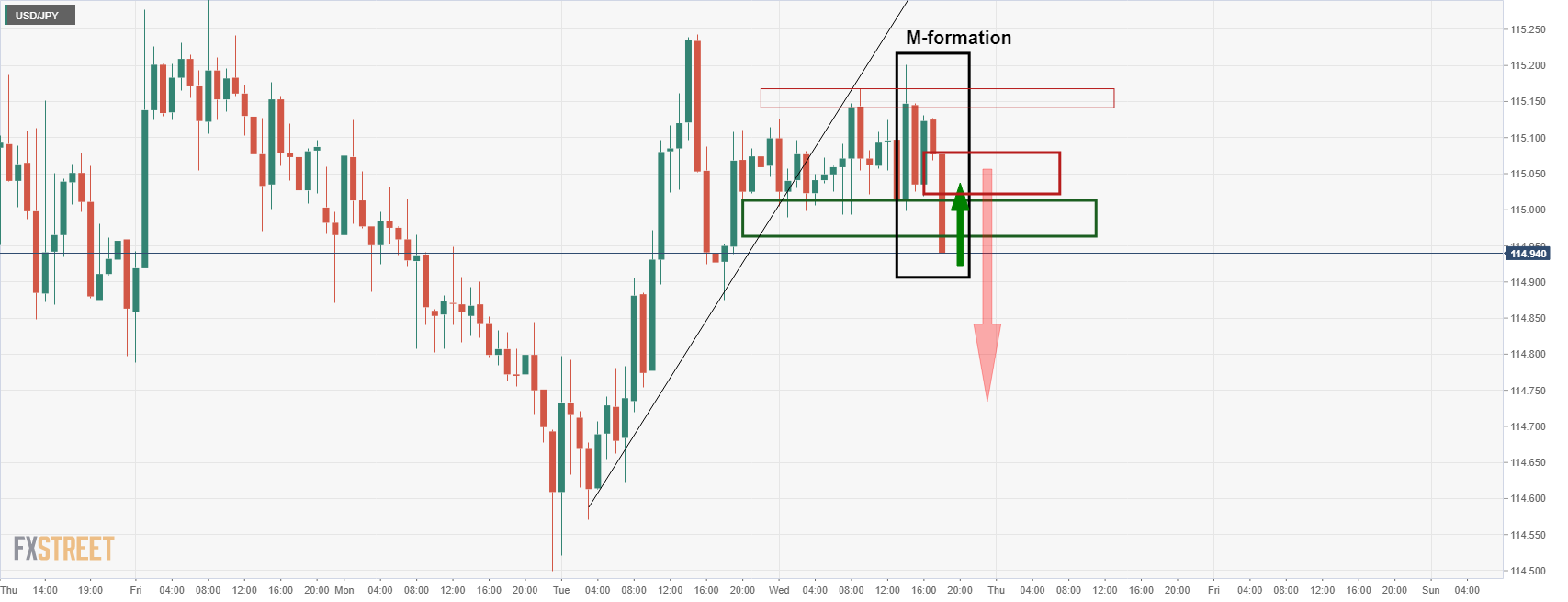
The M-formation would be expected to pull in the bulls for a restest to the neckline near 115.05/15. This resistance would be expected to equate to a full-on breakout below the counter-trend lines and the sideways topping structure that has been building over the course of this week.
Meanwhile, from a longer-term perspective, the week and daily price action and market structure also give us a few clues on where the bias is on a technical basis.
USD/JPY weekly chart
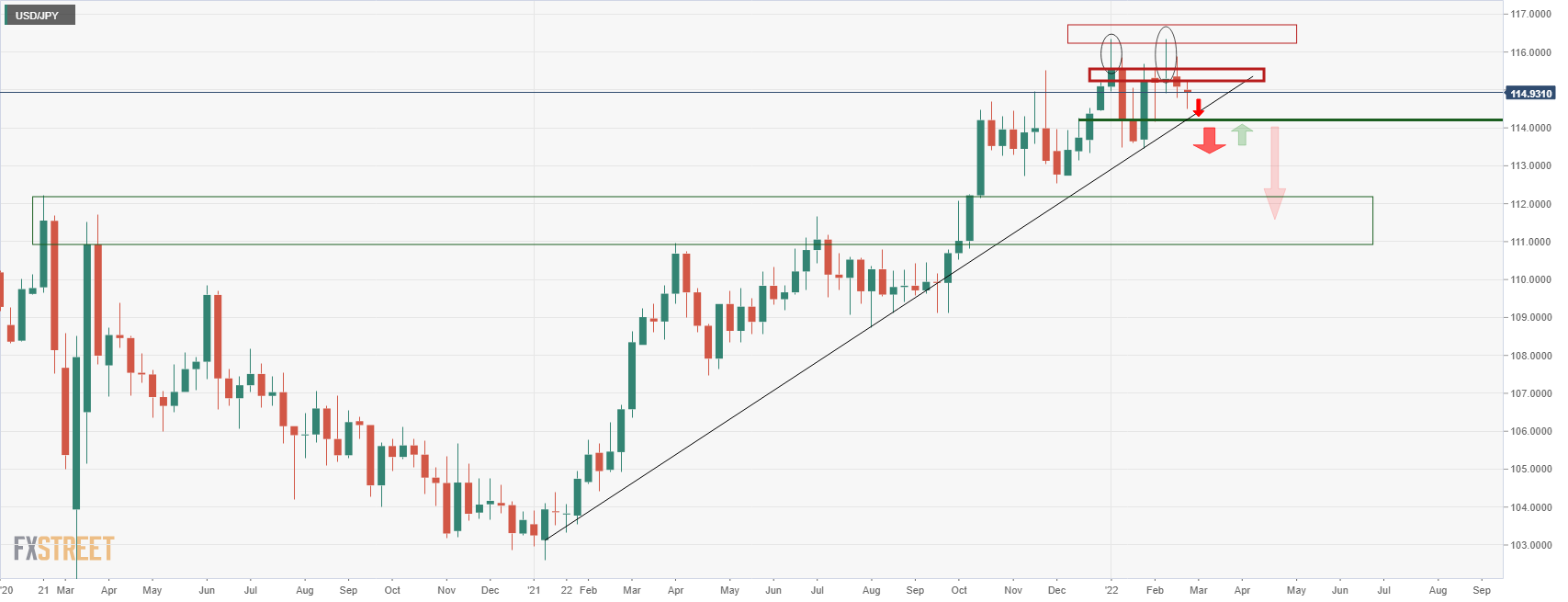
The weekly chart has been giving signs of bullish exhaustion since the middle of the month with the weekly wicks left unfilled by subsequent weeks of trading activity. The Bulls are tired and are throwing in the towel.
Additionally, the daily chart shows the bulls are losing the battle to the bears as follows:
USD/JPY daily chart
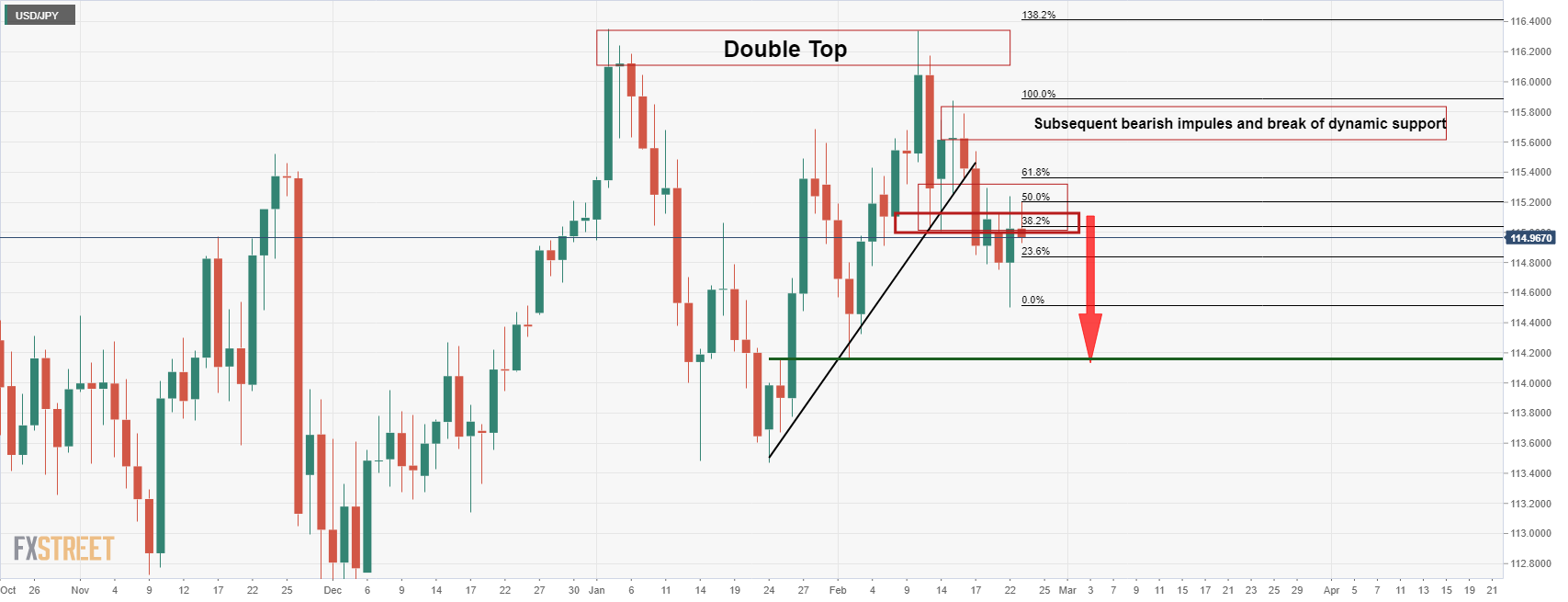
The above analysis illustrates the bearish bias given the series of bearish events in price action since the double top was accompanied by a bearish engulfing close on Feb. 11. We have since seen a break of the trendline support and retests back into the cluster of offers below 115.30.
The price is failing there and near a 50% mean reversion of the bearish impulse that broke the dynamic support. This leaves the attention on the downside towards 114.20 for the days ahead as the last defence for much lower levels:
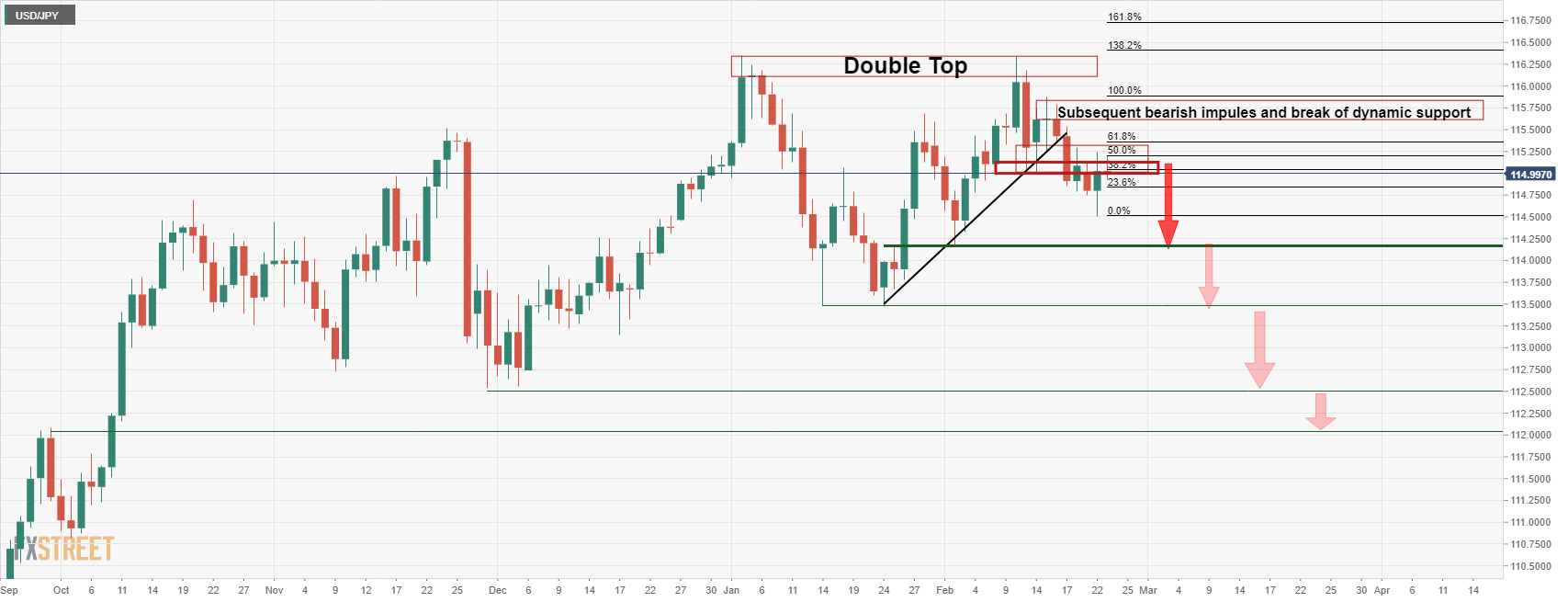
European Central Bank Chief Economist Philip Lane said that inflation rates in the Eurozone will remain higher than expected for longer than originally thought, according to Reuters citing Germany's Faz. As a result, the ECB is revising its assessment of the duration of inflation, Lane added, saying that inflation may be approaching its medium-term target. Lane reiterated that he expected inflation to ease in the course of the year, but that it is uncertain as to how fast and how far it will fall. Geopolitical tensions are currently a very significant risk factor, especially for Europe, Lane concluded.
Market Reaction
Lane's recognition that ECB inflation forecasts will need to be lifted at the coming policy meeting, likely implying that the ECB will end its net bond-buying in Q3 and start lifting interest rates in Q4, has not surprised the market, though is an important moment for ECB policy. The euro has not reacted.
- Ukraine - Russia conflicts, grab market participants’ attention, again.
- Bank of England members at the UK Parliament Treasury Committee pushed back against “aggressive” monetary policy tightening.
- GBP/USD Technical Outlook: Failure at 1.3600 originated a move towards 1.3500.
The British pound’s failure to hold above 1.3600 exacerbated a move towards the 1.3550 area as geopolitical angst rises and Bank of England dovish language. At press time, the GBP/USD is trading at 1.3551.
Update of the Ukraine crisis in Eastern Europe
Ukraine – Russia tensions increase. What started as a “calm” day in the financial markets has taken its toll, as US press via Newsweek expressed that an invasion from Russia could occur within 24/48 hours.
The article said that Ukraine’s President has been warned that Russia “will highly begin an invasion within 48 hours based on US intelligence.” Russia’s invasion would consist of airstrikes, cruise missiles, ground invasion, and cyberattacks, as reported by a US intelligence official.
Earlier on the day, BoE’s officials spoke before the UK Parliament Treasury Select Committee on Wednesday. The BoE Governor Andrew Bailey said that inflations risks are tilted to the upside but still “two-sided,” cautioning investors against aggressive betting on future interest rates. At the same hearing, another member who voted for a 50-bps rate hike at February’s policy meeting said the decision had been finely balanced. Another, who also voted for a 50-bps increase, said he now sees “modest” tightening over the coming months.
So, geopolitical anxiety and BoE’s dovishness boosted the prospects of the greenback, weighing on the GBP. Furthermore, the GBP/USD bull’s failure to break the 1.3600 mark exacerbated cable’s downward move, caused by profit-taking and selling pressure, as the GBP/USD fell 50-pips.
In the meantime, the US Dollar witnessed fresh ebbs into it, as the US Dollar Index, which measures, the greenback’s value against a basket of six currencies, edges up 0.17%, sitting at 96.19.
GBP/USD Price Forecast: Technical outlook
In the last two days, the GBP/USD finished with losses, though never below the 1.3550 mark. Initially appeared to be consolidation before resuming the uptrend, but Wednesday’s price action has fueled the expectations of a more significant than estimated downward move.
The GBP/USD first support would be 1.3550. Breach of the latter exposes the 50-day moving average (DMA) at 1.3512, followed by the 100-DMA at 1.3502.
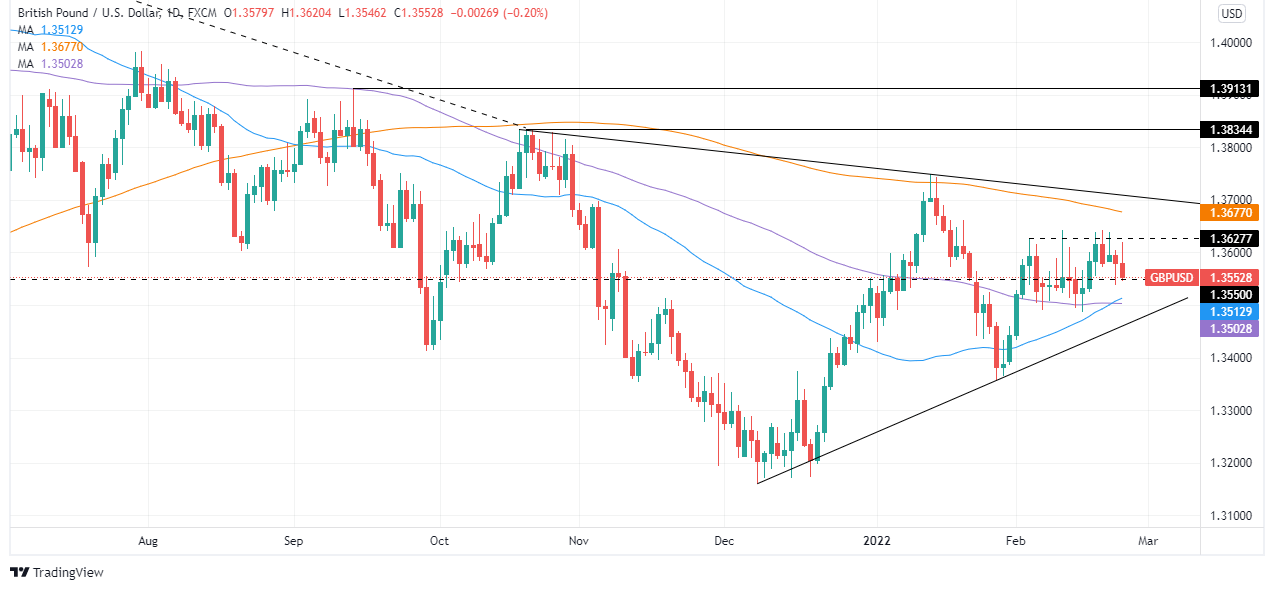
- The price has formed a weekly pennant and the rising wedge could be subject to a breakout.
- Russian invasion could occur within 48hrs according to the US, risk-off is hurting high beta currencies.
The Canadian dollar was trying to strengthen against its US counterpart on Wednesday as global financial markets started off calm in Asia. However, risk sentiment flipped on its head with investors waiting to see Russian President Vladimir Putin's next move after he sent troops into separatist regions of Ukraine.
The news fell in just after the opening on Wall Street that Ukraine had planned to declare a state of emergency after warnings from the US that Russia will invade within 48hrs. Further reports enhanced the risk-off moves that cited convoys of military equipment moving towards Donetsk in eastern Ukraine from the direction of the Russian Frontier.
Additionally, the price of oil has rallied on the news that the US will sanction the company building Russia's Nord Stream 2 pipeline. This leaves the outlook for CAD uncertain considering the high beta status it holds to global equities, commodity prices and specifically to oil:
-637812367521912757.png)
USD/CAD daily chart
From a technical perspective, the picture is no clearer given the price is stuck between a sideways daily channel as follows:
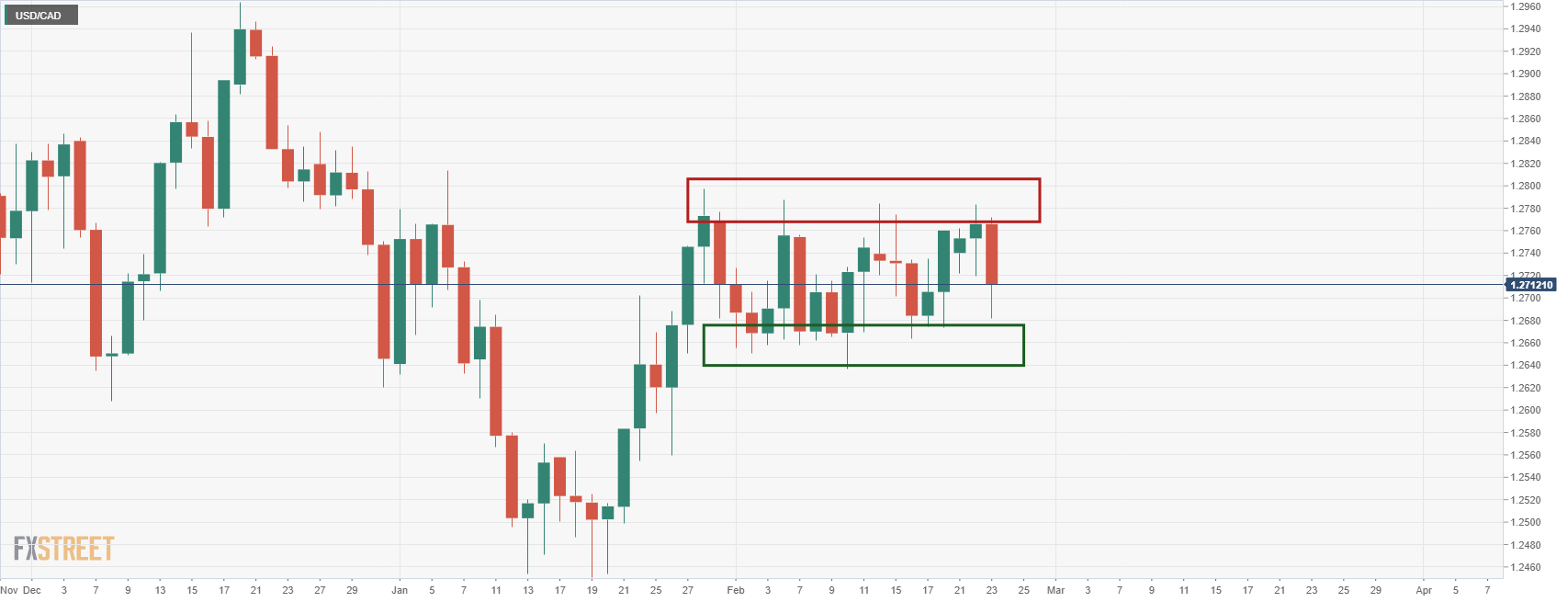
1.2640 is a key support level that guards a break of critical weekly structure.
USD/CAD weekly chart
However, the weekly chart may hold some clues:
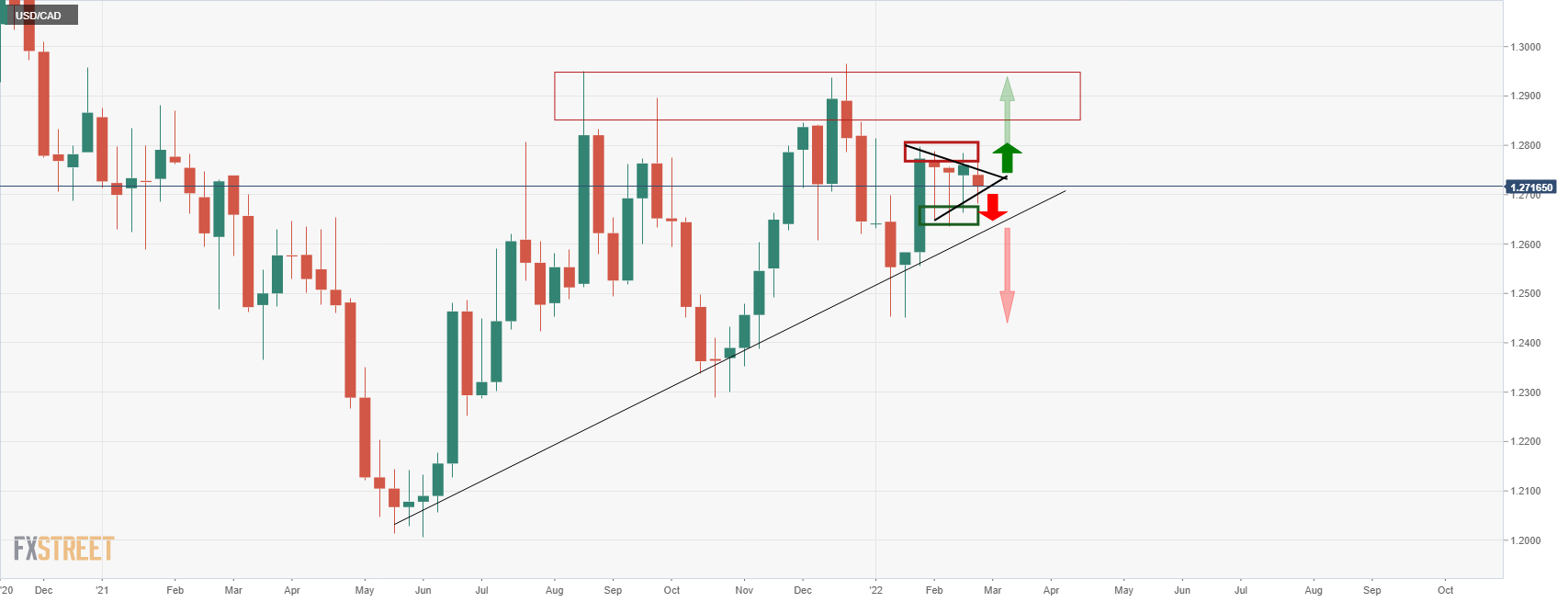
The price has formed a pennant and given the current trajectory to the upside, the bias would be for a bullish breakout. However, when scaling out, the broader trend is bearish and the rising wedge could be subject to a breakout to target as low as 1.23 the figure:
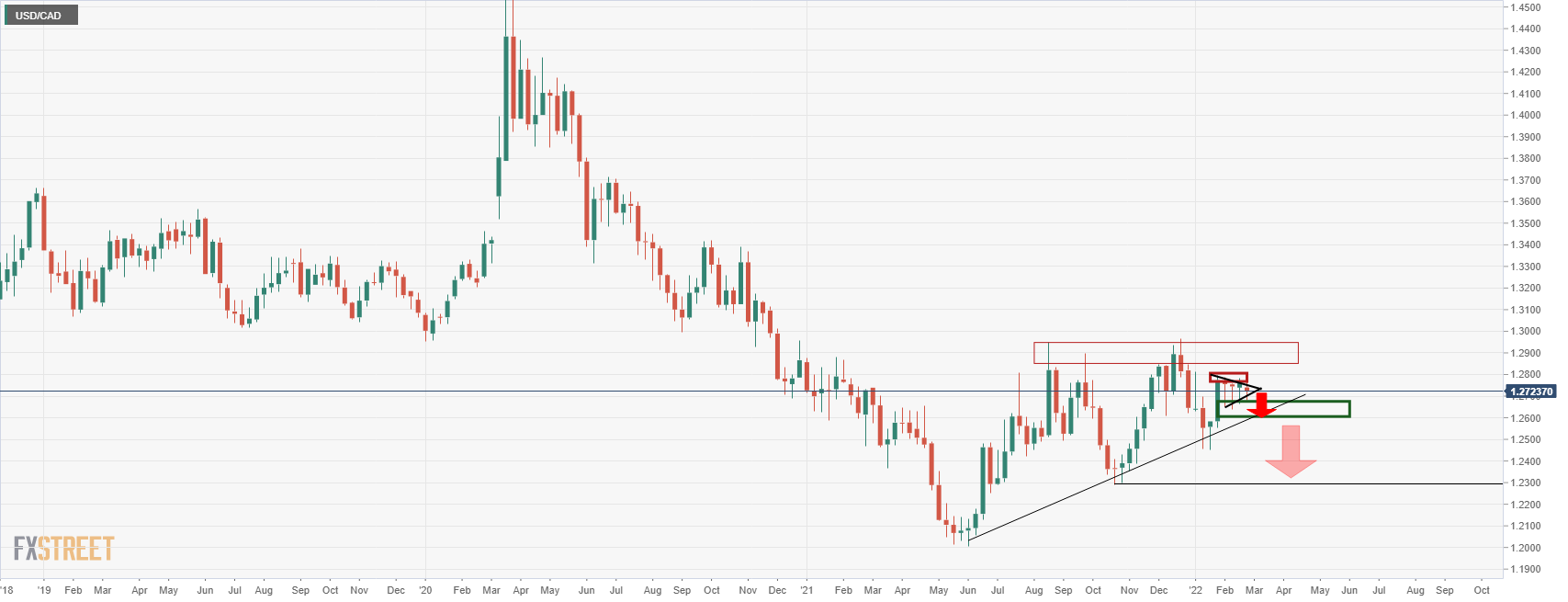
- The AUD/USD record gains during the week of 1.13%.
- Ukraine – Russia tussles dominate news headlines as tensions elevate.
- AUD/USD Technical Outlook: Under downward pressure as AUD/USD sellers probe 0.7240.
Benefitted from the Reserve Bank of New Zealand (RBNZ) 25 bps rate hike and its “hawkish” forward guidance, the AUD/USD climbs to fresh monthly highs, around 0.7280. However, a sudden swing in the market mood due to elevated tensions in Ukraine decreased appetite for risk-sensitive currencies like the AUD. At the time of writing, the AUD/USD is trading at 0.7243.
In the meantime, the US Dollar witnessed fresh flows into it, as the US Dollar Index, a gauge of the greenback’s value against a basket of its peers, edges up 0.10%, sitting at 96.12.
Ukraine – Russia crisis escalates
According to Sputnik, around 15:39 GMT, explosions were heard at the Donetsk airport. Meanwhile, Interfax reported that Ukrainian government websites are reportedly under cyberattack, including Ukrainian banks. It is worth noting that Ukraine declared a state of emergency on Wednesday of 30 days and urged citizens to flee Russia. At the same time, Russia closed its embassy in Ukraine and evacuated the staff.
That weighed on the AUD/USD pair, as depicted by the 40-pip drop from daily highs, but found support near the February 10 daily high at 0.7245, a crucial support level for AUD bulls in the event of extending the uptrend.
In the Asian session, the Australian economic docket featured the Wage Price Index (WPI) for Q4 of 2021. The headlines aligned with expectations at 0.7% q/q, while the year-over-year figure came at 2.3%, short of the 2.4 estimations. Analysts at ANZ said that “this WPI was not strong enough to make a June rate hike more certain than not.”
AUD/USD Price Forecast: Technical outlook
The AUD/USD retracement from Wednesday’s daily highs left a long up-wick depicted by the candle in the daily chart, indicating that traders’ book profits and sellers could have opened fresh short bets. A move below February 10 high at 0.7245 could exacerbate a move towards a three-month-old downslope support trendline, around the 0.7180-95 area, but first AUD/USD sellers would need a clear break below 0.7200.
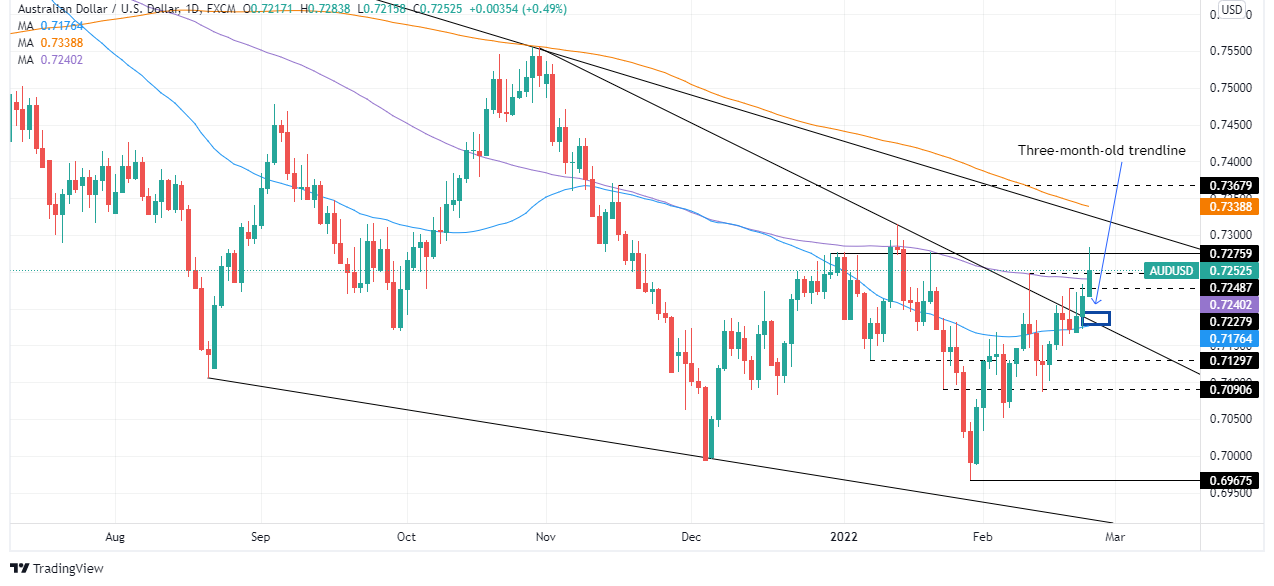
- Gold has been on the front foot in recent hours, pushing towards $1910 and eyeing weekly highs just above it.
- Following US warnings to Ukraine that a Russian invasion could come within 48 hours, market anxiety is elevated.
- The precious metal is thus finding demand amid a decent safe-haven bid.
Spot gold (XAU/USD) prices have been on the front foot in recent trade hours, rallying from earlier session lows in the $1890 area to current levels at highs of the day just below $1910 as geopolitical angst rises. At current levels, the precious metal trades with on-the-day gains of about 0.5% and is now eyeing a test of weekly highs $1914 area. Given recent reports that the US has warned Ukraine that a Russian invasion could come within 48 hours against the backdrop of recent positive technical momentum, a continued push higher seems odds on.
The immediate area of resistance to note beyond this week’s highs is the early June 2021 highs at $1916.60. A break above this level of resistance could open the door to a push on towards a double top from 2020/early 2021 in the $1960 area. Such moves would likely be contingent on further escalation on the geopolitical front, and if US intelligence is right about Russia’s plans to invade within 24 hours, that would fit the bill.
In this scenario, market participants would rush into safe-havens like gold amid uncertainty about how the Western sanction response against Russia would impact the global economy (inflationary disruptions to energy supplies?). Meanwhile, Russia taking control over Ukraine would bring conflict right onto NATO borders (Poland), raising the risk of direct military escalation between NATO and Russia. Russia also might feel emboldened to exert pressure on the Baltic NATO nations that border it further to the north, raising the risk of a NATO/Russia clash in another arena.
Amid such high stakes, XAU/USD price action will continue to trade as a function of geopolitical developments while Fed commentary and US data takes a back seat. One notable trend in recent days, however, has been markets paring back on Fed tightening expectations somewhat given elevated geopolitical uncertainty. This has also likely been helping gold.
European Central Bank governing council member and Bank of Spain head Pablo Hernandez de Cos said on Wednesday that the surge in Eurozone inflation is lasting longer than expected and is largely a result of energy. There are inflation risks to the upside and are most in the short-term, he added, adding that there is a higher likelihood that inflation remains at 2.0% in the medium-term. However, he said he sees no risk of inflation staying persistently above 2.0% and, given the uncertainty, the ECB must be adaptable and open to possibilities.
The ECB will not raise rates until its net bond buying has ended, de Cos noted, though we can't rule out the possibility that liftoff conditions will be met earlier than expected. The ECB is to decide upon its options, he continued, though gradualism is key. The current situation differs from the 1970 oil crisis, he noted.
Market Reaction
With markets much more focused on geopolitcs right now, de Cos's remarks have been largely ignored.
- Spot silver hit fresh monthly highs at $24.50 on Wednesday as fears rose of a Russian invasion of Ukraine.
- XAG/USD also broke above a key long-term downtrend, a bullish signal in the near-term.
Spot silver (XAG/USD) prices broke out to fresh monthly highs on Wednesday, surging beyond Tuesday’s highs in the $24.30 per troy ounce area to hit the $24.50 mark, boosted as fears of a Russian invasion into Ukraine rose. At current levels near highs of the day in the $24.40s, silver prices currently trade with on the day gains of nearly 1.5%, with the bulls now eyeing a test of annual highs printed back in mid-January in the $24.70s.
The latest upside, much of which has come since the US open on press reports that the US had warned Ukraine that a Russian invasion could begin within 48 hours, saw XAG/USD break above a key downtrend that has been capping the price action going all the way back to July 2021. If the bullish breakout can last (signified if silver holds and closes near $24.50), that would be a bullish sign in the near-term. Some short-term speculators might even target a test of the Q4 2021 highs just under $25.50.
Ukraine declared a state of emergency on Wednesday and urged citizens to flee Russia, while Russia is evacuating its diplomatic staff from Ukraine, all while ceasefire violations in the Donbas continue to accelerate. The drumbeat of war is clearly growing and this may help keep silver prices underpinned in the coming sessions. The US dollar has been pushing higher on a safe-haven bid in recent trade, which could undermine silver, but any such weakness is likely to be short-lived.
Data released on Wednesday showed Eurozone’s Inflation came in at 5.1% in January, on a yearly basis, according to Eurostat. Core figures rose by 2.3%, matching the 2.3% consensus forecasts. Analysts at Danske Bank revise their 2022 forecast for HICP (inflation) and core inflation to 4.7% and 2.4%, respectively, due to higher commodity and goods price inflation.
Key Quotes:
“The euro area recovery from the pandemic has been accompanied by protracted supply chain bottlenecks that have stifled activity, especially in the manufacturing sector. After supplier delivery times lengthened to unprecedented levels during 2021, there have been tentative signs of easing supply chain stress of late.”
“We now foresee HICP inflation in 2022 at 4.7% due to higher commodity and goods price inflation pressures and expect euro area core inflation to average 2.4% in 2022. Upside risks continue to stem particularly from a further escalation in the UkraineRussia tensions, that could send gas prices sharply higher. Stronger than expected commodities demand from a rebound in travelling activity and the Chinese cyclical recovery also pose upside risks in our view.”
- The USD/CHF leans towards 0.9175, the 200-DMA sparked by a swing in the market mood.
- USD/CHF Technical Outlook: Neutral-downwards after falling under 0.9200.
The USD/CHF retreats from a wall of resistance levels around the 0.9200 mark amid increasing tensions in Ukraine in the last hour, spurring a swing in market players’ sentiment. At the time of writing, the USD/CHF is trading at 0.9176.
Ukraine – Russia crisis escalates
Summarizing what happened in the last hour, around 15:39 GMT, explosions were heard at the Donetsk airport, according to Sputnik. Meanwhile, Interfax reported that Ukrainian government websites are reportedly under cyberattack, including Ukrainian banks.
That said, during the overnight session, the USD/CHF retreated from daily highs above the 0.9218 area, near the 200-hour simple moving average (SMA) at 0.9220 before the European session. The free-fall began once European traders got to their desks, pushing the pair towards the 200-day moving average (DMA) at 0.9175.
USD/CHF Price Forecast: Technical outlook
USD/CHF is neutral biased amid failure to hold the 0.9200 mark. The new trading range would be 0.9150-0.9200, as witnessed in the last three days, except for Wednesday, reaching a daily low at the abovementioned 200-DMA.
The USD/CHF path of least resistance in the short term is downwards. Breach of the 200-DMA would expose February 21 daily low at 0.9150. Once cleared, the next stop would be January 21 daily low at 0.9107, followed by the April 2021 lows at 0.9018.
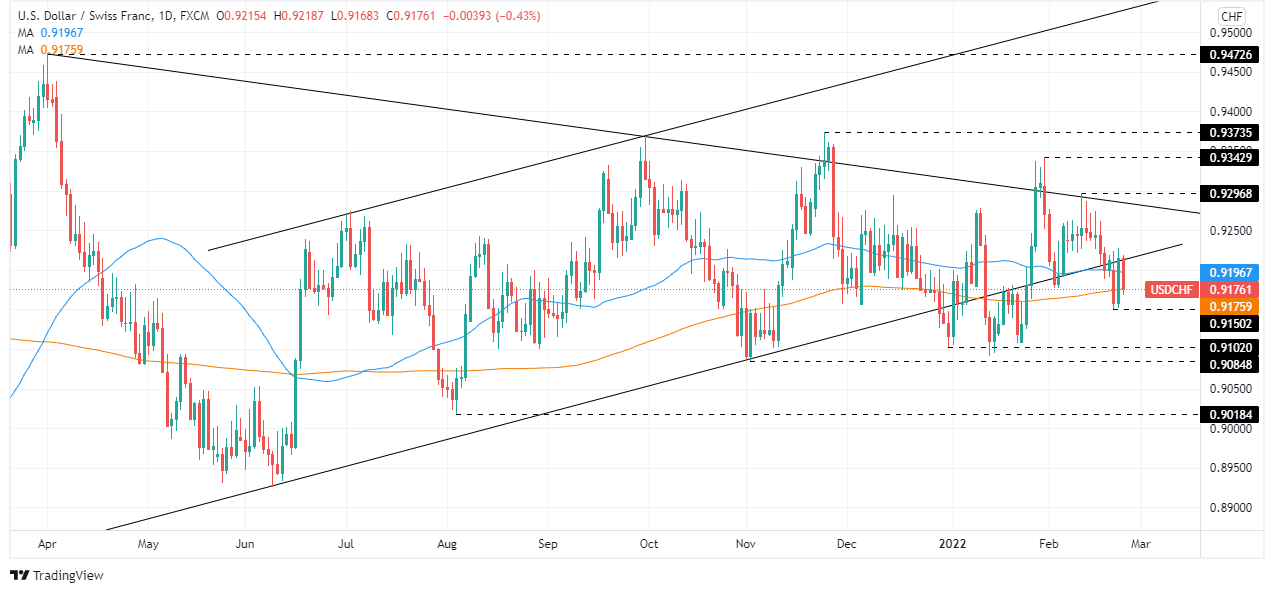
+
- A deterioration in market sentiment boosts the US dollar.
- EUR/USD remains in recent range, now with a bearish intraday bias.
The EUR/USD retreated further from the 1.1360 area and dropped to 1.1320, erasing daily gains. The move lower took place amid a deterioration in market sentiment that boosted safe-haven assets.
DXY turns positive, still in range
The US dollar gained momentum during the American session as US stocks indices turned negative. The Dow Jones is falling 0.17% and the Nasdaq drops 0.57% after opening in positive territory.
Headlines about the crisis in Ukraine sent equity markets lower. Ukraine announced a state of emergency starting at midnight for 30 days and after the US warned of a full-scale Russian invasion within 48 hours.
The DXY is now up 0.03% after holding in negative ground most of the day. The index is moving toward the upper limit of the current range. Like the DXY, the EUR/USD continues to move sideways in the short term around 1.1330.
A daily close below 1.1300 should point to further weakness while if it rises above 1.1400, the euro would gain strength.
Technical levels
- EUR/GBP pushed back above 0.8350 on Wednesday with risk appetite choppy on fears of a full-scale Russia invasion into Ukraine.
- More dovish-leaning commentary from BoE policymakers on Wednesday before the UK parliament TSC also hindered GBP’s cause.
Though trading conditions are calmer on Wednesday versus Tuesday’s choppiness, EUR/GBP continues to trade with an upside bias and recently pushed above the 0.8350 level, up a further 0.25% on the day following Tuesday’s 0.3% rise. The market’s broader appetite for risk remains choppy and Russia/Ukraine crisis headline-driven, with the latest reports that the US has warned Ukraine of Russian plans to launch an assault within 48 hours denting sentiment. Given GBP’s status as comparatively more risk-sensitive versus the euro, that suggests a continued upside bias to the pair on Wednesday and, perhaps, for the rest of the week, likely makes sense.
In that sense, bulls will likely be targeting weekly highs in the 0.8380s set on Tuesday and last week’s highs at 0.8400 just above it. The dovish leaning tone to BoE commentary, with policymakers, speaking before the UK parliament’s Treasury Select Committee (TSC), on Wednesday has further added support to EUR/GBP. Governor Andrew Bailey said he saw inflation risks as tilted to the upside though as still two-sided and cautioned investors against getting overly aggressive betting on future interest rate hikes.
Meanwhile, one BoE members who voted for a larger 50bps rate hike at this month’s policy meeting said the decision had been finely balanced, while another (who also voted for 50bps) said he now sees “modest” tightening over the coming months. Most recently, BoE’s Silvana Tenreyro was on the wires as well, and she also talked about a further “modest” tightening of policy. This might have supported EUR/GBP more was it not for the fact that traders have begun talking about how Russia/Ukraine uncertainty will likely lead the ECB to be a little more dovish/cautious at the upcoming March meeting.
Looking ahead to the rest of the week, central bank speak and economic data is likely to take a back seat to the theme of geopolitics in Eastern Europe. If US intelligence officials are right and Russia does mount a full-scale invasion within 48 hours, that would likely be the most important market event since the onset of the pandemic. The question for EUR/GBP would be whether it ought to shoot higher to reflect weaker risk appetite or lower to reflect Eurozone economic vulnerability given its reliance on Russian energy imports.
- The yellow-metal is so far up 2.06% in the week.
- The market mood is upbeat as players shrug off the US-imposed sanctions to Russia, perceived as mild.
- XAU/USD Technical Outlook: Gold buyers in charge above $1877, eyeing a daily close above $1900.
Gold is subdued on a choppy trading session, clinging to the $1,900 mark amongst an overall upbeat market mood, following a series of sanctions imposed by the US to Russia, which appeared to be measured, an excuse for investors to seek riskier assets. XAU/USD is trading at $1,907 at the time of writing.
Safe-haven assets felt the market sentiment swing, as shown by the US Dollar Index, falling 0.07%, sitting at 95.99. Nevertheless, the US 10-year Treasury yield uptick five basis points, sitting at 1.991%, putting a lid to the upward move by the non-yielding metal.
Update of the Ukraine – Russia crisis
In the meantime, Ukraine’s crisis headlines ease a tad. EU Ambassadors approved sanctions on Russia, and US Secretary Blinken said that the February 24 meeting with Russian Foreign Minister Lavrov makes no sense. Alongside sanctions imposed by the US, Canada, Australia, and Japan, added to the list of countries imposing bans to Russia.
Meanwhile, Reuters reported that Ukraine will introduce a state of emergency within all Ukraine regions, ex-Donetsk/Luhansk, for 30 days, and could be further extended for the same amount.
The US economic docket featured Tier-3 macroeconomic data, mainly ignored by market players.
XAU/USD Price Forecast: Technical outlook
During geopolitical conflicts, gold is one of the sought safe-havens by investors, meandering around the $1900 mark for the last five days. Worth noting that XAU/USD buyers pushed the yellow-metal price above Pitchfork’s uptrend channel while breaking a nine-month-old trendline in the process, leaving the last year’s November 16 daily high at $1877 a crucial support for XAU bulls to keep the upward bias.
That said, XAU/USD’s first resistance is $1900. A decisive break would expose June 1, 2021, a daily high at $1,916. Breach of the latter will expose January 2021 highs at $1,959, which once cleared could pave the way towards $2,000.
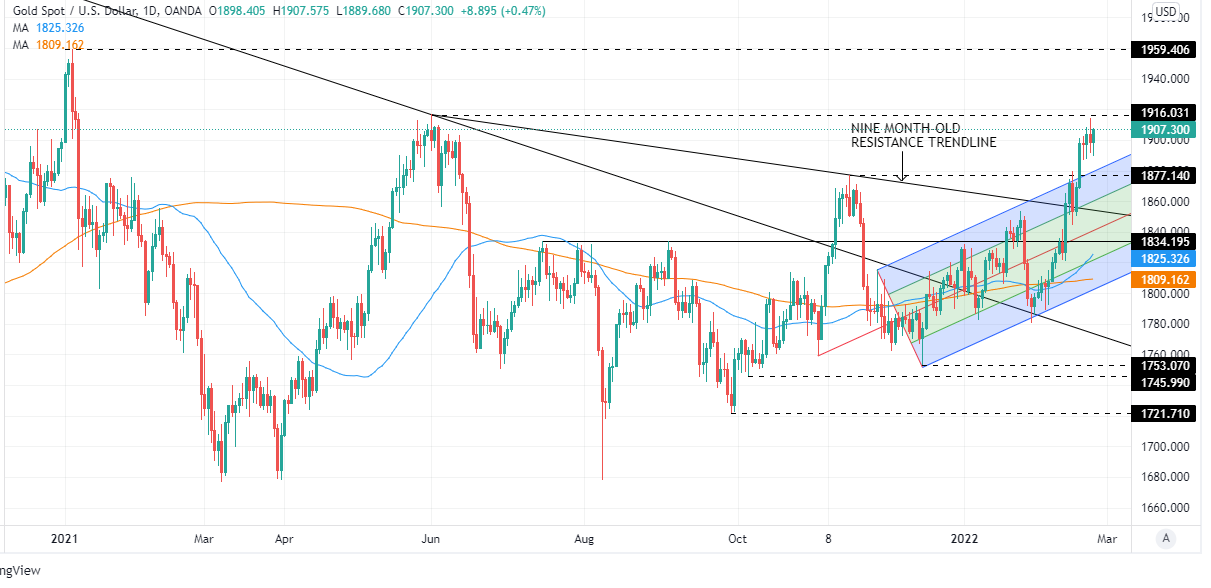
- USD/TRY moves higher and approaches the 13.90 region.
- The lira remains on the defensive despite the risk-on mood.
- Turkey 10y bond yields rose to 2-week highs past 21%.
The Turkish currency depreciates further and now sends USD/TRY back to the proximity of 13.90 on Wednesday.
USD/TRY up on geopolitical risks
USD/TRY approaches the area of YTD highs just below the 14.00 barrier as the Turkish currency remains on the back foot in response to rising geopolitical concerns and equally increasing uncertainty surrounding the conflict in Easter Ukraine.
The deterioration of the Russia-Ukraine scenario poses heightened risks to Turkey’s macro stability, while the prospects of higher crude oil prices in response to potential supply disruptions is also another factor weighing on the lira so far.
Further out, the proximity of the start of the Fed’s tightening cycle also puts the lira under extra scrutiny amidst the elevated levels of foreign debt held by domestic companies and lenders.
USD/TRY key levels
So far, the pair is advancing 0.44% at 13.8352 and a drop below 13.4317 (weekly low Feb.11) would expose 13.2327 (monthly low Feb.1) and finally 12.7523 (2022 low Jan.3). On the other hand, the next up barrier lines up at 13.9013 (monthly high Feb.22) seconded by 13.9319 (2022 high Jan.10) and then 18.2582 (all-time high Dec.20).
Bank of England policymaker Silvana Tenreyro said on Wednesday that further increases in energy costs and tradable goods prices are likely to imply a somewhat greater persistence in inflationary pressures, according to Reuters. A further modest tightening of monetary policy settings, she continued, would be consistent with inflation returning to the BoE's 2.0% target sustainably, she added, caveating that the exact scale of tightening required is uncertain.
Additional Remarks:
"The impact of the February rise in bank rate is more likely to have its peak impact when inflation is still above target than if we had waited too much longer."
"My policy decisions will seek to manage any temporary trade-offs that arise between inflation and the volatility of output."
"With the inflation pick-up from higher tradeable goods price inflation now set to be larger and likely more persistent than previously expected, I thought an earlier tightening would strike a better balance."
"The associated fall in real income is also likely to weigh on demand, independently of the policy stance."
Market Reaction
GBP has not reacted to commentary from Tenreyro but is instead weakening in line with a downturn in risk appetite after Newsweek reported that the US has warned Ukraine of a Russian plan to invade in the next 48 hours.
According to US intelligence sources speaking to Newsweek, the US has informed Ukraine of a Russian plan to invade with 48 hours. An intelligence official told Newsweek that the US had informed Ukrainian President Volodymyr Zelenskyy that the Russian plan would involve airstrikes, cruise missiles, ground troops and cyber attacks.
NZD/USD has pushed above some key resistance levels at 0.6718/32. Next key resistance is seen at 0.6873/91, which it is expected to cap, according to analysts at Credit Suisse.
Further consolidation is likely
“We shift our stance in favor of a lengthier consolidation phase, with resistance for further recovery seen at the December highs as well as the 50% retracement of the October 2021-January 2022 fall at 0.6855/6873, which we would look to try to cap at first.”
“Were 0.6855/6873 to break, the YTD high at 0.6891 is expected to serve as a more solid barrier. Above here would signal a challenge of the falling 200-day moving average at 0.6949, however, this is not our base case for now.”
“On the flip side, a close below 0.6732/18 and a fall back below the recent lows at 0.6678 would relieve the recent upward pressure. Only below 0.6601/6589 would reassert the still intact medium-term downtrend though.”
The S&P 500 is on course to retest the 4223/4199 key support cluster. The risk for a break below here is seen rising sharply, which would open up further losses towards 3855/15, analysts at Credit Suisse report.
Weekly RSI holds a major top
“We maintain our negative outlook for a retest of a cluster of supports at 4223/4199. Although a fresh hold here should be allowed for, downside risks are seen increasing and with weekly RSI momentum maintaining a large top we are now biased to a break lower.”
“Below 4199 on a weekly closing basis would complete a large ‘head & shoulders’ top to warn of a further fall to the 38.2% retracement of the entire 2020/2021 bull trend at 3855/15.”
“A close above 4595 remains needed to ease the threat of a top.”
AUD/USD has broken above a key resistance zone at 0.7186/7213. Further upside is likely toward 0.7315/40, which is the key 200-day moving average (DMA) and 2022 high, but analysts at Credit Suisse expect this zone to cap for further consolidation.
Signs of further strength
“We see immediate resistance at the December 2020 highs at 0.7275/77 and then further above at the YTD highs at 0.7315, which should hold the recovery for now. With the falling 200-DMA just above at 0.7340/42, we would look for a cap here to define the top end of the range.”
“A move back below the October downtrend and recent lows at 0.7171/64 would quickly reassert the core bearish trend, with next supports seen at 0.7099/84, then 0.7063/49 and eventually the YTD lows at 0.6972/62.”
EUR/USD continues to pivot in a tight range between 1.13-1.14. In the view of economists at Scotiabank, the European Central Bank's (ECB) slow pace of normalization could drag the pair down to the 1.10 level.
Long-run oscillators remain bearish
“Short and medium-term trend oscillators are flat – suggesting a continuation of the choppy range trade for now. Longer-run oscillators remain bearish, however, and we think this continue to imply resistance to EUR gains above 1.14 and very firm resistance at 1.15 in the weeks ahead.”
“We think the ECB’s slow course towards monetary policy normalization leaves the EUR prone to softness in the medium-term (and continue to target a year-end rate of 1.10 versus the USD).”
- WTI is trading more calmly on Wednesday and is currently roughly flat in the $92.00 area awaiting fresh geopolitical developments.
- As geopolitical risk premia remains elevated, oil is likely to remain a buy on dips.
- A possible US/Iran nuclear deal, which would free up 1.3M BPD in exports, is a downside risk traders should note.
After Tuesday’s choppy session which saw front-month WTI futures print fresh seven-year highs at $96.00 per barrel before swinging lower again, oil markets are experiencing calmer conditions on Wednesday. WTI is currently trading towards the top of mid-$90 to mid-$92.00 intra-day ranges near the $92.00 mark, where it is broadly flat on the day. Wednesday’s roughly $2.0 intra-day range compares to Tuesday’s intra-day range of more than $5.50.
Crude oil markets are continuing to monitor developments regarding the Ukraine crisis as fears about a full-scale Russian invasion of Ukraine remain elevated and Western nations hit Russia with sanctions over its recognition of the independence of breakaway Ukrainian regions. These sanctions have so far been focused on targeting Russian banks and wealthy individuals, with US President Joe Biden on Tuesday making it clear that the US wasn’t yet to target Russian commodity exports.
The geopolitical impetus for WTI to push above $96.00 and on towards $100, thus, is not yet there. But US officials have signalled that if Russia takes further aggressive action against Ukraine all options for further sanctions are on the table and this is a key risk oil traders will be monitoring in the coming days. “The prospect of more conflict in Ukraine should safeguard the geopolitical risk premium,” said one commodity analyst, whilst another warned that “There is a risk that Russia will retaliate to the sanctions by reducing deliveries of its own accord”.
Thus, for now, it seems likely that dips back towards $90.00 will continue to be bought, as has been the case over the past two or so weeks. Eyes will be on a meeting of the UN General Assembly on Ukraine later in the day, which should generate fresh geopolitical headlines, as well as US weekly oil inventory data from the American Petroleum Institute at 2130GMT.
Another theme at the top of oil traders’ minds is the prospect of a US/Iran nuclear deal. A deal would pave the way for the US to lift sanctions on Iranian crude oil exports. According to ING, would ease concerns over OPEC+ spare capacity (or lack thereof). The bank said “Iran is currently producing at around 2.5mln BPD but is estimated to have a capacity of closer to 3.8mln BPD, therefore, over time there is the potential for 1.3mln BPD of additional supply to come onto the market”. “Nuclear talks in Vienna are reaching a sensitive and important point” said Iran's foreign minister on Wednesday.
The New Zealand dollar is the best performing G10 currency on a one-day view after the messages of the Reserve Bank of New Zealand (RBNZ) in today’s policy meeting went beyond what the market had been expecting. This should cement a move higher towards 0.71 though NZD/USD may struggle to reach it if geopolitical tensions continue to remain the dominant theme, economists at Rabobank report.
Upping the ante
“The RBNZ hiked rates by 25 bp for a third consecutive meeting, in line with the Bloomberg survey of economists. That said, the committee made clear that the decision to announce a 25 bps rate hike rather than a 50 bps move had been finely balanced for many members. In addition to the rate hike, the RBNZ also announced that it would commence the gradual reduction of the Bank’s bond holdings.”
“Although we are forecasting a move higher towards NZD/USD 0.71 on a three-month view, this could be thrown off kilter if geopolitical news worsens and the safe-haven USD finds additional support.”
“In view of the far more cautious tone of the RBA, we do see scope for AUD/NZD to move lower. Our three-month AUD/NZD forecast stands at 1.03.”
- EUR/USD adds to Tuesday’s advance near 1.1360.
- Further upside needs to clear the 1.1360 region.
EUR/USD extends the weekly rebound and revisits the 1.1360 zone on Wednesday.
Extra gains in the pair needs to surpass the 5-month line around 1.1360 to mitigate downside pressure and allow for a probable test of the weekly high at 1.1395 (February 14). Further up is seen the 200-week SMA at 1.1487 closely followed by the 2022 peak at 1.1494 (February 10).
In the longer run, EUR/USD is expected to keep the negative outlook as long as it trades below the key 200-day SMA, today at 1.1628.
EUR/USD daily chart

- USD/CAD came under intense selling pressure on Wednesday and dived to a fresh weekly low.
- The risk-on impulse weighed on the safe-haven USD and exerted downward pressure on the pair.
- Bulls seemed rather unimpressed by softer crude oil prices, which tend to undermine the loonie.
The USD/CAD pair continued losing ground through the early North American session and dropped to a fresh weekly low, around the 1.2680 region in the last hour.
Having faced rejection near the 1.2780-1.2785 supply zone, the USD/CAD pair witnessed aggressive long-unwinding trade on Wednesday amid renewed US dollar selling bias. The fact that new economic sanctions on Russia were not as bad as feared helped ease the nervousness about the situation in Ukraine and boosted investors' confidence. This was evident from a generally positive tone around the equity markets, which, in turn, weighed on the safe-haven greenback.
That said, a fresh leg up in the US Treasury bond yields should act as a tailwind for the greenback. Apart from this, modest downtick in crude oil prices could undermine the commodity-linked loonie and help limit any further losses for the USD/CAD pair, at least for now. The fundamental backdrop supports prospects for the emergence of dip-buying around the USD/CAD pair and warrants some caution for bearish traders amid absent relevant market moving economic releases.
From a technical perspective, the good two-way price moves witnessed over the past four weeks or so points to indecision among traders over the next leg of a directional move for the USD/CAD pair. Moreover, repeated failures near the said trading range hurdle make it prudent to wait for some follow-through buying before positioning for any meaningful upside. Nevertheless, any subsequent decline is more likely to find decent support near the 1.2655-1.2650 region.
Technical levels to watch
- AUD/USD hit its highest levels since mid-January on Wednesday in the 0.7275 area as risk appetite picked up.
- AUD was only very briefly undermined by weak WPI data, which saw some traders pare back their RBA tightening bets.
AUD/USD surged to its highest level since mid-January in the 0.7275 area on Wednesday amid a broad pick-up in macro risk appetite, with market participants taking the view that US sanctions against Russia announced on Tuesday weren’t quite as harsh as feared. The Aussie, which has been getting tailwinds from buoyant equity markets (S&P 500 futures are up nearly 1.0% in pre-market trade), is now up about 0.8% on the session versus the buck. The brief dip that saw the pair fall to session lows in the 0.7220 area during the Asia Pacific session in wake of softer than expected Australia Q4 Wage Price Index (WPI) data is now well in the rear-view mirror.
AUD/USD is also likely getting a lift from its close correlation to its antipodean counterpart – NZD/USD is up more than 1.0% on the session following Wednesday’s more hawkish than anticipated rate guidance from the RBNZ on Wednesday. The Aussie’s outperformance on Wednesday (it sits in second place in the G10 performance table after NZD) comes despite traders paring back on their RBA tightening bets in wake of the latest WPI figures. The YoY rate of WPI came in at 2.3%, below the expected 2.4%.
“Today's figures support the view that it may take some time to lift wages growth such that the 'norm' becomes a wage rise of 3-4%, rather than the 2% of recent year” said analysts at HSBC. “The RBA is seeking to run the economy hot for a while to try to reset these wage settings norms” they added. But AUD/USD has been undeterred and looks intent on testing earlier annual highs just to the north of the 0.7300 level. One risk to this would be if the Ukraine crisis further escalates, triggering a USD/safe-haven FX bid, potentially sending the pair back towards 0.7200.
- USD/JPY witnessed subdued/range-bound price moves through the early North American session.
- The risk-on mood undermined the safe-haven JPY and acted as a tailwind amid rising US bond yields.
- The emergence of fresh USD selling failed to impress bullish traders or provide impetus to the major.
The USD/JPY pair extended its sideways price move through the early North American session and was last seen trading with modest intraday gains, just above the 115.00 psychological mark.
The pair struggled to capitalize on the previous day's goodish rebound from mid-114.00s, or a two-and-half-week low and witnessed subdued/range-bound trading on Wednesday. Renewed US dollar selling bias held back traders from placing bullish bets, though a combination of factors helped limit the downside for the USD/JPY pair.
As investors digest the recent developments surrounding the Russia-Ukraine saga, a generally positive tone around the equity markets undermined the Japanese yen's safe-haven status. Apart from this, a fresh leg up in the US Treasury bond yields further inspired bullish traders and extended some support to the USD/JPY pair.
The fundamental backdrop supports prospects for further gains. That said, the risk of an imminent Russian invasion of Ukraine warrants some caution. Hence, it will be prudent to wait for some follow-through buying before confirming that the pullback from the vicinity of the multi-year high, around the 116.35 area, has run its course.
There isn't any major market-moving economic data due for release from the US, suggesting that the focus will remain glued to fresh geopolitical developments. Apart from this, traders will take cues from the broader market risk sentiment and the US bond yields to grab some short-term opportunities around the USD/JPY pair.
Technical levels to watch
- DXY extends Tuesday’s bearish move to the 95.80 region.
- Further consolidation seems the name of the game for DXY.
DXY adds to the recent weakness although it remains largely within the prevailing consolidation theme.
That said, occasional bullish attempts remain so far capped by last week’s top at 96.43 (February 14), while the 95.70 area is expected to hold the downside for the time being.
The short-term constructive stance remains supported by the 5-month line, today near 95.40, while the outlook for the dollar is seen as positive above the 200-day SMA at 93.82 in the longer run.
DXY daily chart
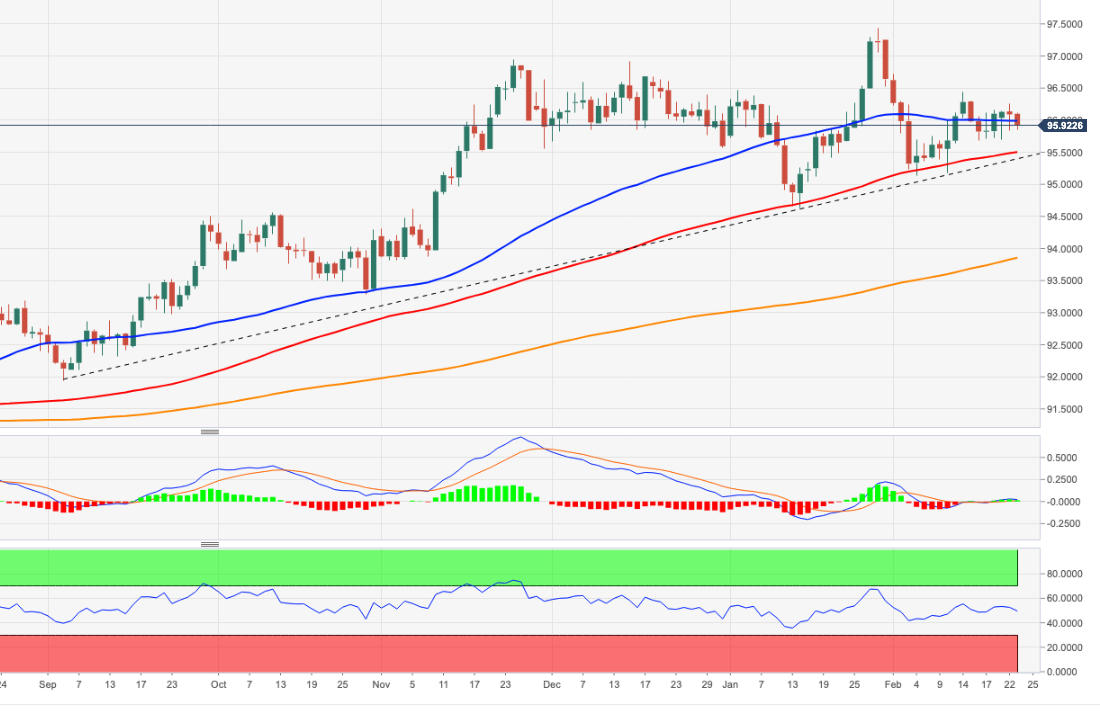
The core trend for gold looks in the process of turning higher again, in the view of strategists at Credit Suisse. A break past $1,917/23 would open up further gains towards the $2,075 record high.
Initial support align at $1,845
“Gold has seen a weekly close above the $1,877 high of November and the spotlight turns to the June 2021 high and retracement resistance at $1,917/23. Above here should add momentum to the rally to confirm a base has indeed been established to raise the prospect of a move back to the $2,075 record high.
“Support is seen moving to $1,845 initially, then more importantly at the 200-day average at $1,809.”
- GBP/USD has pulled back under 1.3600 again from earlier highs in the 1.3620s amid dovish BoE vibes.
- The pair continues to trade a little higher on the day with the dollar weaker amid a broadly risk-on market mood.
Dovish-leaning commentary from BoE officials speaking before the UK Parliament’s Treasury Select Committee on Wednesday seems to have weighed on GBP/USD a touch on Wednesday, as focus remains primarily on the Russia/Ukraine crisis. The pair has pulled back to around the 1.3600 level from earlier session highs in the 1.3620 area and continue to trade about 0.1% higher on the day, boosted by a slightly weaker US dollar amid better risk appetite.
Market commentators said that the sanctions announced by the US against Russia on Tuesday weren’t as harsh as feared, facilitating the broad rebound in risk assets and selling pressure on safe havens. Market commentators did also note that US officials also committed to implementing further sanctions on Russia if needed.
Regarding commentary from BoE policymakers on Wednesday, analysts said the general tone was aimed at cooling BoE tightening bets. Firstly, Governor Andrew Bailey said he saw inflation risks as tilted to the upside though still two-sided and cautioned investors against getting overly aggressive betting on future interest rate hikes. Meanwhile, one BoE members who voted for a larger 50bps rate hike at this month’s policy meeting said the decision had been finely balanced, while another (who also voted for 50bps) said he now sees “modest” tightening over the coming months.
Analysts at Monex Europe said that “BoE communications since February's meeting have largely taken aim at cooling market-implied policy rates”. Another analyst at CIBC said that the market-implied pace of tightening this year (144bps) was too aggressive. Perhaps, then, given the dovish BoE vibes on Wednesday, it isn’t too surprising to see GBP underperform in the G10 space (only safe-haven currencies USD and JPY are doing worse). For now, as markets await more certainty on the geopolitical front, GBP/USD may continue to undulate within recent 1.3550-1.3650ish ranges.
- A combination of supporting factors pushed NZD/USD to over a one-month high on Wednesday.
- A more hawkish RBNZ stance, the risk-on mood provided strong lift to the perceived riskier kiwi.
- Modest USD weakness remained supportive of the move, though overbought RSI might cap gains.
The NZD/USD pair maintained its strong bid tone heading into the North American session and was last seen trading just below the 0.6800 mark, or over a one-month high.
The pair gained strong positive traction on Wednesday after
the Reserve Bank of New Zealand (RBNZ) hiked interest rates, as expected, and indicated that more tightening could be necessary. In the accompanying policy statement, the RBNZ noted that the decision between a 25bp and 50bp hike was finely balanced and also increased the official cash rate (OCR) peak forecast.
In fact, New Zealand's central bank projected that the cash rate would reach 2.2% by the end of 2022 and 3.35% in the last quarter of 2023, 0.75% higher than its November forecast of 2.6%. This, along with the risk-on impulse in the markets, provided a goodish lift to the perceived riskier kiwi and pushed the NZD/USD pair higher for the seventh successive day.
The intraday positive momentum seemed unaffected by the risk of an imminent Russian invasion of Ukraine, instead took cues from the emergence of fresh US dollar selling. The upbeat mood around the global equity markets undermined the safe-haven greenback, which, so far, has failed to draw any support from a fresh leg up in the US Treasury bond yields.
Apart from the aforementioned factors, sustained strength beyond the previous monthly high, around the 0.6730-0.6735 region, prompted technical buying and contributed to the strong bid tone. It, however, remains to be seen if bulls are able to capitalize on the move or opt to take some profits off the table amid slightly overbought RSI (14) on hourly charts.
There isn't any major market-moving economic data due for release from the US, though developments surrounding the Russia-Ukraine saga might influence the USD price dynamics. Traders will further take cues from the broader market risk sentiment to grab some short-term opportunities around the NZD/USD pair.
Technical levels to watch
- EUR/JPY reclaims the area above the 130.00 mark.
- The cross needs to leave behind the 200-day SMA at 130.38.
EUR/JPY extends the rebound from weekly lows near 129.30 (February 22) and regains the 130.00 barrier and beyond on Wednesday.
Further recovery in EUR/JPY now faces the next resistance of note at the weekly high at 131.90 (February 16), which is regarded as the last defence for a potential move to the 2022 peak at 133.15 (February 10).
While above the 2-month line, today around 128.80, further upside in the cross should remain on the table in the very near term. On the longer term, the outlook for the cross is seen as constructive while above the 200-day SMA, today at 130.38.
EUR/JPY daily chart
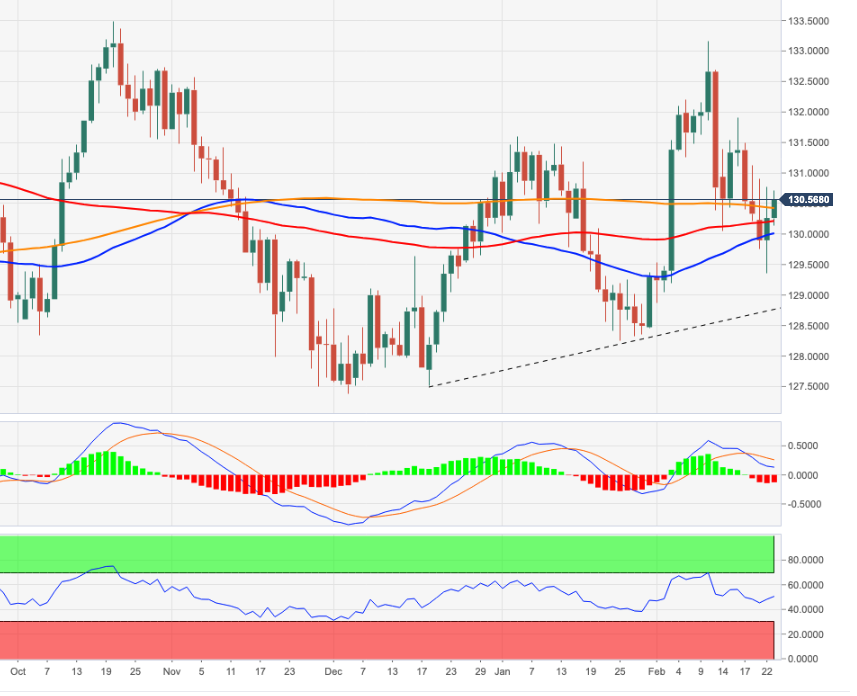
UK PM Boris Johnson on Wednesday announced that the UK would be stopping Russian companies from clearing in GBP or USD in UK markets, according to Reuters. Johnson added that the UK will shortly be providing further military support to Ukraine in the form of lethal defensive weapons. Unity on sanctions is vital, Johnson emphasised.
The UK PM also said that he had asked his culture minister to ask media regulators to review Russia Today's broadcast license. Recent press reports suggest that the UK culture minister has subsequently asked UK media regulators to take"timely and transparent" action against the Russia state-owned broadcaster, amid concern its may seek to spread "harmful disinformation".
Market Reaction
Markets have not reacted to the latest announcements from UK PM Boris Johnson.
- Silver continued with its struggle to break through a confluence barrier near the $24.30-$24.35 area.
- The technical set-up favours bullish traders and supports prospects for additional near-term gains.
- A convincing break below an upward sloping channel is needed to negate the constructive outlook.
Silver seesawed between tepid gains/minor losses through the mid-European session and was last seen trading in the neutral territory, just above the $24.00 round-figure mark.
Looking at the broader picture, the recent positive move stalled near a confluence hurdle, around the $24.30-$24.35 region, or a near one-month high set in the previous day. The said barrier comprises a technically significant 200-day SMA and a downward sloping trend-line extending from July 2021.
Given that the strong move up witnessed since the beginning of this month has been along an upward sloping channel, the bias seems tilted in favour of bullish traders. The positive outlook is reinforced by bullish oscillators on the daily chart, which are still far from being in the overbought zone.
The technical setup supports prospects for an eventual breakout through the aforementioned confluence resistance and a move towards testing the top end of the ascending channel. The latter, currently pegged near the $24.60-$24.70 area, coincides with the 2022 high and should act as a pivotal point.
Sustained strength beyond will be seen as a fresh trigger for bullish traders and pave the way for a further near-term appreciating move. The XAG/USD might then surpass the key $25.00 psychological mark and accelerate the momentum towards November 2021 swing high, around the $25.40 region.
On the flip side, the trend-channel support, around the $23.85-$23.80 region should protect the immediate downside. A subsequent decline below the $23.70 support might shift the near-term bias in favour of bearish traders and pave the way for a meaningful corrective slide for the XAG/USD.
The next relevant support is pegged near the $23.35-$23.30 region before the XAG/USD slides further to the $23.00 round-figure mark. The downward trajectory could further get extended and drag the white metal towards the $22.65 horizontal support.
Silver daily chart
-637812141489030856.png)
Technical levels to watch
UOB Group’s Head of Research Suan Teck Kin, CFA, and Economist Lee Sue Ann comment on the probable effects of the ongoing geopolitical effervescence in the Russia-Ukraine conflict.
Key Takeaways
“Brewing tensions between Russia and Ukraine have escalated rapidly. This comes after Russian President Vladimir Putin, on Mon (21 Feb), ordered troops into two breakaway regions of eastern Ukraine after announcing that he would recognize their independence. The White House has responded by levying a number of sanctions on the region.”
“The Russian economy ranks outside of the top 10 in the world. And while it is known for its exports of oil and gas and other resources, its trade volume is relatively small compared to the countries of the same size. Russia has also been making defensive moves to minimize damages from financial sanctions, especially after the round imposed in Mar 2014 following the conflict over Crimea.”
“Nonetheless, the situation remains very fluid, and this has kept the world watching and waiting to see what Putin will do next and how the US and Europe will be responding. As it is, the latest news has fueled the return of investor demands for traditional safe havens like gold, US Treasuries, JPY and CHF.”
European Central Bank (ECB) policymaker Bostjan Vasle said on Wednesday that the time was right for them to move the ECB's monetary policy out of the crisis mode and start the process of gradual normalisation, as reported by Reuters.
"With the return of economic activity to the pre-crisis level, looming labour shortages and in part structural pressures on energy prices, our monetary policy needs to start rebuilding its space to be ready to respond to the next business cycle," Vasle explained.
Market reaction
The EUR/USD pair showed no immediate reaction to these remarks and was last seen trading in the positive territory near 1.1350.
Economist at UOB Group Barnabas Gan assesses the outlook for the Thai economy in the current year.
Key Takeaways
“GDP expanded 1.9% y/y (+1.8% q/q sa) in 4Q21, surprising market estimates for a milder growth of 0.8% y/y (+1.5% q/q sa). The latest data came on the heels of a revised 0.2% y/y contraction in 3Q21. Accounting for the latest print, Thailand’s economy grew 1.6% for the whole of 2021.”
“Government expenditure (+8.1% y/y) was the key driver for growth, while private consumption (+0.3% y/y) and gross fixed capital formation (GFCF, -0.2% y/y) disappointed. Meanwhile, trade surplus narrowed to THB14.4bn in 4Q21 (from THB57.6bn in 3Q21) as imports surged 16.2% y/y.”
“While we acknowledge that Thailand’s GDP has indeed surpassed expectations, we remain cautious over its growth momentum in 2022.”
“We maintain our 2022 GDP growth outlook at 3.5%. This is against official range outlook of between 3.5% - 4.5%. Officials have also upgraded their 2022 inflation outlook to 1.5% - 2.5%, from 0.9% -1.9%.”
"We are likely to need some further tightening in policy but not an inexorable rise," Bank of England (BOE) Deputy Governor Ben Broadbent told the Parliament's Treasury Committee on Wednesday, as reported by Reuters.
"I do not think interest rates will get back to level when the Monetary Policy Committee started in 1997," Broadbent added. "The pandemic has not done anything to change my view about long-term factors pushing down on interest rates."
Market reaction
The GBP/USD pair showed no immediate reaction to these comments and was last seen rising 0.2% on the day at 1.3610.
- USD/CHF lacked any firm directional bias and remained confined in a range on Wednesday.
- The risk-on impulse in the markets undermined the safe-haven CHF and extended support.
- The emergence of fresh USD selling acted as a headwind and capped the upside for the pair.
The USD/CHF pair seesawed between tepid gains/minor losses through the first half of the European session and was last seen trading in the neutral territory, just above the 0.9200 mark.
A combination of diverging forces failed to assist the USD/CHF pair to capitalize on the overnight solid rebound from the monthly low, around mid-0.9100s and led to subdued price action on Wednesday. A positive risk tone undermined the Swiss franc's safe-haven status and extended some support. That said, the emergence of fresh US dollar selling acted as a headwind and capped the upside for the major, at least for the time being.
The nervousness over the worsening situation in Ukraine eased after a Kremlin spokesperson said on Tuesday that Russia is still open to diplomacy and has an interest in that. Apart from this, the fact that new economic sanctions on Russia were not as bad as feared further boosted investors' confidence and triggered a fresh wave of the risk-on trade. This was evident from strong performance across the global equity markets.
The upside, however, remains capped amid modest USD weakness, which, so far, has failed to draw support from a fresh leg up in the US Treasury bond yields. Apart from this, the risk of an imminent Russian invasion of Ukraine held back bullish traders from placing aggressive bets around the USD/CHF pair. This, in turn, warrants caution before positioning for any further appreciating move amid absent relevant economic releases.
Technical levels to watch
- EUR/USD extends Tuesday’s gains to the mid-1.1300s.
- Germany GfK Consumer Confidence worsened to -8.1 in March.
- ECB’s Holtzmann opened the door to a summer rate hike.
The European currency extends the recent optimism and lifts EUR/USD to the 1.1350 region midweek.
EUR/USD bolstered by risk appetite
The appetite for riskier assets remains well and sound among market participants and sustains the move higher in EUR/USD for the second session in a row on Wednesday.
The bid bias in the euro, in the meantime, looks underpinned by another uptick in yields of the German 10y Bund, this time retesting the vicinity of the 0.27% zone and following the equally decent improvement in the rest of yields in the global cash markets.
The pair also derived further strength from hawkish comments by ECB’s Board member R.Holtzmann, who did not rule out hiking rates before the current bond-buying programme finishes. He suggested a rate rise by the summer and another potential one towards end of the year.
Earlier in the session, Germany’s Consumer Confidence measured by GfK dropped to -8.1 for the month of March (from -6.7) and final inflation figures in the broader Euroland showed the headline CPI rose 5.1% YoY in January and 2.3% when it comes to the Core CPI.
What to look for around EUR
EUR/USD continues to look to the geopolitical scenario and the risk appetite trends for near-term direction. On this, further deterioration of the Russia-Ukraine front should keep the pair under pressure via a stronger dollar, although the ongoing bounce in the appetite for riskier assets remains supportive of further recovery. In the meantime, the improvement in the pair’s outlook appears underpinned by fresh speculation of a potential interest rate hike by the ECB probably sooner than many anticipate, higher German yields, persevering elevated inflation and a decent pace of the economic activity and other key fundamentals in the region. The threat to this view, as usual, comes from the Fed and a potential tighter-than-expected start of the normalization of its monetary conditions.
Key events in the euro area this week: Germany GfK Consumer Confidence, EMU Final January CPI (Wednesday) – Eurogroup Meeting, Germany Final Q4 GDP, EMU Final Consumer Confidence, ECB Lagarde (Friday).
Eminent issues on the back boiler: Asymmetric economic recovery post-pandemic in the euro area. Speculation of ECB tightening/tapering later in the year. Presidential elections in France in April. Geopolitical concerns from the Russia-Ukraine conflict.
EUR/USD levels to watch
So far, spot is gaining 0.25% at 1.1350 and faces the next up barrier at 1.1395 (weekly high Feb.16) followed by 1.1487 (200-week SMA) and finally 1.1494 (2022 high Feb.10). On the other hand, a drop below 1.1287 (weekly low Feb.22) would target 1.1279 (weekly low Feb.14) en route to 1.1186 (monthly low Nov.24 2021).
- Eurozone inflation arrives at 5.1% YoY in January.
- Monthly CPI in the bloc rises by 0.3% in January.
- EUR/USD remains unfazed around 1.1350 on the EZ data.
Eurozone’s Inflation came in at 5.1% in January, on a yearly basis, according to Eurostat’s final reading of the Eurozone CPI report for the month. The reading was in line with the estimates of 5.1% and 5.1% previous. Core figures rose by 2.3%, matching the 2.3% consensus forecasts.
When compared to December, the bloc’s CPI rose by 0.3% versus 0.3% expected and 0.4% in seen the previous month while the core CPI numbers also came in at -0.9% versus -0.8% expected and -0.8% last.
Key details (via Eurostat):
“The lowest annual rates were registered in France (3.3%), Portugal (3.4%) and Sweden (3.9%). The highest annual rates were recorded in Lithuania (12.3%), Estonia (11.0%) and Czechia (8.8%). Compared with December, annual inflation fell in eight Member States and rose in nineteen.”
“In January, the highest contribution to the annual euro area inflation rate came from energy (+2.80 percentage points, pp), followed by services (+0.98 pp), food, alcohol & tobacco (+0.77 pp) and non-energy industrial goods (+0.56 pp).”
FX implications:
EUR/USD has shrugged off the final revision to the Eurozone inflation, currently trading at 1.1354, up 0.26% on a daily basis.
Gold has dipped slightly below the $1,900 level again. But Given the very uncertain picture in Ukraine, economists at Commerzbank expect the yellow metal to recapture this mark and extend its advance beyond it.
Demand for platinum group metals set to pick up
“Given that the situation in Ukraine is deteriorating further and a military conflict cannot be ruled out, we believe the gold price is likely to quickly regain the $1,900 mark and then continue climbing beyond it.”
“Platinum market is expected to remain in supply surplus this year before switching into deficit over the next few years. Platinum is likely to gain from substitution effects to the detriment of palladium, and from demand from hydrogen-related applications.”
Nasdaq 100 is probing the low of last month at 13720. A drop below here would open up further losses towards 13450 and last May low of 13190/12950, economists at Société Générale report.
Decline could persist on failure to cross 14650
“Daily MACD is at a higher level as compared to recent trough which is first signal of positive divergence however it is firmly anchored within negative territory.”
“An initial bounce can’t be ruled out; steeper channel limit at 14650 is expected to be first layer of resistance. Failure to cross this would mean the decline could persist.”
“Below 13720, next potential support levels are located at projections of 13450 and last May low of 13190/12950.”
Bank of England (BOE) policymaker Jonathon Haskel said that “an upside risk to the inflation forecast could arise from geopolitical events” during his testimony on the Monetary Policy Report (MPR) before Parliament's Treasury Committee on Wednesday.
Additional takeaways
To my mind there is a risk that high levels of inflation might lead to more sustained upward pressure on nominal wages than embedded in central projection.
There seems a material risk of further increases in global gas prices which would only add to the already considerable rises in CPI inflation.
There are downside risks to the MPR inflation forecast, which I currently judge more minor.
We have been surprised about how tight the labour market has been.
Forward-looking BOE inflation and wage surveys are a concern.
Decision to vote for 50 bp rate rise was finely balanced for me.
We need to be vigilant on inflation.
I was nervous about risk of temporary blip in inflation getting embedded.
Related reads
- BOE’s Bailey: Word transitory for inflation was becoming overused
- BOE’s Broadbent: Most challenging period for monetary policy since inflation targeting began in 1992
- AUD/USD gained traction for the third straight day and shot to a fresh monthly high on Wednesday.
- The risk-on impulse, RBA rate hike bets underpinned the perceived riskier aussie amid weaker USD.
- The Russia-Ukraine saga, rising US bond yields should revive the USD demand and cap the upside.
The USD witnessed some selling during the first half of the European session and pushed the AUD/USD pair to a fresh monthly high, around the 0.7260-0.7265 region in the last hour.
The pair gained follow-through traction for the third successive day on Thursday and was supported by a combination of factors. Despite a slight disappointment from Australian wage growth data, bets for an eventual interest rate hike by the Reserve Bank of Australia acted as a tailwind for the domestic currency. Adding to this, the upbeat market mood undermined the safe-haven US dollar and provided an additional boost to the perceived riskier aussie.
The nervousness over the worsening situation in Ukraine eased after a Kremlin spokesperson said on Tuesday that Russia is still open to diplomacy and has an interest in that. Apart from this, the fact that new economic sanctions on Russia were not as bad as feared further boosted investors' confidence. This was evident from a generally positive tone around the equity markets, which drove flows away from traditional safe-haven currencies, including the buck.
The latest leg up could further be attributed to some technical buying above the 100-day SMA barrier near the 0.7240 region. Any further move up, however, seems limited amid the risk of an imminent Russian invasion of Ukraine. This, along with a fresh leg up in the US Treasury bond yields, should assist the greenback to attract some dip-buying at lower levels and cap gains for the AUD/USD pair amid absent relevant market moving economic releases.
Technical levels to watch
“This is the most challenging period for monetary policy since inflation targeting began in 1992,” Bank of England (BOE) Deputy Governor Ben Broadbent said while testifying on inflation and the economic outlook before Parliament's Treasury Committee on Wednesday.
Further comments
No guarantee that the inflationary impact of higher import prices will indeed die away relatively quickly.
Over the medium term, I think the risks to global goods and energy are skewed somewhat to the downside.
MPC will continue to pay close attention to developments in domestic costs, what that means for actual policy decisions remains to be seen.
Meanwhile, BOE policymaker Haskel said that the “terms like 'transitory' and 'permanent' pigeon-hole people too much on inflation.”
Further, policymaker Silvana Tenreyro said “shocks that we are facing are still transitory, but more persistent.”
GBP/USD defends 1.3600
GBP/USD is off the highs but manages to defend 1.3600 on the BOE policymakers' testimony. Cable is currently trading at 1.3605, adding 0.17% so far.
Bank of England (BOE) Governor Andrew Bailey comments on inflation as he begins his testimony on the central bank’s quarterly Monetary Policy Report (MPR) before Parliament's Treasury Committee on Wednesday.
Additional quotes
Word transitory for inflation was becoming overused.
We have two-sided risks to our inflation forecast.
Important not to suggest there's a difference in view on MPC about level rates need to reach, as opposed to the pace.
I'm not just concerned about wage-setting but price-setting too.
There is very clearly an upside risk to the UK inflation from second-round effects.
If we get second-round effects, we will need to react with higher interest rates.
Higher interest rates will raise unemployment and slow growth.
Those less well-off in society will lose out more from higher inflation and unemployment.
I am not saying people should not take pay rises, point was about large pay rises.
If everyone tries to get ahead of inflation, we will get second-round effects.
GBP/USD reaction
GBP/USD eases 10-pips to test 1.3600 on Bailey’s comments. The spot is still up 0.16% on the day.
USD/CNH has now likely moved into a consolidative phase between 6.3050 and 6.3450, commented FX Strategists at UOB Group.
Key Quotes
24-hour view: “We did not anticipate the surge in volatility as USD soared to 6.3445 before plummeting quickly to end the day little changed at 6.3237 (-0.04%). The sharp drop from the high appears to have room to extend but any weakness is unlikely to challenge the major support at 6.3130 (minor support at 6.3180). Resistance is at 6.3300 followed by 6.3370.”
Next 1-3 weeks: “We have expected USD to head lower since the middle of last week. After USD dropped to 6.3180, we highlighted on Monday (21 Feb, spot at 6.3245) that downward momentum has not improved by much but USD could weaken to 6.3130. Yesterday (22 Feb), USD soared above our ‘strong resistance’ level of 6.3390 (high of 6.3445) before plunging back down. While downward momentum has more or less dissipated, USD could edge lower but only a clear break of 6.3050 would indicate that it is ready to head lower in a sustained manner. To look it another way, USD is likely to trade between 6.3050 and 6.3450 for now.”
- DXY adds to recent losses and puts 96.00 to the test.
- The downtick in the dollar comes despite higher US yields.
- MBA Mortgage Applications next on tap in the docket.
The US Dollar Index (DXY), which gauges the greenback vs. a basket of its main competitors, trades once again on the defensive around the 96.00 neighbourhood on Wednesday.
US Dollar Index hurt by firm risk appetite
The index sheds ground for the second session in a row against the backdrop of further improvement in the sentiment surrounding the risk complex and despite uncertainty in the geopolitical front remains high.
The corrective downside in the buck comes amidst further recovery in US yields across the curve, with the 2y note navigating the area above 1.60%, the belly approaching the 2.0% yardstick and the long end gyrating around 2.27%.
In the US data space, weekly Mortgage Applications tracked by MBA will be the sole release ahead of the weekly report on US crude oil supplies by the API later in the NA session.
What to look for around USD
The appetite for riskier assets continues to weigh on the dollar and keeps the index under pressure around the 96.00 zone. In the meantime, bouts of risk aversion are expected to support the buck as well as the current elevated inflation narrative and the probability of a more aggressive start of the Fed’s normalization of its monetary conditions. Looking at the longer run, and while the constructive outlook for the greenback appears well in place for the time being, recent hawkish messages from the BoE and the ECB carry the potential to undermine the expected move higher in the dollar in the next months.
Key events in the US this week: MBA Mortgage Applications (Wednesday) – Advanced Q4 GDP, Initial Claims, New Home Sales (Thursday) – PCE, Durable Goods Orders, Personal Income/Spending, Pending Home Sales, Final Consumer Sentiment (Friday).
Eminent issues on the back boiler: Escalating geopolitical effervescence vs. Russia and China. Fed’s rate path this year. US-China trade conflict under the Biden administration.
US Dollar Index relevant levels
Now, the index is losing 0.16% at 95.91 and a break above 96.43 (weekly high Feb.14) would open the door to 97.44 (2022 high Jan.28) and finally 97.80 (high Jun.30 2020). On the flip side, the next down barrier emerges at 95.67 (weekly low Feb.16) seconded by 95.17 (weekly low Feb.10) and then 95.13 (weekly low Feb.4).
- Gold price eases amid calmer risk tone but Russia-Ukraine tensions remain supportive.
- All eyes on the G7 meeting, additional Western sanctions if Russia goes for a full-scale invasion.
- Gold Price awaits a fresh trigger to resume Ukraine crisis-led rally.
Gold price is treading water amid a calmer risk sentiment, as markets weigh in the recent sanctions imposed by the West to punish Russia over its aggression on East Ukraine. Further, the Ukrainian President Volodymyr Zelenskyy expecting no conflict with Russia also helped calmed nerves. The risk of a full-scale Russian invasion of Ukraine, however, remains on the table, which could help gold bulls find some comfort alongside resurfacing worries over inflation on soaring energy prices. Next of relevance for gold traders remain the G7 meeting on Thursday and the geopolitical developments surrounding the Russia-Ukraine conflict.
Read: If Russia does invade Ukraine, this could finally spark-off the crash 'puts' have been telegraphing
Gold Price: Key levels to watch
The Technical Confluences Detector shows that gold price is heading south, testing the SMA5 one-day support at $1,893 and the previous low four-hour.
If the latter is breached decisively, then the confluence of the pivot point one-day S1, Fibonacci 23.6% one-week and the previous day’s low at $1891 will come into play.
Deeper declines will expose strong support at $1,885, the pivot point one-month R2, below which floors will open up towards the Fibonacci 38.2% one-week at $1,880.
Alternatively, gold bulls need acceptance above powerful $1,901 resistance to resume the uptrend. That level is the convergence of the Fibonacci 38.2% one-day, Fibonacci 161.8% one-month and SMA5 four-hour.
The next upside hurdle is envisioned at the previous week’s high of $1,903, above which the critical Fibonacci 61.8% one-day at $1,907.
Further up, the pivot point one-day R1 at $1,913 will be the level to beat for gold bulls.
Here is how it looks on the tool
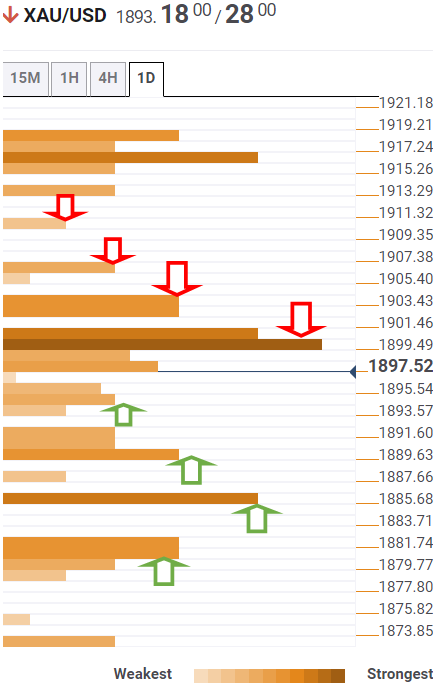
About Technical Confluences Detector
The TCD (Technical Confluences Detector) is a tool to locate and point out those price levels where there is a congestion of indicators, moving averages, Fibonacci levels, Pivot Points, etc. If you are a short-term trader, you will find entry points for counter-trend strategies and hunt a few points at a time. If you are a medium-to-long-term trader, this tool will allow you to know in advance the price levels where a medium-to-long-term trend may stop and rest, where to unwind positions, or where to increase your position size.
A sideways consolidation is underway in the EUR/USD. Economists at Société Générale note that the pair could enjoy further gains on a break past the 1.1410 mark.
Risk of further pullback if 1.1280 breaks
“A break above daily Ichimoku cloud at 1.1410 can lead to an extension in bounce.”
“Last week's low of 1.1280 and projections of 1.1180 are short-term supports.”
- GBP/JPY gained traction for the second straight day and was supported by a combination of factors.
- A generally positive risk tone undermined the safe-haven JPY and extended some support to the cross.
- Weaker USD, BoE rate hike bets benefitted sterling and remained supportive of the intraday move up.
The GBP/JPY cross extended its steady intraday ascent and climbed to the top end of the weekly trading range, around the 156.70 region during the first half of the European session.
A combination of factors assisted the GBP/JPY cross to gain traction for the second successive day on Wednesday and build on the overnight rebound from mid-155.00s, or over one-week low. A recovery in the global risk sentiment undermined the Japanese yen's relative safe-haven status and acted as a tailwind for spot prices. Apart from this, a goodish pickup in demand for the British pound provided an additional lift to the cross.
The nervousness over the worsening situation in Ukraine eased after a Kremlin spokesperson said on Tuesday that Russia is still open to diplomacy and has an interest in that. Apart from this, the fact that new economic sanctions on Russia were not as bad as feared further boosted investors' confidence. This was evident from a generally positive tone around the equity markets, which drove flows away from traditional safe-haven assets.
The upbeat market mood also weighed on the US dollar, which, along with rising bets for additional interest rate hikes by the Bank of England extended some support to sterling. The expectations were reinforced by hawkish comments from BoE Deputy Governor Dave Ramsden, saying that some further tightening seems appropriate in the coming months. This was seen as another factor that pushed the GBP/JPY cross higher on Wednesday.
The fundamental backdrop seems tilted in favour of bullish traders, though the risk of an imminent Russian invasion of Ukraine warrants some caution. Apart from this, the lack of progress in talks to resolve the problems with the Northern Ireland protocol of the Brexit agreement might cap gains for the GBP/JPY cross. Hence, it will be prudent to wait for some follow-through buying before positioning for any further appreciating move.
Technical level to watch
EUR/PLN has dipped towards the lower limit of the channel since 2020 at 4.4800. Economists at Société Générale expect the pair to stage a short-term rebound, with the late January peak of 4.6010 capping.
Short-term upside likely
“A bounce is likely, however, late January peak of 4.6010 should be first resistance.”
“Should decline persist below 4.4800, next potential support could be at last June levels of 4.4360 .”
Brent Oil has extended its uptrend after breaking above 2018 high of $86.75. A move beyond $101.50/101.90 would open up further gains towards $114/117, straetgists Société Générale at report.
The $90.00 level is important support
“Brent is now inching closer to interim hurdle of $101.50/101.90 representing projections and the upper limit of an ascending channel. Test of this could lead to a pullback however signals of reversal are still not visible.”
“Low formed last week at $90.00 should be important support near-term.”
“Beyond $101.50/101.90, next significant resistance zone could be at 2014 peak of $114/117.”
The situation in Ukraine is incredibly fragile. Therefore, economists at ING believe that European currencies should continue to underperform, allowing the US Dollar Index (DXY) to move back above the 97.00 level over coming days.
Favour the dollar for liquidity and energy independence
“Given the very uncertain picture in Ukraine, we suspect that investors will still prefer the liquidity and energy independence of the dollar – at least against the European currencies.”
“With the DXY heavily weighted towards European FX, we would certainly back the dollar right now and would favour DXY returning to the 97.00 area over coming days.”
The New Zealand dollar is the top performing G10 currency today and is a response to the Reserve Bank of New Zealand (RBNZ) meeting. The RBNZ signalled the need for more aggressive action going forward, which should provide support for the kiwi, according to economists at MUFG Bank.
RBNZ signals higher peak in rates
“Official policy rate was raised as expected by 25bps to 1.00%. We thought there was a high risk of the RBNZ moving 50bps today and the RBNZ did acknowledge that the decision was a close call and that in the future they would not hesitate to move in larger increments if required.”
“The OIS market was already implying a policy rate of around 2.50% prior to today’s meeting and the guidance today has encouraged the market to expect an even higher rate as investors remain wary of central banks possibly being behind the curve and having to do more. That will likely keep NZD well supported over the short-term.”
A break above $1,107 would see platinum establishing an important base. The precious metal would then mark a change of trend higher towards the $1,340 high, strategists at Credit Suisse report.
Upside bias while above $1,107
“Platinum has moved strongly higher to turn the spotlight on the $1,107 high of November last year. A weekly close above here would see an important base established and change of trend higher. We would then see resistance at $1,148 initially, ahead of $1,171 and eventually back at the $1,340 high.”
“Support at $1,007 needs to hold to see the immediate upside bias maintained.”
Investors stay focused on geopolitics. Escalating tensions between Russia and Ukraine could drag the EUR/USD pair down towards the 1.12 level, economists at Commerzbank report.
USD, JPY and CHF to remain in demand as volatilities are rising
“Monetary policy is taking a back-seat, and risk aversion is in the driving seat. As a result, volatilities are rising and the safe havens JPY and CHF are likely to remain in demand, as will the dollar.”
“If the situation in Ukraine escalates further, EUR/USD could therefore easily make another attempt towards 1.12.”
- USD/CAD met with a fresh supply on Wednesday and once again failed near the 1.2780-1.2785 area.
- An uptick in crude oil prices underpinned the loonie and exerted pressure amid subdued USD demand.
- A generally positive risk tone turned out to be a key factor that weighed on the safe-haven greenback.
The USD/CAD pair extended its steady intraday descent through the early European session and dropped to a fresh daily low, around the 1.2725 region in the last hour.
The pair continued with its struggle to make it through the 1.2780-1.2785 supply zone and came under some renewed selling pressure on Wednesday. A generally positive tone around the equity markets weighed on the safe-haven US dollar and acted as a headwind for the USD/CAD pair. Apart from this, an uptick in crude oil prices underpinned the commodity-linked loonie and attracted fresh selling around the major.
The fact that sanctions on Russia were not as bad as feared helped ease the nervousness over the situation in Ukraine and helped ease the nervousness over the situation in Ukraine. This, in turn, boosted investors' confidence and drove flows away from traditional safe-haven assets. That said, the risk of an imminent Russian invasion of Ukraine kept a lid on the market optimism.
Russian President Vladimir Putin upped the ante on Monday by recognizing two breakaway regions in eastern Ukraine as independent entities and allowing troops to enter the area to maintain peace. Moreover, Russia's upper house voted in favour of giving Putin the authority to deploy forces abroad. This lifted crude oil prices, which benefitted the Canadian dollar and weighed on the USD/CAD pair.
The mixed fundamental backdrop might hold back traders from placing aggressive directional bets amid absent relevant market-moving economic releases, either from the US or Canada. That said, fresh developments surrounding the Russia-Ukraine saga will influence the USD. This, along with oil price dynamics, should produce some meaningful trading opportunities around the USD/CAD pair.
Technical levels to watch
The UK Foreign Minister Liz Truss said in a statement on Wednesday, “we are very much expecting a full-scale Russian invasion of Ukraine.”
Additional comments
But we don't have full evidence yet that Putin has sent in troops.
If Putin escalates, the international community will escalate sanctions.
Nothing is off the table in terms of who we target with sanctions.
Meanwhile, BBC News is reporting that PM Boris Johnson may announce some additional military support for Ukraine, although nothing specific is known about the same.
“No 10 and Treasury calling in finance bosses and regulators later to talk about how to make sure sanctions are effective,” BBC News’ Laura Kuenssberg tweeted out.
Market reaction
The warnings by the UK’s Truss fail to dampen the market mood, which remains lifted at the time of writing, benefiting GBP/USD.
Cable is up 0.25% on the day, trading at 1.3617.
European Central Bank (ECB) policymaker Francois Villeroy de Galhau said Wednesday, “we will assess the more indirect consequences of Ukraine crisis on inflation and growth in March.”
Additional quotes
“We will be facts-driven.”
“Optionality about the right monetary stance and flexibility to guarantee right transmission are two names of the game for ECB policy.”
Market reaction
EUR/USD is holding the higher ground near 1.1340, unfazed by these comments. The US dollar remains choppy amid ongoing tensions between Russia and Ukraine.
After a brief spike to 0.8380 yesterday, EUR/GBP is again dropping back to the low 0.83s. Economists at ING still expect the pair to move to the 0.8300/0.8280 region.
Watch out for Bank of England speakers
“We favour the direction of travel towards 0.83, where at least GBP is being buoyed by a more materials-weighted local equity benchmark and the UK government's more aggressive re-opening schedule.”
“Today, we will see BoE heavy-hitters Andrew Bailey and Ben Broadbent testify to a parliamentary committee. We doubt they will want to push back (yet) on aggressive pricing of the BoE cycle, which is providing support to GBP and helping to insulate against higher energy prices.”
“We continue to favour a move to the 0.8280/8300 area for EUR/GBP.”
The euro has held up reasonably well this week. Still, the EUR/USD pair could dive below 1.1280 towards 1.1220 on Russian invasion or higher natural gas prices, economists at ING report.
In harm's way
“Similar to the Fed, events in Ukraine have knocked about 10bp off the pricing of the terminal European Central Bank (ECB) rate (roughly in the two-year horizon), but we suspect expectations of the Fed cycle will bounce back quicker.”
“EUR/USD could break below 1.1280 to the 1.1220 area – or lower – should Russian lines move further West in Ukraine or natural gas prices spike further.”
Analysts at Credit Suisse continue to forecast a 6.30-6.40 trading range for USD/CNH in Q1 as the pair will not react meaningfully either to further Russia-Ukraine escalations or China’s slowing GDP.
Diplomatic immunity
“Amid rising geopolitical tensions we think USDCNY and USDCNH will remain stable within a 6.30-6.40 range as China’s policymakers continue to manage FX volatility amid the growth slowdown.”
“The consensus view in Asia is that China’s policymakers no longer wish to use yuan weakness as a policy tool to boost China’s trade and manufacturing competitiveness. Strong export and trade growth is one of the few bright spots amid weak China data indicators.”
“Concern over China’s property sector persists. Credit sentiment in the property sector could remain weak, but we think the spillover onto USD/CNY will be minimal. China’s authorities will be careful to limit financial contagion amid continued financial press speculation about a ‘Lehman moment’ in China. USD/CNY stability is a critical policy tool in these efforts.”
USD/JPY risks a deeper pullback if 114.40 is breached in the short-term horizon, suggested FX Strategists at UOB Group.
Key Quotes
24-hour view: “Yesterday, we held the view that USD ‘could edge lower but any decline is expected to encounter solid support at 114.40’. USD did not challenge the 114.40 level as it rebounded strongly from 114.48 (high has been 115.23). The rapid rebound appears to be running ahead of itself and USD is unlikely to strengthen much further. For today, USD is more likely to trade within a range of 114.70/115.30.”
Next 1-3 weeks: “We highlighted yesterday that downward momentum has improved slightly and there is room for USD to edge lower. We added, USD ‘has to break the solid support at 114.40 before a more sustained decline can be expected’. USD subsequently dropped to 114.48 before rebounding strongly to a high of 115.23. There is no change in our view but a break of 115.30 (no change in ‘strong resistance’ level) would indicate that USD is not ready to breach 114.40.”
Economists at Credit Suisse remain bullish on the Swiss franc and reaffirm their 1.0050 EUR/CHF target.
Peripheral spread widening sends a warning signal to the ECB
“A neutral SNB, fading ECB hawkishness, wider euro area peripheral spreads and geopolitical risks should weigh on EUR/CHF.”
“We continue to believe that the currency pair has further downside potential despite the recent spike higher and stick to our 1.0050 target.”
The Reserve Bank of New Zealand (RBNZ) has hiked interest rates by 25bp and is set to push ahead with the tightening cycle. This should support the New Zealand dollar in the medium-term, however, NZD/USD could dip below 0.67 in the new few days, according to economists at ING.
RBNZ delivers a hawkish hike
“RBNZ delivered a 25bp rate hike but surprised on the hawkish side by revising its rate-path projections significantly higher. Incidentally, the bank announced the start of quantitative tightening through both bond maturities and managed sales of its holdings.”
“RBNZ is set to remain the most hawkish central bank in the G10 space, a factor that will offer NZD some good support in the medium-term.”
“In the short-run, external factors (geopolitics, unstable risk sentiment in the run-in to Fed tightening) continue to pose downside risks to NZD and may soon offset the modestly positive post-RBNZ reaction in the currency.”
“NZD/USD may slip back below 0.6700 in the coming days.”
EUR/USD has regained its traction after declining below 1.1300 on Tuesday. The pair will recover bullish momentum on a break above the key resistance that seems to have formed near 1.1350, FXStreet’s Eren Sengezer reports.
Rising US Treasury bond yields help the greenback
“Although the euro could find some demand in case the market mood continues to improve, another leg higher in US T-bond yields should help the dollar stay resilient against its major rivals.”
“A negative shift in risk perception is likely to make it difficult for the common currency to find demand. In that case, EUR/USD could turn south but the losses could remain limited if US T-bond yields start edging lower as well.”
“In case the pair manages to rise above the 1.1340/1.1350 area (Fibonacci 38.2%, 200-period SMA) and starts using it as support, the next bullish target could be seen at 1.1400 (psychological level, Fibonacci 23.6% retracement).”
“Key support is located at 1.1280 (static level) before 1.1260 (Fibonacci 61.8% retracement) and 1.1240 (static level).”
The Korean won and the New Taiwan dollar are down 1.4% and 0.5% versus the UD dollar respectively so far this year. Economists at Commerzbank expect these currencies to remain under pressure as the conflict in Ukraine will negatively affect the semiconductor industry.
Conflict to hit semiconductors
“A prolonged conflict that keeps oil prices high will hurt Asian growth and currencies. Supply disruptions will hurt the major semiconductor producers in Asia even further, namely Taiwan, South Korea, and to a lesser extent, Singapore.”
“There is scope for a further pullback in KRW and particularly for TWD after the strong performance in the past two years.”
Economists at Credit Suisse are now neutral on the Norwegian krone. They target EUR/NOK at 10.07 and expect the pair to remain within a 9.95-10.20 range in Q1.
Outlook continues to validate the Norges Bank’s tightening plans
“We are now neutral on EUR/NOK.”
“We target 10.07 in EUR/NOK and expect the pair to remain within the Q1 2022 range of 9.95-10.20.”
“Norway’s data is still strong enough to justify the Norges Bank’s tightening cycle, but we struggle to see a fresh driver for further appreciation of tightening expectations in the near-term.”
“Year to date, exposure to tensions between Russia and Ukraine has materialized in the form of reduced EUR/NOK correlation with oil prices (with lower fiscal spending also likely being a driver of weak correlation). This leaves scope for a swift recovery in NOK if tensions subside.”
“We would also prefer to wait for clearer indications that strong data can drive upgrades to monetary policy expectations before becoming bullish on NOK once again.”
NZD/USD is trading at its highest level in a month above 0.6770 boosted by the Reserve Bank of New Zealand's (RBNZ) hawkish policy outlook. In the view of economists at Danske Bank, this policy announcement has positive implications for NZD/USD.
A hawkish hike
“RBNZ hiked interest rates by 25bp, but signaled that more aggressive tightening may be needed. In terms of balance sheet, RBNZ will begin 'active QT' and it plans to sell bonds from its portfolio in addition to not reinvesting maturing investments.”
“While RBNZ decided against a 50bp this time, they clearly signaled that it could come at a later stage, and also lifted the endpoint of the rate path.”
“While the geopolitical tensions' impact on commodities remains the key driver for NZD in the near-term, markets have not discounted much more than 25bp per meeting going forward, leaving further upside potential for NZD.”
Considering advanced prints from CME Group for natural gas futures markets, open interest reversed two daily pullbacks in a row and went up by around 9.6K contracts on Tuesday. In the same line, volume rose by around 82.3K contracts after two daily drops in a row.
Natural Gas now targets $5.00
Tuesday’s uptick in prices of natural gas was amidst rising open interest and volume, leaving the door open to further gains in the very near term with the immediate target at the $5.00 mark per MMBtu. In the meantime, the 200-day SMA around $4.26 continues to hold the downside for the time being.
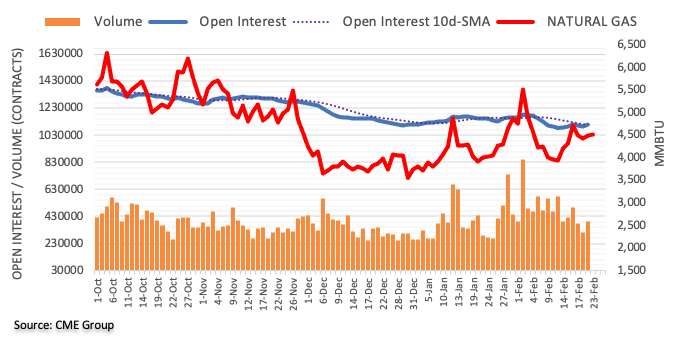
10-year US Bond Yields have seen two successive failures to sustain breakouts above 2.00% into the weekly close and the risk of a corrective move lower is elevated, in the view of analysts at Credit Suisse.
Still expect a move to 2.34% later in the year
“We are increasingly concerned that a risk-off move in equities could lead to a deeper correction, with the break below 1.90/895% likely to open up further downside towards 1.75/74%, which we expect to hold.”
“From a medium-term perspective, the market maintains a multi-year yield base and its negative trend and momentum setup. With this in mind, we eventually expect further weakness, with the next major support zone seen at 2.16/18%, with our core objective for 2022 at 2.34%.”
“Given that 2.34% is a minor support, we do not expect it to act as a hard ceiling; it’s just that we expect the market to start moving into a range and become more mean-reverting around here, especially with psychological support not far above at 2.50%.”
“We see 2.615/2.645% as a ‘stretch target’.”
- GBP/USD regained positive traction on Wednesday amid subdued USD demand.
- A positive risk tone was seen as a key factor weighing the safe-haven greenback.
- BoE rate hike bets remained supportive, though geopolitical risks might cap gains.
The GBP/USD pair maintained its bid tone through the early European session and was last seen hovering near the top end of its daily trading range, around the 1.3600 mark.
The pair built on the previous day's late rebound from the multi-day low, around the 1.3540-1.3535 area, and gained some positive traction on Wednesday amid subdued US dollar demand. Despite the recent geopolitical developments, the fact that new economic sanctions on Russia were not as bad as feared helped ease the nervousness over the situation in Ukraine. This was evident from a generally positive tone around the equity markets, which undermined the greenback's relative safe-haven status and acted as a tailwind for the GBP/USD pair.
The British pound also drew support from hawkish comments by the Bank of England (BoE) Deputy Governor Dave Ramsden, saying that some further tightening is likely to be appropriate in the coming months. This reinforced expectations for additional interest rate hikes by the BoE. In fact, investors are pricing in another rate hike at the next scheduled BoE meeting that concludes on March 17. This was seen as another factor behind the GBP/USD pair's intraday move up. That said, the upside seems limited amid rising geopolitical tensions.
The risk of an imminent Russian invasion of Ukraine might continue to weigh on investors' sentiment and keep a lid on the optimistic market move. It is worth recalling that Russian President Vladimir Putin upped the ante on Monday by recognizing two breakaway regions in eastern Ukraine as independent entities and allowing troops to enter the area to maintain peace. Moreover, Russia's upper house voted in favour of giving Putin the authority to deploy forces abroad. This should limit losses for the buck and cap the GBP/USD pair, at least for now.
Apart from this, the lack of progress in talks to resolve the problems with the Northern Ireland protocol of the Brexit agreement might further hold back bulls from placing aggressive bets. This makes it prudent to wait for strong follow-through buying before positioning for any further gains amid absent relevant market-moving economic releases, either from the UK or the US. That said, developments surrounding the situation in Ukraine will influence the USD, which, in turn, should provide some impetus to the GBP/USD pair.
Technical levels to watch
Here is what you need to know on Wednesday, February 23:
The positive impact of easing fears over a military conflict between Russia and Ukraine on the risk sentiment faded away in the second half of the day on Tuesday as the US introduced sanctions against Russia. Wall Street's main indexes closed the day deep in the negative territory and the 10-year US Treasury bond yield declined for the fourth straight day. Markets stay relatively quiet early Wednesday as investors stay focused on geopolitics. Wednesday's economic calendar will not be offering any high-impact data releases.
Early Wednesday, the market mood stays moderately upbeat with US stocks futures indexes rising between 0.15% and 0.25%. The US Dollar Index, which closed little changed near 96.00 for the second straight day on Tuesday, continues to move sideways. Atlanta Fed President Raphael Bostic said late Tuesday that they were not sure how sanctions against Russia would impact the economic activity. "The Fed needs to move off of emergency policy stance and can do so without jeopardizing employment," Bostic added but these comments failed to trigger a noticeable market reaction.
NZD/USD is trading at its highest level in a month above 0.6770 boosted by the Reserve Bank of New Zealand's (RBNZ) hawkish policy outlook. As expected, the RBNZ hiked its policy rate, the official cash rate (OCR), by 25 basis points to 1% and RBNZ Governor Adrian Orr said that they cannot rule out 50 basis points rate hikes in the future. "The amount of tightening through bond sales is very small, it's all about the OCR," Orr added.
EUR/USD is trading in a relatively tight range above 1.1300 early Wednesday despite European Central Bank Governing Council member Robert Holzmann's hawkish comments. “The ECB could take a first interest rate step in the summer and a second at end-2022,” Holzmann said in an interview with NNZ.
GBP/USD dropped to 1.3540 on Tuesday but managed to erase a large portion of its daily losses to close at 1.3580. The pair is fluctuating in a tight range below 1.3600 in the early European morning. Later in the session, Bank of England (BOE) Governor Andrew Bailey will present the Monetary Policy Report to the UK parliament.
Gold advanced to a fresh multi-month high above $1,910 on Tuesday but lost its traction with safe-haven flows cooling off. XAU/USD seems to have gone into a consolidation phase near $1,900 mid-week.
Bitcoin staged a rebound after falling to multi-week lows on Tuesday but continues to trade below $40,000. Ethereum continues to edge higher after closing in the positive territory on Tuesday and was last seen rising more than 1% near $2,700.
Gold buyers are on the sidelines so far this Wednesday, hovering around the $1,900 threshold. XAU/USD awaits a fresh trigger to resume Ukraine crisis-led rally, FXStreet’s Dhwani Mehta reports.
Daily technical setup remains in favor of gold buyers
“Geopolitics will continue to lead the sentiment, with Ukraine in the eye of a storm and this calm in the market could be just before a potential Russian invasion storm. Resurgent flight to safety will revive the bullish interest in gold price.”
“Bulls will look for acceptance above the June 2021 highs of $1,917 once the eight-month highs of $1,914 is recaptured. If these resistance levels are cleared on a buying resurgence, then a test of the $1,920 round level will be inevitable.”
“The immediate support is seen at $1,890, below which the February 18 lows of $1,887 will be tested. The next significant downside target is near the $1,870 region, where the rising trendline support emerges. Selling pressure will likely intensify below the latter, opening floors towards the $1,850 psychological barrier.”
See – Gold Price Forecast: XAU/USD to make further gains if the Ukraine crisis escalates – Commerzbank
- EUR/GBP fades bounce off three-week low inside bearish channel.
- Bear cross, oscillators add to the downside bias.
EUR/GBP remains on the back foot around 0.8330 while consolidating the biggest daily gains in a week around intraday low ahead of Wednesday’s European session.
The cross-currency pair bounced off 0.8310 but couldn’t cross the 50% Fibonacci retracement (Fibo.) of February 03-07 upside.
The resulting pullback moves portrayed a short-term falling channel, as well as a bear cross between the 50-SMA and 200-SMA, which in turn suggest the quote’s further weakness.
Also keeping the EUR/GBP sellers hopeful is the recently easing bullish bias of the MACD and downward sloping RSI, not oversold.
That said, the stated channel’s support line near the 0.8300 threshold becomes the seller’s imminent target ahead of the monthly low of 0.8284.
Alternatively, 50-SMA and 61.8% Fibo. will challenge the short-term rebound near 0.8360 ahead of the 200-SMA and upper line of the stated channel, close to 0.8365-70.
In a case where EUR/GBP buyers cross the 0.8370 hurdle, the latest swing high of 0.8382 and the 0.8400 round figure should return to the charts.
EUR/GBP: Four-hour chart

Trend: Further weakness expected
FX Strategists at UOB Group noted AUD/USD faces another solid resistance around 0.7275 in the near term.
Key Quotes
24-hour view: “Our expectations for AUD to ‘consolidate within a range of 0.7160/0.7215’ yesterday were incorrect as it rose to 0.7234. Despite the advance, upward momentum has not improved by much. However, there is room for AUD to advance further even though a clear break of the major resistance at 0.7250 is unlikely (next resistance at 0.7275 is not expected to come into the picture). On the downside, a breach of 0.7190 (minor support is at 0.7205) would indicate that the current mild upward pressure has eased.”
Next 1-3 weeks: “We have expected AUD to advance to 0.7250 since last Thursday (17 Feb, spot at 0.7205). As AUD struggle to maintain its upward momentum, we highlighted yesterday (22 Feb, spot at 0.7190) that the chance for AUD to advance to 0.7250 has diminished. We added, ‘in order to rejuvenate the flagging momentum, AUD has to move and stay above 0.7215 within these 1 to 2 days’. AUD subsequently rose to 0.7234 before settling on a firm note at 0.7219 (+0.42%). The chance for AUD to move above 0.7250 has improved but it is left to be seen if it can maintain a foothold above this level. Looking ahead, the next resistance above 0.7250 is another strong level at 0.7275. Overall, only a breach of 0.7160 (‘strong support’ level was at 0.7140 yesterday) would indicate that the current upside risk has dissipated.”
Following the hawkish rate hike announcement by the Reserve Bank of New Zealand on Wednesday, analysts at Goldman Sachs adjusted their tightening outlook for the kiwi central bank.
Key quotes
"In light of today's hawkish RBNZ guidance and OCR track, we now expect the RBNZ to tighten by +25bp at every meeting in 2022, taking the OCR to 2.5% by year-end (previous peak at 2.0% in August).”
“The RBNZ has shown its determination to engineer tighter financial conditions over the medium-term in order to dampen inflationary pressures, and we think its perception of medium-term global inflation risks will see it continue to tighten rates over the course of this year.”
That said, while we think further tightening in 2023 is possible, we do not view it as the most likely scenario should global inflationary pressures ease and house prices decline as we expect."
Read: NZD/USD sticks to hawkish RBNZ-inspired gains to over one-month high, around 0.6765-70
- NZD/USD gained strong traction on Wednesday in reaction to a more hawkish RBNZ decision.
- A positive risk tone further benefitted the perceived riskier kiwi amid subdued USD demand.
- Geopolitical tensions might turn out to be the only factor that could cap gains for the major.
The NZD/USD pair held on to its post-RBNZ gains and was last seen trading around the 0.6765-0.6770 region, or over one-month high heading into the European session.
The pair gained strong positive traction on Wednesday after the Reserve Bank of New Zealand (RBNZ) announced its policy decision and opted for a more hawkish stance. As was widely expected, New Zealand's central bank hiked interest rate for the third time since October and signalled a more aggressive tightening path going forward.
In the accompanying policy statement, the RBNZ noted that the decision between a 25bp and 50bp hike was finely balanced and also increased the official cash rate (OCR) peak forecast. The central bank projected that the cash rate would reach 2.2% by the end of 2022 and 3.35% in the last quarter of 2023, 0.75% higher than its November forecast of 2.6%.
Apart from this, a generally positive tone around the equity markets acted as a tailwind for the perceived riskier kiwi amid subdued US dollar demand. The fact that new economic sanctions on Russia were not as bad as feared helped ease the nervousness over the situation in Ukraine, which boosted investors' confidence and undermined the safe-haven buck.
That said, the risk of an imminent Russian invasion of Ukraine kept a lid on the optimistic market moves and held back bullish traders from placing aggressive bets around the NZD/USD pair. It is worth recalling that Russian President Vladimir Putin recognized two breakaway regions in eastern Ukraine as independent entities and allowed troops to enter the area to maintain peace.
Nevertheless, the follow-through move beyond the previous monthly swing high, around the 0.6730-0.6735 region might have already set the stage for a further appreciating move. Hence, a subsequent strength, which should allow the NZD/USD pair to reclaim the 0.6800 mark, remains a distinct possibility amid absent relevant market-moving economic releases from the US.
Technical levels to watch
- EUR/JPY keeps the previous day’s rebound from two-week low.
- Risk appetite improves amid absence of Russia’s retaliation to Western sanctions, lack of major updates.
- Off in Japan, light calendar elsewhere also allows traders to consolidate recent losses.
EUR/JPY extends bounce off the intraday low around 130.30 heading into Wednesday European session.
In doing so, the cross-currency pair holds onto the previous day’s recovery moves from the lowest levels since February 03 while cheering the recently positive mood in the market, as well as upbeat comments from a European Central Bank (ECB) official.
“ECB could begin increasing interest rates before ending its bond purchasing programme, ECB policymaker Robert Holzmann said in an interview with Swiss newspaper NZZ, saying a rate change would be possible already in summer,” per Reuters.
The news also mentions the record inflation to portray the recent ECB policymakers’ comments favoring the end of bond purchases this year, which was previously considered as a prerequisite for any rate hike. However, ECB’s Holzmann took a step further and said, per Reuters, “it was possible for the ECB to veer away from the policy guidance that any interest rate increase would only come ‘shortly after’ quantitative easing ends, and move to change interest rates first.”
Elsewhere, Russia’s refrain to challenge the harsh Western sanctions and comments from US President Biden like, “We have no intention of fighting Russia,” seem to have favored the market’s sentiment of late. The lack of major catalysts and silent macros, not to forget the holiday in Japan, also contributes to the EUR/JPY upside.
That said, stock futures in the US and Europe print mild gains while the US Treasury yields remain inactive at around 1.94%, due to off in Japan, after rising around 2.0% daily in the previous day.
Looking forward, Germany’s GfK Consumer Confidence Survey for March, expected -6.3 versus -6.7 prior, will join comments from ECB policymakers to entertain intraday EUR/JPY traders. However, major attention will be given to risk catalysts.
Technical analysis
200-DMA and fortnight-long descending trend line highlight 130.40 as the key short-term upside hurdle.
CME Group’s flash data for crude oil futures markets noted open interest extended the downtrend for yet another session on Tuesday, this time by more than 8K contracts. Volume, instead, went up for the second session in a row, now by around 326.6K contracts, the largest single-day build since February 11.
WTI looks supported around $89.00
Tuesday’s daily retracement in prices of the WTI was accompanied by diminishing open interest, removing strength from the continuation of the downtrend in the very near term at least. The uptick in volume, however, could prompt prices of the commodity to attempt a move to the $89.00 mark before rebounding.
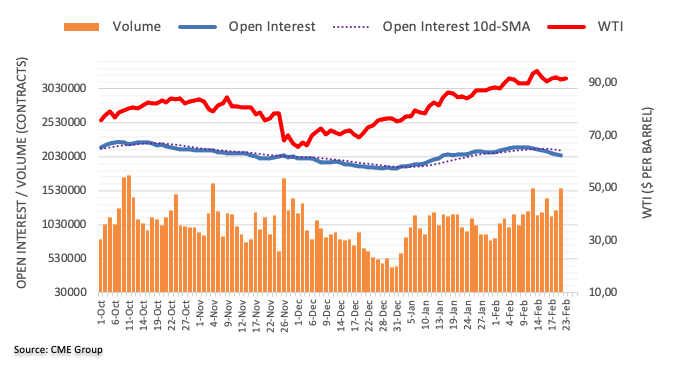
- USD/JPY is trading lackluster ahead of Thursday's US GDP and Initial Jobless Claims.
- The Asian markets are cautiously optimistic on fewer headlines over the Russia-Ukraine tensions.
- The DXY seesaws as the risk appetite increase superficially.
The USD/JPY pair is hovering around 115.06 heading towards the European open, as investors cheer risk-on market profile amid a lack of discouraging headlines surrounding the Russia-Ukraine crisis.
Meanwhile, attention turns towards the quarterly Gross Domestic Product (GDP) numbers by the US Bureau of Economic Analysis and Initial Jobless Claims by the US Department of Labor, which are due on Thursday, as the US docket is data-dry this Wednesday.
The quarterly US GDP numbers and Initial Jobless Claims are expected to land at 6.9% and 235k as per the market estimates against the previous prints of 7% and 248k respectively.
USD/JPY rebounded after hitting the lows of 114.50 on Tuesday, as sanctions from the Western leaders on Russia kicked in. Rumors are that the Federal Reserve (Fed) may not go for an aggressive tightening policy in March’s monetary policy committee (MPC) meeting upon negative developments in the Russia-Ukraine tussle. However, principal sanctions on Russia are likely to push oil prices higher; eventually, it can lead to higher manufacturing costs and off-course the prices of final goods. Therefore, higher inflation expectations may jeopardize the situation for the Fed.
In light of these events, a confused market is keeping the major in a narrow range of 114.99-115.13 in the early European session.
The US dollar index (DXY) is also trading lackluster as Asian markets have rebounded on Wednesday, which has increased the risk appetite of investors superficially.
While the Tokyo Consumer Price Index numbers by the Statistics Bureau of Japan on Thursday will be keenly watched.
The European Central Bank (ECB) governing board member Robert Holzmann said in an interview with NNZ, “it is possible for ECB to hike rates before ending bond purchases.”
“The ECB could take a first interest rate step in the summer and a second at end-2022,” Holzmann added.
Market reaction
EUR/USD remains unperturbed by the hawkish comments from Holzmann. The spot was last seen trading at 1.1325, almost unchanged on the day.
In opinion of FX Strategists at UOB Group, cable is now seen navigating within the 1.3500-1.3645 range in the next weeks.
Key Quotes
24-hour view: “We expected GBP to ‘consolidate and trade between 1.3565 and 1.3630’ yesterday. However, GBP plummeted to 1.3639 before staging a rapid rebound to end the day slightly lower at 1.3587 (-0.12%). The choppy price actions have resulted in a mixed outlook and GBP could trade within a relatively broad range of 1.3560/1.3625 for today.”
Next 1-3 weeks: “Last Thursday (17 Feb, spot at 1.3585), we highlighted that GBP has to close above 1.3645 before a sustained advance is likely. As GBP struggled to move above 1.3645, we highlighted on Monday (21 Feb, spot at 1.3595) that the chance for GBP to move clearly above 1.3645 has diminished. Yesterday (22 Feb), GBP dropped below our ‘strong support’ level of 1.3545 (low of 1.3539). The breach of the ‘strong support’ indicates that GBP is not ready to head higher in a sustained manner. In other words, GBP is likely to trade sideways for now, expected to be between 1.3500 and 1.3645.”
Open interest in gold futures markets increased by nearly 10K contracts on Tuesday, reaching the fourth consecutive daily build according to preliminary readings from CME Group. Volume followed suit and went up by almost 190K contracts, reversing the previous daily drop.
Gold: Initial contention emerges at $1,880
Tuesday’s pullback in gold prices came in tandem with shrinking open interest and volume, indicative that a corrective downside could extend further in the very near term. Against that, the precious metal could extend the drop to the $1,880 region (February 16 high), which should offer initial contention.
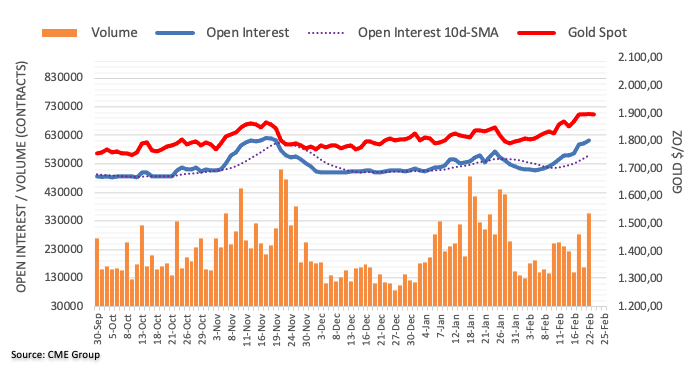
- WTI pares intraday gains as key HMAs test buyers during three-day uptrend.
- Weekly support break also adds to the bearish bias.
- Bears need validation from 23.6% Fibonacci retracement, $90.00.
WTI crude oil prices drop back towards $92.00 while consolidating intraday gains ahead of Wednesday’s European session.
Although a convergence of the 50-HMA and 200-HMA guards the quote’s immediate upside, the black gold prints the third consecutive positive daily candle at the latest.
Other than the failures to cross the $92.20-25 HMA convergence, a sustained trading below the previous support line from February 18, around $93.65 by the press time, also keep WTI sellers hopeful.
Even so, the 23.6% Fibonacci retracement of February 15-23 downside, near $90.60, will precede the $90.00 psychological magnet to test short-term declines.
Following that, the latest swing low and the monthly bottom, near $87.45 and $86.55, will lure the WTI crude oil bears.
On the flip side, a clear break of the $92.25 will aim for the $93.00 threshold before challenging the support-turned-resistance trend line near $93.65.
In a case where oil buyers remain dominant past $93.65, the $95.00 round figure may act as a buffer before directing the upside moves to the monthly high near $95.85, also the highest levels since late 2014.
WTI: Hourly chart

Trend: Pullback expected
The Commonwealth Bank of Australia (CBA) retains their call for "the RBA to commence raising the cash rate on June 22,” following the release of the Australian Wage Price Index (WPI) on Wednesday.
Key quotes
“Whilst today's (WPI) data wasn't as strong as we forecast, we expect a red hot Q122 CPI that will take the underlying rate of inflation to ~3.4% (4.5% on a six-month annualised basis). “
“Inflation data in line with our forecast as well as a strong Q122 WPI and an unemployment rate that is expected to have a 3handle on it should be sufficient evidence for the RBA to conclude, “inflation is sustainably in the target range" at the June Board meeting. “
“As such, it will be appropriate to start a tightening cycle.”
According to FX Strategists at UOB Group, EUR/USD could still revisit the 1.1280 zone in the next weeks.
Key Quotes
24-hour view: “Our expectations for EUR to ‘drop below 1.1280’ yesterday were incorrect as it rebounded strongly from 1.1286 to 1.1366 before dropping back down quickly. The movement is likely part of a consolidation and EUR is expected to trade between 1.1290 and 1.1360.”
Next 1-3 weeks: “In our latest narrative from Monday (21 Feb, spot at 1.1315), we highlighted that downward momentum is beginning to build and we expected EUR to ‘head lower to 1.1280’. EUR dropped to 1.1286 yesterday before rebounding quickly. Downward momentum has waned somewhat but as long as 1.1375 (no change in ‘strong resistance’ level from yesterday) is not breached, there is still room for EUR to drop to 1.1280. That said, the next support at 1.1240 is likely out of reach this time round.”
- USD/CHF grinds inside a choppy range of around 0.9200 after rising the most in 13 days the previous day.
- Market players await fresh clues to extend the previous risk-off sentiment.
- Off in Japan triggers USD pullback as bond markets remain inactive in Asia.
- Swiss ZEW numbers, risk catalysts will be the key drivers.
USD/CHF prints mild losses around 0.9207 heading into Wednesday’s European session.
The Swiss currency (CHF) pair rose the most in two weeks the previous day as the US dollar cheered the broad risk-off mood. The latest losses by the quote, however, are more due to the lack of major catalysts and silent macros than the optimism in the markets.
That said, the US ruled out the scope of a summit between US President Joe Biden and his Russian counterpart Vladimir Putin on Tuesday while US Secretary of State Antony Blinken rejected the need for Thursday’s meeting with Russian Foreign Minister Sergei Lavrov earlier in Asia. Previously, market sentiment soured after Russia’s Putin recognized Donetsk and Luhansk in Eastern Ukraine as independent states and signed a decree "on friendship and cooperation". In a reaction to Moscow’s moves, the West announced multiple sanctions on Russia.
However, US President Biden’s comments like, “We have no intention of fighting Russia,” seem to have played the role of turning down the fears of a full-fledged war between the West and Moscow. Additionally, comments from Japan’s Prime Minister (PM) Fumio Kishida, calling on Russia to return to diplomatic means, also allow bears to take a breather.
To portray the shift in the market sentiment, S&P 500 Futures rise 0.55% intraday while taking rounds to 4,235. However, the US Treasury yields remain inactive at around 1.94%, due to off in Japan, after rising around 2.0% daily in the previous day.
Moving on, Switzerland’s monthly prints of ZEW Expectations for February, market consensus 4.6 versus 9.5 prior, will act as an immediate catalyst for the USD/CHF prices. Though, major attention will be given to headlines concerning Russia and Ukraine for clear directions. Additionally, a lighter calendar in the US keeps the market’s focus on the Fedspeak considering the recently easy comments from the policymakers.
Technical analysis
USD/CHF struggles to keep the bounce off a six-week-old support line, around 0.9165 by the press time. On the contrary, a monthly resistance line near 0.9245 guards the quote’s immediate upside.
- Gold prices have slipped below $1897.70 as investors await fresh sanctions status on Russia.
- The precious metal has surged around 5.6% in February amid the safe-haven appeal.
- The bullion is retreating towards the trendline places from $1887.66.
Gold price is easing below the trading range of $1897.70-1901.70 formed in the Asian session. Investors are waiting for fresh impetus on the sanctions status on Russia by the Western leaders. The US and Britain have already imposed sanctions on Russia against its arbitrariness.
Earlier this week, Moscow recognized Donetsk and Luhansk as ‘independent’ regions in eastern Ukraine and built up military troops along with the support of separatist leaders. This has been considered a breach of international security and fake assurances on peace-making by the Western leaders.
The precious metal has remained in the grip of bulls in February on improving safe-haven appeal amid the Russia-Ukraine tensions. A juggernaut rally of around 5.6% has been recorded from February’s opening price at $1797.16 to the current trading price of $1896.4, at the time of writing. Adding to that, the odds of an aggressive monetary policy by the Federal Reserve (Fed) had diminished until Wednesday, which helped underpin the precious metal against the greenback.
Meanwhile, the US dollar index (DXY) is also oscillating in a narrow range of 95.98-96.12 on Wednesday ahead of quarterly Gross Domestic Product (GDP) numbers by the US Bureau of Economic Analysis, which are due on Thursday.
Gold Technical Analysis
On a 15-minute scale, XAU/USD is retreating towards the trendline placed from Monday’s low of $1887.66. The 50-period and 200-period Exponential Moving Averages (EMA) have turned flat after trending upwards, which calls for a pullback. The Relative Strength Index (RSI) (14) is likely to slip below 40.00, which may strengthen the case in favor of bears.
Gold 15-min chart
-637811901222421052.png)
- USD/TRY pulls back from six-week high, pressured around intraday low of late.
- Monthly horizontal area limits immediate downside ahead of the key support line and SMAs.
- Bulls may aim for January’s top, RSI favors further upside.
USD/TRY consolidates recent gains around the highest levels last seen on January 10 during early Wednesday morning in Europe.
The Turkish lira (TRY) pair’s latest pullback takes clues from the overbought RSI, inside the normal 70-30 area by the press time. It’s worth noting that the bullish RSI divergence, is a case when a higher low in prices accompanies the higher low in the RSI line.
That said, the quote’s further weakness may aim for a horizontal region comprising multiple levels marked since January 18, near $13.68.
However, any further weakness will be challenged by the monthly support line, near $13.60.
Even if the USD/TRY bears manage to conquer the $13.60 support, 100-SMA and 200-SMA will challenge additional declines near $13.55.
Alternatively, recovery moves may initially aim for $13.80 before renewing the upside momentum targeting January’s top surrounding $13.95.
Should USD/TRY buyers keep reins past-$13.95, the $14.00 threshold may test the upside momentum before directing the bulls towards the high marked on December 21, 2021, around $14.13.
Overall, USD/TRY may print extra losses on intraday but the bears remain cautious until witnessing a clear downside break of the 200-SMA.
USD/TRY: Four-hour chart

Trend: Further recovery expected
- USD/INR stays pressured around monthly low, keeps Tuesday’s losses intact.
- Market sentiment improves in absence of Russia’s retaliation to Western sanctions, ambiguity over border moves.
- INR swap premiums, upbeat US stock futures add to the bearish bias amid sluggish Asian session.
- Risk catalysts are the key but Japan’s holidays may restrict intraday moves.
USD/INR holds lower ground near 74.68 despite the latest bounce from the intraday low. In doing so, the Indian rupee (INR) pair drops 0.05% intraday while keeping the previous day’s losses during the late Asian session on Wednesday.
The quote remains below an upward sloping trend line from January 21 as a recently positive mood in the market weighs on the US dollar’s safe-haven demand. US President Biden’s comments like, “We have no intention of fighting Russia,” seem to have tamed the fears of a full-fledged war between the West and Moscow, which in turn favored the latest risk-on mood. Additionally, comments from Japan’s Prime Minister (PM) Fumio Kishida, calling on Russia to return to diplomatic means, also allow bears to take a breather.
Read: US Dollar Index Price Analysis: DXY stays depressed around 96.00 inside nearby rising channel
Also helping the USD/INR sellers is the jump in the INR forward premiums on the Reserve Bank of India’s (RBI) swap announcement. On Monday, the RBI mentioned that it will enter into sell-buy swaps worth $5.00 billion with banks on March 08 to extend the maturity profile of its forward dollar book.
Amid these plays, S&P 500 Futures consolidate recent losses with 0.40% intraday gains while the US Treasury yields remain inactive at around 1.94%, mainly due to Japan’s holiday, after rising around 2.0% daily in the previous day.
It should be noted that the equity markets in India snapped a five-day losing streak by the press time. That said, the BSE Sensex tracks US stock futures to print 0.50% upside on a daily basis.
Moving on, USD/INR traders will keep their eyes on the headlines concerning Russia-Ukraine for fresh impulse.
Read: If Russia does invade Ukraine, this could finally spark-off the crash 'puts' have been telegraphing
Technical analysis
A clear downside break of a five-week-old ascending trend line joins sustained trading below the 50-DMA and 100-DMA to keep sellers hopeful of revisiting the 200-DMA level near 74.35.
- Bulls are set to break the consolidation of the previous 18 trading sessions.
- The bullish crossover of 50 and 200 EMAs backs the upside potential.
- The RSI (14) needs to breach 60.00 to strengthen the buying momentum.
The USD/CAD pair has eased its gains on Wednesday after attracting some significant offers around 1.2780. The loonie has been oscillating in a range of 1.2636-1.2796 since January 28.
On a four-hour scale, USD/CAD has been forming a bullish pennant pattern, which signals a consolidation phase followed by a strong upside and leads to a solid bullish performance in the coming episodes. Usually, the consolidation phase denotes the placement of bids by investors who fail to enter in the initial rally or those investors placing bids, who prefer to enter in an auction after the establishment of an upside bias.
The Relative Strength Index (RSI) (14) is oscillating in a 40.00-60.00 range, hinting at a consolidation. However, a breach above 60.00 may strengthen the bulls for a juggernaut rally.
There is a bullish crossover from 50-period and 200-period Exponential Moving Averages (EMA), which adds to the upside filters.
Bulls are now eyeing Tuesday’s high at 1.2782, as overstepping the same will push USD/CAD towards the January 28 high at 1.2796, followed by January 06 high at 1.2813.
On the flip side, bears may recapture the grip on loonie if it slips below Friday’s low at 1.2673. Then, the major can go further south towards February 10 low at 1.2636 and December 08 low at 1.2606.
USD/CAD four-hour chart
- AUD/USD retreats from a fortnight high, tests bulls during three-day uptrend.
- Bearish candlestick near the five-week-old descending trend line keeps sellers hopeful.
- 200-SMA, ascending trend line from January 28 appears a tough nut to crack for the bulls.
AUD/USD bulls take a breather at weekly top, up 0.10% near 0.7225 during early Wednesday morning in Europe.
In doing so, the Aussie pair justifies the bearish Doji formation at the descending resistance line from January 20. Also favoring sellers is the steady RSI.
The latest pullback, however, has a limited downside as a one-week-old support line challenges the immediate declines around 0.7190.
Following that, a convergence of the 200-SMA and monthly rising trend line will offer strong support to the AUD/USD bears around 0.7160, a break of which won’t hesitate to recall the 0.7100 levels on the chart.
Alternatively, recovery moves need to provide a clear upside break of the stated resistance line near 0.7235-40.
Even if the pair remains firmer around 0.7240, a monthly high of 0.7250 and late January’s peak of 0.7277 will test the AUD/USD bulls before giving them controls.
AUD/USD: Four-hour chart
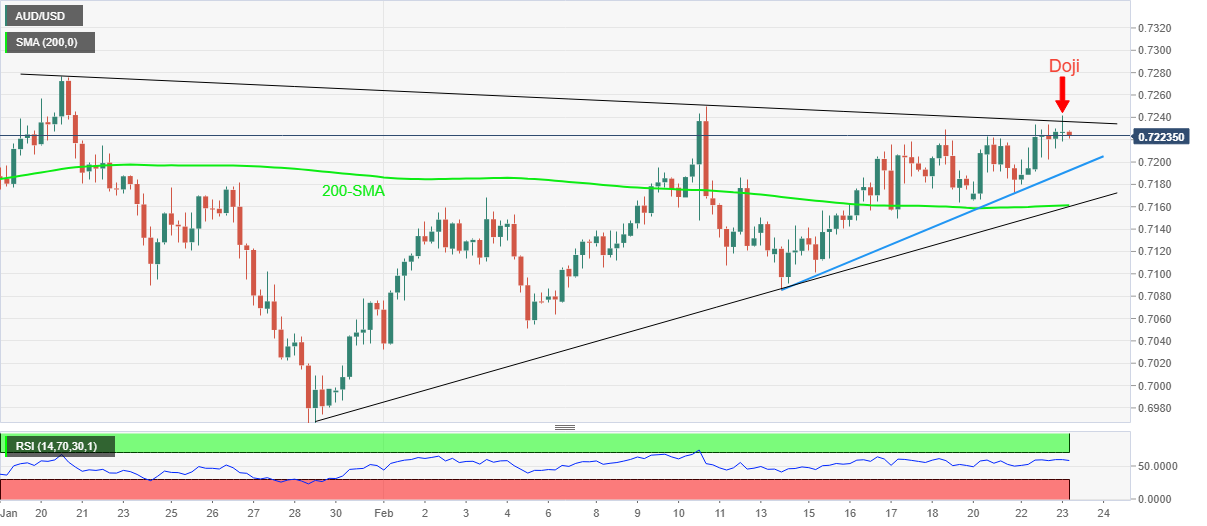
Trend: Pullback expected
Analysts at Nomura offer their bearish outlook on the Japanese yen but refraining from placing bets on the yen crosses amid the Ukraine tensions.
Key quotes
"Near-term USD/JPY movements will depend on how the Ukraine situation unfolds, but the widening divergence in monetary policy between Japan and the US will likely limit the risk of a strong JPY. Market attention on Japan's inflationary pressures is also on the rise, but we do not expect an acceleration of inflation in the Tokyo CPI data release next Friday."
"We thus maintain our bearish view on JPY, even though there are near-term headline risks from the situation in Ukraine. We maintain our USD/JPY call spreads, while waiting for an opportunity for EUR/JPY long positions if the situation in Ukraine calms down."
- EUR/USD bulls days could be numbered and the bull flag nullified.
- Bears stay in charge in a slow grind to the downside of the bearish channel.
In an earlier article from the US session, posted around the US president, Joe Biden's, announcement of sanctions on Russia, EUR/USD was posing as a bull flag pattern that has so far yet to materialise into a meaningful breakout.
EUR/USD bulls move in to clean up on the risk-off stops, bull flag taking shape
In fact, the price continues to deteriorate, slowly but surely into a deeper test of the bullish hourly impulse. More on that below.
Meanwhile, risk sentiment is leaning negative following an important pivot in the diplomatic resolution to the Ukraine crisis.
On Tuesday, the US removed one of those in an announcement from US Secretary Antony Blinken, saying that Russia's invasion is beginning, and that ''it doesn't make sense for me to meet with Russia's Lavrov anymore.''
He says he sent a letter the same day to him to inform him of that.
Key notes
- Blinken says Putin's 'disturbing' speech yesterday and statements today showed to the world that he views Ukraine as a 'subordinate' of Russia
- Blinken says now we know now that Putin's plan all along has been to invade Ukraine
- Blinken says Putin is blatantly breaking the laws and principles that have kept peace across Europe and in the world.
- Says the US will not allow Russia to claim the pretence of diplomacy.
- Says US and partners are always open to diplomacy but Moscow needs to demonstrate that it is serious about diplomacy.
- Says if Moscow's approach changes, US remains prepared to engage.
- Blinken says on the sanctions: we started high and we will stay high.
EUR/USD technical analysis
H1 chart prior analysis
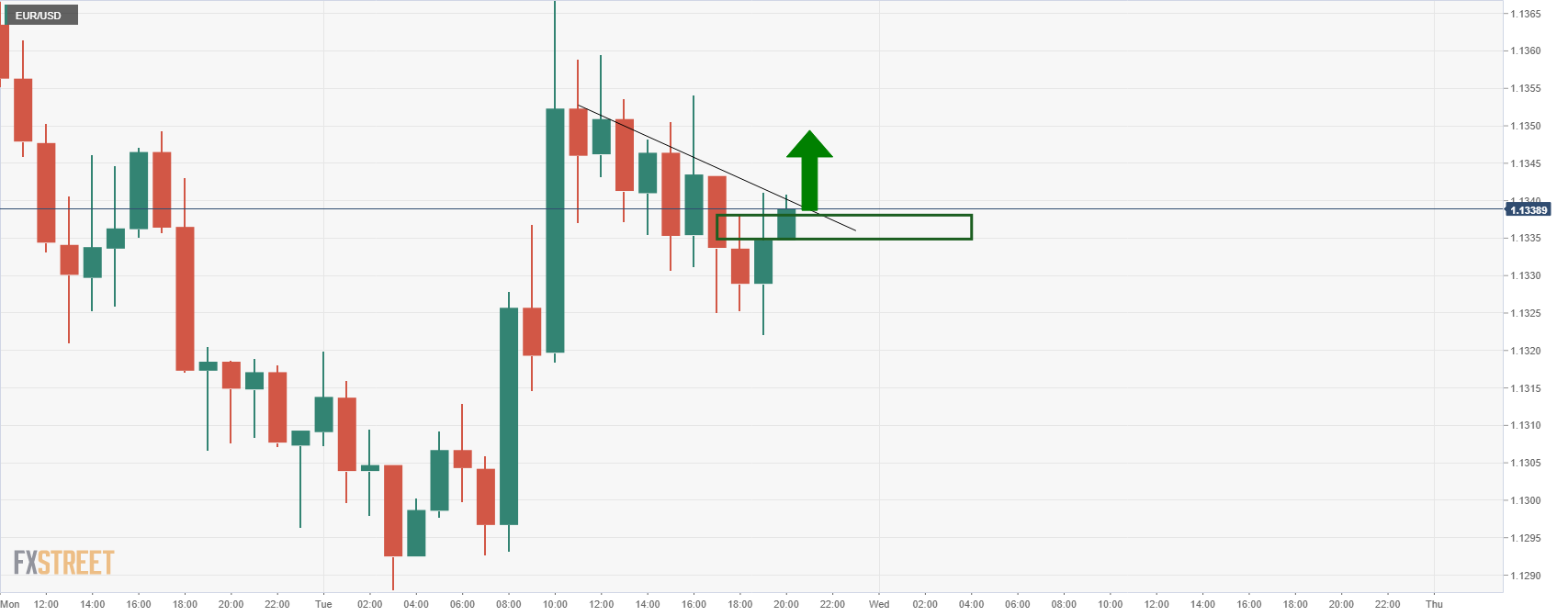
EUR/USD M15 chart, prior analysis
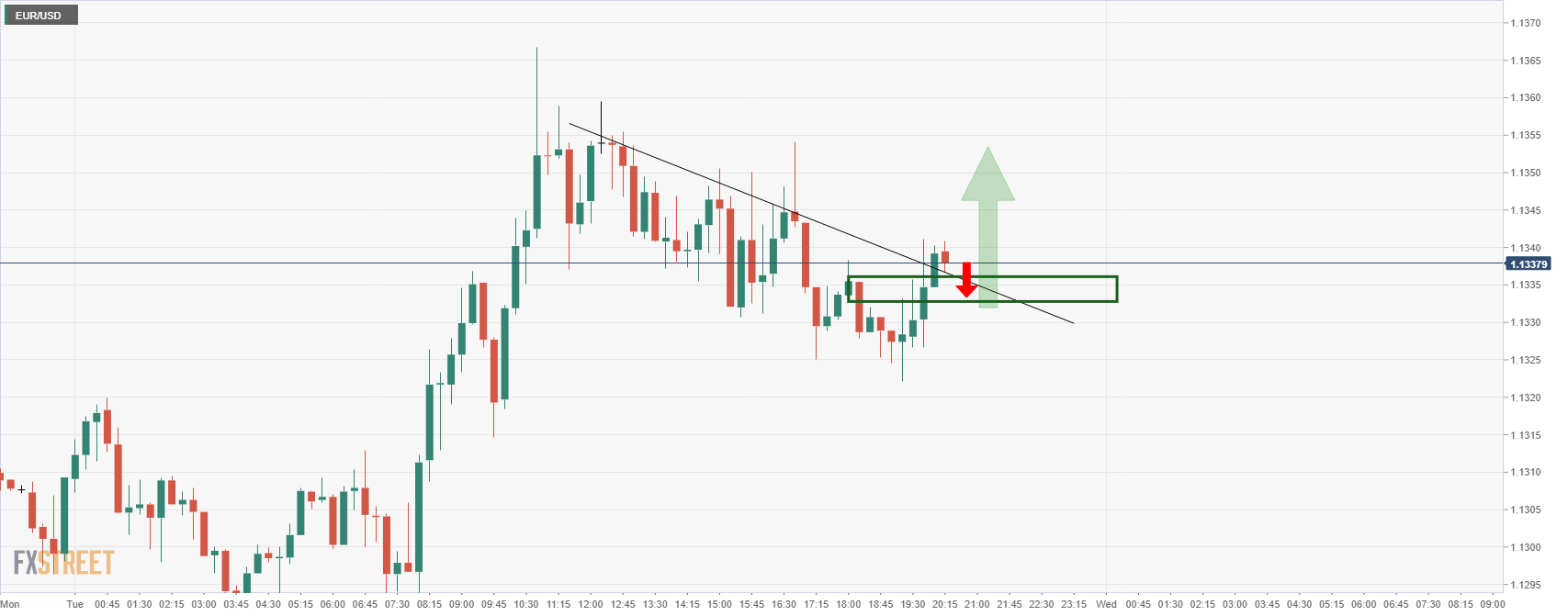
EUR/USD live market, M15 chart
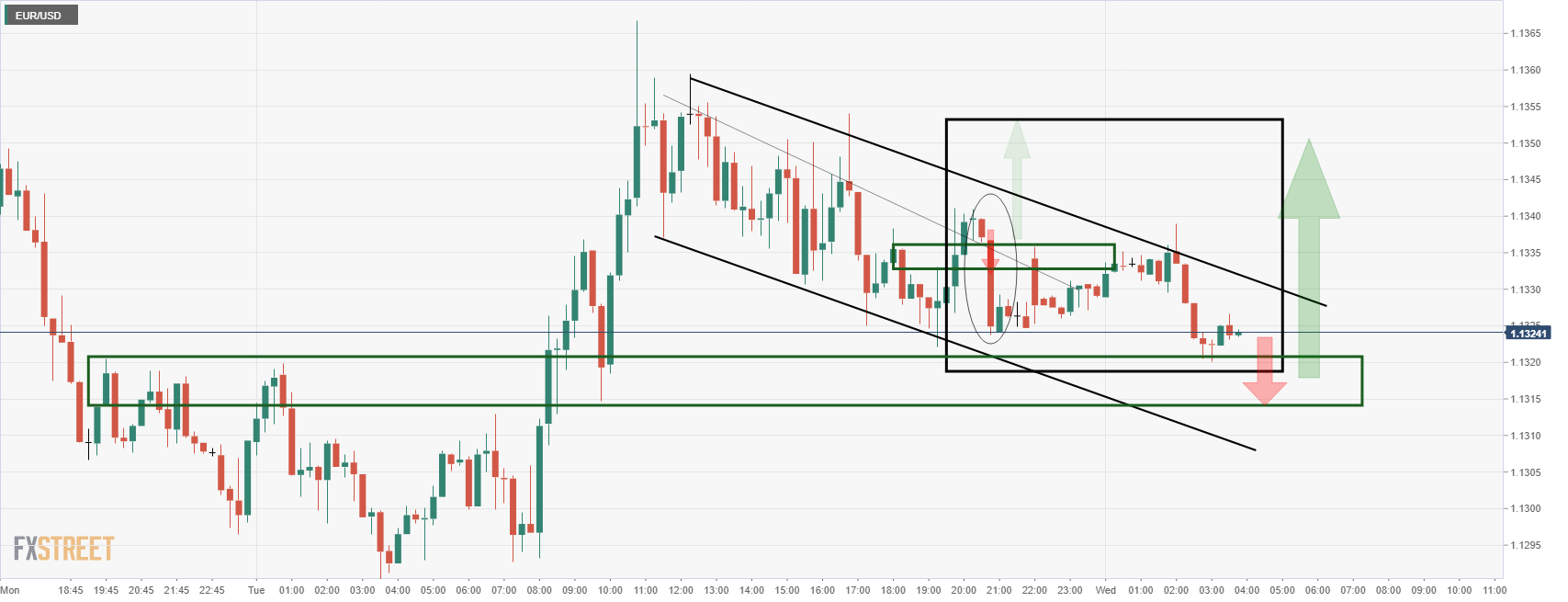
As illustrated, while the price did turn south into what was the old counter-trendline, it kept sinking and has resulted in a sideways drift, printing a lower low in Asia. There is from to go until the prior structure is met in the region of 1.1315 where support would be expected to attract buyers. This could lead to an eventual rally and break of the overextended bull flags resistance in the coming sessions.
With that being said, if risk-off fundamental sentiment steps up, the bull's days will be numbered and the flag will be nullified by significant continuation to the downside:
- If Russia does invade Ukraine, this could finally spark-off the crash 'puts' have been telegraphing
- GBP/USD keeps the bounce off monthly support to print mild intraday gains.
- Brexit talks to continue on a more regular basis, NI, post-Brexit tests got recent attention.
- UK leads in levying extra sanctions on Russia but PM Johnson is under pressure to do more.
- MPR will be key as BOE’s Ramsden sounds hawkish while CME’s BOEWatch tool expects 0.30% rate-hike in March.
GBP/USD struggles to defend the previous day’s bounce off monthly support line, approaching 1.3600 during early Wednesday morning in Asia.
The cable pair dropped to the lowest in a week the previous day as the US Dollar cheered safe-haven demand amid ongoing Russia-Ukraine tussles. However, hawkish comments from Bank of England (BoE) Deputy Governor Dave Ramsden joined an absence of major negatives on the Brexit front to trigger the quote’s latest bounce. Also underpinning the corrective pullback is the absence of Russian reactions to the West’s punitive measures and slightly softer comments from US President Joe Biden while announcing US sanctions on Moscow.
BOE’s Ramsden said on Tuesday that the UK economy has so far proved resilient, notwithstanding the scarring effects of COVID and Brexit, as reported by Reuters. "In the near term, some further tightening seems likely to be needed, to prevent current high inflation becoming embedded in wage and price settings," adds BOE’s Ramsden per Reuters.
Elsewhere, Foreign Secretary Liz Truss and European Commission Vice-President Maroš Šefčovič agreed to meet regularly and discuss any points raised by the EU or the UK after the latest Brexit talks, per the BBC. “Asked if the UK would trigger Article 16, which allows either side to unilaterally decide whether to stop implementing parts of the trade deal, Mrs. Truss said that she wanted to improve the situation through talks,” the news also mentioned. Alternatively, the Independent came out with the update suggesting the British criticism of the EU’s push for goods’ quality check. The news said, “Plans to force UK firms to put their goods through costly post-Brexit tests before they can go on sale have been plunged into confusion by a cabinet split.”
On the other hand, the UK was the first to levy, actually marking extra sanctions, on Russia due to the latest aggression towards Ukrainian borders. The US, Canada and European Union also followed the suit while the White House ruled out the scope of a summit between US President Joe Biden and his Russian counterpart Vladimir Putin. On the same line were comments from US Secretary of State Antony Blinken’s rejection of the need for Thursday’s meeting with Russian Foreign Minister Sergei Lavrov.
However, US President Biden’s comments like, “We have no intention of fighting Russia,” seem to have played the role of turning down the fears of a full-fledged war between the West and Moscow. Additionally, comments from Japan’s Prime Minister (PM) Fumio Kishida, calling on Russia to return to diplomatic means, also allow bears to take a breather.
Against this backdrop, S&P 500 Futures consolidate recent losses with 0.5% intraday gains while the US Treasury yields remain inactive at around 1.94%, mainly due to Japan’s holiday, after rising around 2.0% daily in the previous day.
Moving on, the BOE Monetary Policy Report (MPR) Hearings are the key event for GBP/USD traders to watch amid hawkish rhetoric from the policymakers and the market’s hopes of further rate hikes. By the press time, CME’s BOEWatch Tool flashes 100% probabilities of a 0.30% rate hike in March.
Technical analysis
GBP/USD remains inside a five-week-old triangle between 1.3635 and 1.3550, with the recent rebound taking clues from bullish MACD signals and firmer RSI to keep buyers hopeful.
- Risk sentiment surrounding the Ukraine crisis is disguising the severity of the US's recent pivot on diplomacy.
- The forex markets risk barometer, AUD/JPY, could be on the verge of another test of 82.12.
With markets across Asia tumbling on Tuesday amid the escalating threat of war, there is a spooky air of calm in Asian markets on Wednesday. With Japan on holiday, the Chinese indexes are higher despite the blatant risks of warfare in Central Asia and Europe.
The general consensus is, a Russian military incursion into Ukraine would have far-reaching economic ramifications in Asia in the near term. Russian energy, which could be sanctioned against by the West, is paramount as an economic driver for key nations in the region, including China and India, economic powerhouse nations that rely on steadily low oil prices.
Western countries are announcing sanctions in response to Russian President Vladimir Putin's decision to recognize the independence of two separatists "republics" in eastern Ukraine and send in Russian troops on a "peacekeeping" mission.
Measures forcing Russia to supply less crude or natural gas would have substantial implications on oil prices and the global economy. The price of Brent crude oil, an international benchmark, touched a seven-year high of more than $99 a barrel after President Vladimir Putin ordered troops into Ukraine's east. However, so far, there have been no sanctions on Russian energy. Instead, markets have welcomed a more measured approach, in what is regarded as a softer advance by the West, leaving the door open for discussions.
Sanctions are not enough to kick start the market crash
Sanctions from the EU and Germany, UK, US and Canada have for the main, been targeting Russian banks and Russian oligarchs that are in Putin's inner circle and sovereign debt. The penalties announced by the US president are the "first tranche of sanctions" intended to impose costs on Russia for its latest actions against Ukraine. US Sanctions are being applied to VEB bank and Russia's military bank, Promsvyazbank, which does defence deals, Biden said.
Starting on Wednesday US sanctions will begin against Russian elites and their family members. Biden also announced that the US will be working with Germany to halt the Nord Stream 2. Meanwhile, the European Union's foreign ministers will sanction the 351 Russian Duma members who voted to recognize the Donetsk and Luhansk People's Republics. Another 27 Russian entities and individuals accused of destabilizing Ukraine. The EU also agreed to target the "ability of the Russian state and government to access the EU's capital and financial markets and services." The UK will also sanction three "very high net worth individuals".
US pivots on the path to diplomacy
Meanwhile, what should be important to market sentiment are the stepping stones to a diplomatic resolution. However, on Tuesday, the US removed one of those in an announcement from US Secretary Antony Blinken. He said at the turn of early Asian forex markets, now that Russia's invasion is beginning, it doesn't make sense for him to meet with Russia's Lavrov anymore. He says he sent a letter the same day to him to inform him of that.
Key notes
- Blinken says Putin's 'disturbing' speech yesterday and statements today showed to the world that he views Ukraine as a 'subordinate' of Russia
- Blinken says now we know now that Putin's plan all along has been to invade Ukraine
- Blinken says Putin is blatantly breaking the laws and principles that have kept peace across Europe and in the world.
- Says the US will not allow Russia to claim the pretence of diplomacy.
- Says US and partners are always open to diplomacy but Moscow needs to demonstrate that it is serious about diplomacy.
- Says if Moscow's approach changes, US remains prepared to engage.
- Blinken says on the sanctions: we started high and we will stay high.
In an article written earlier in the US session on Tuesday, EUR/USD bulls move in to clean up on the risk-off stops, bull flag taking shape, it was stated that, ''as far as diplomacy, the White House said on Sunday a summit between the US and Russia will go ahead only 'if an invasion hasn't happened.' This means that the meeting between Secretary of State Antony Blinken and Russian Foreign Minister Sergey Lavrov in Europe this week will be a critical stepping stone in this direction.''
Now that this meeting has been taken off the agenda, it means that s summit between the US and Russian presidents are certainly not on either nation's radar and that leaves the door wide open for an invasion of more Ukrainian territory. After all, Kyiv has resisted negotiating directly with the governments of the Russian-controlled territories, saying it wants to speak with Moscow directly. However, there have been no signs from the Kremlin of welcoming such a summit and this leaves the situation on tenterhooks and on icy ground for financial markets.
Market implications
Meanwhile, traders have been steadily boosting bets against equities, as acknowledged in Bloomberg news that notes the highest levels in Put open interest on record.
''Whatever happens in Ukraine or how it affects Federal Reserve policy, the outcome will land in markets where investors have had time to prepare for the worst. It may be one reason the worst has so far been avoided,'' an article reads on BNN Bloomberg:
''They’ve been steadily boosting bets against equities, shaking off a reluctance to short tracing to last year’s meme stock upheaval. Bearish bets on the largest exchange-traded fund tracking the S&P 500 have surged, while put open interest on bond-focused products has risen to historic levels. Meanwhile, professional managers have been hedging their credit exposures.''
''As a result, not only have bearish bets on the SPY ETF surged, but put open interest on bond-focused products has also risen to historic levels. Meanwhile, professional managers have been hedging their credit exposures.''
With that all being said, however, in forex, we are not exactly seeing the kind of follow-through that one might expect from traders moving into safe-havens. The yen, for instance, as measured against a basket of currencies in the JXY, is barely holding in correction territory on the 4-hour chart, down vs, the Aussie by some 0.11% and flat vs the euro.
If there is going to be a meaningful move in sentiment, the forex markets risk barometer, AUD/JPY, that is retesting the daily counter-trendline, could be shaken out of its tree in the coming days. Eyes will be on whether it can take out the recent lows of 82.12:

A senior US State Department official said early Wednesday, actions taken by the Biden administration to punish Russia's economy over its aggression in the Ukraine crisis are not intended to hit global energy markets, per Reuters.
Additional comments
“Officials did not discuss increasing oil production during US trip to Saudi Arabia last week.”
“OPEC countries understand our concerns about the importance of the stability of global oil markets.”
Market reaction
At the time of writing, WTI is on a steady recovery mode above $91.50, adding 0.45% on the day.
- US Dollar Index remains pressured after easing from one-week high on Tuesday.
- 200-SMA, previous resistance line from late January restricts immediate declines.
- Bullish RSI divergence, chart pattern keeps buyers hopeful above 95.75.
US Dollar Index (DXY) bounces off intraday low to 96.03 while keeping the previous day’s pullback from weekly top to Wednesday’s Asian session.
Even so, the greenback gauge remains above the 95.85 resistance-turned-support confluence while staying inside a three-week-old ascending trend channel bullish chart pattern.
It should be noted that higher lows of prices and RSI, known as bullish divergence, also keep US Dollar Index on the optimist’s radar until the quote drops below the stated channel’s support line, near 95.75 by the press time.
However, pullback moves towards the convergence of the 200-SMA and previous resistance line from January 28, near 95.85, can’t be ruled out.
In a case where DXY drops below 95.75, the odds of witnessing a fall towards the monthly low of 95.13 can’t be ruled out.
Meanwhile, recovery moves may aim for a three-week-long descending trend line inside the channel, close to 96.25 at the latest, a break of which will direct the US Dollar Index to the channel’s upper line near 96.60.
During the run-up, the monthly high of 96.43 may act as an intermediate halt whereas the 97.00 threshold and January’s peak of 97.44 will lure the DXY bulls afterward.
DXY: Four-hour chart
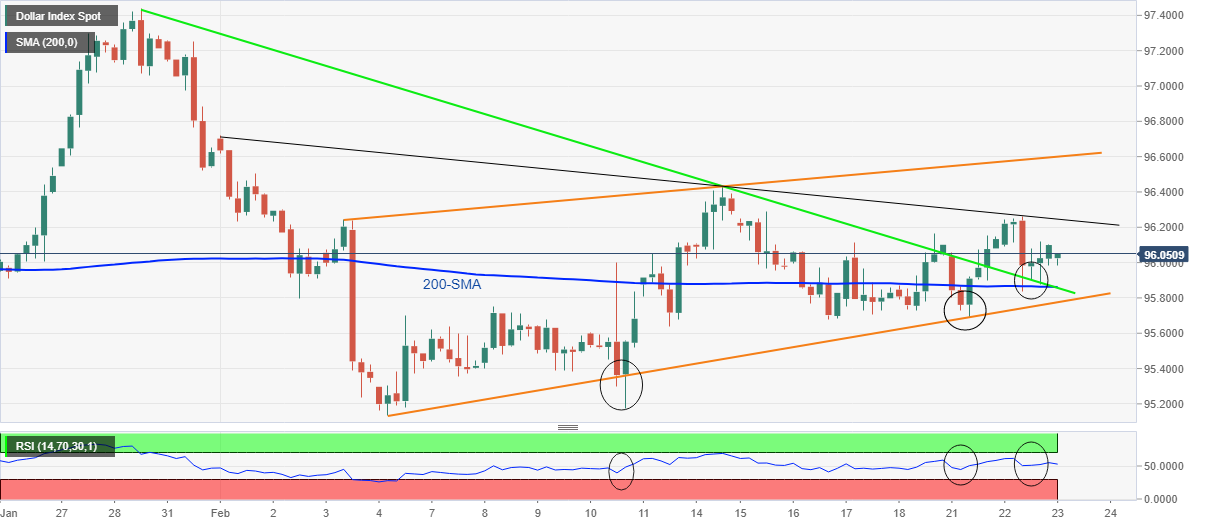
Trend: Further upside expected
| Raw materials | Closed | Change, % |
|---|---|---|
| Brent | 93.38 | -1.21 |
| Silver | 24.095 | 0.18 |
| Gold | 1898.45 | -0.71 |
| Palladium | 2341.97 | -1.97 |
- EUR/GBP is oscillating in a narrow range of 0.8330-0.8345 ahead of BOE monetary policy report hearings.
- Investors have underpinned the pound against the euro amid the geopolitical jitters.
- Britain has imposed sanctions on Russia against its aggression on Ukraine.
EUR/GBP is oscillating in a narrow range of 0.8330-0.8345 in the Asian session, as investors are eyeing the monetary policy report hearings from the Bank of England (BOE) on Wednesday. The cross has remained volatile in the last few trading sessions on the obscurity over the headlines from the Russia-Ukraine tussle. However, market participants have been underpinning the pound against the shared currency as the latter one may be relatively more impacted by the escalation of sanctions on Russia.
Both economies are imposing sanctions against the aggression of Russia on Ukraine. On Tuesday, British foreign minister Liz Truss said in a Twitter post that their administration will announce new sanctions on Moscow in response to their breach of international law and attack on Ukraine's sovereignty and territorial integrity.
Later, Britain hit five Russian banks: Rossiya bank, IS bank, General bank, Promsvyazbank, and Black Seabank with sanctions while Germany barricaded a new gas pipeline from Russia despite the fact that Germany banks upon Russia for its domestic gas usage. It is worth mentioning that Russia accounts for 65% of Germany’s natural gas imports and almost 40% of the EU, as per The New Statesman.
Meanwhile, the European docket is full of events on Wednesday, starting from the speech of European Central Bank (ECB)’s member Frank Elderson and Vice President Luis De Guindos. Moreover, the Core Consumer Price Index (CPI) will be released by Eurostat. While the BOE member Silvana Tenreyro will provide insights on their decision-making for upcoming monetary policy.
- NZD/USD remains on the front foot, refreshing five-week high at the latest.
- RBNZ’s Orr cites capacity constraints, rising inflation expectations to back the third consecutive rate lift.
- 100-DMA, January’s top on the bull’s radar amid firmer MACD, clear break of 50-DMA, previous resistance from October 2021.
NZD/USD justifies another bullish boost, recently from RBNZ Governor Adrian Orr while refreshing the multi-day top to 0.6777, up 0.56% intraday during Wednesday’s Asian session.
Reserve Bank of New Zealand (RBNZ) matched wide market forecasts as it inflated the benchmark rate by 0.25% to 1.0% during the latest monetary policy meetings. While justifying the move, RBNZ Governor Orr said, “Inflation expectations for 5-10 years are anchored, but have risen recently.”
Read: RBNZ’s Orr: Capacity pressures in the economy are tightening still
Technically, a clear upside break of 50-DMA and a descending trend line from October 2021, now support around 0.6730, joins the bullish MACD signals to keep NZD/USD buyers hopeful.
That said, the 0.6800 threshold lures intraday bulls before directing them to the 100-DMA and January’s peak, respectively near 0.6860 and 0.6890.
On the contrary, pullback moves remain elusive beyond 0.6730, a break of which will direct NZD/USD bears to December 2021 low surrounding 0.6700.
Even if the quote drops below 0.6700, an ascending support line from January 28, near 0.6630, will be crucial for NZD/USD sellers to retake controls.
NZD/USD: Daily chart

Trend: Further upside expected
Reserve Bank of New Zealand (RBNZ) Governor Adrian Orr is speaking at the February post-monetary policy decision press conference on Wednesday, noting the following.
Cannot rule out 50 bps hikes in future, rates do need to rise significantly.
Will take our time, step by step.
Capacity pressures in the economy are tightening still.
Forecast house price fall is small relative to past increases.
Amount of tightening through bond sales is very small, its all about the OCR.
more to come ...
Separately, the central bank’s Chief Economist Yuong Ha said that they are “seeing signs house prices are declining, moving back to more sustainable levels.”
NZD reaction
NZD/USD keeps pushing higher on the comments from Governor Orr, currently trading at the daily highs near 0.6775, up 0.62% on the day.
The pair tests five-week highs of on RBNZ’s hawkish rate hike decision.
- Market sentiment dwindles as traders seek fresh clues over Russia-Ukraine issues, Fedspeak turns softer of late.
- S&P 500 Futures part ways from Wall Street, Japan holiday stops US Treasury bond moves.
- Light calendar keeps risk catalysts on the driver’s seat.
Risk appetite improves during the mid-Asian session on Wednesday as traders jostle over the odds of Ukraine diplomacy and the latest Fedspeak.
On late Tuesday, the US ruled out the scope of a summit between US President Joe Biden and his Russian counterpart Vladimir Putin. On the same line were comments from US Secretary of State Antony Blinken’s rejection of the need for Thursday’s meeting with Russian Foreign Minister Sergei Lavrov.
However, US President Biden’s comments like, “We have no intention of fighting Russia,” seem to have played the role of turning down the fears of a full-fledged war between the West and Moscow. Additionally, comments from Japan’s Prime Minister (PM) Fumio Kishida, calling on Russia to return to diplomatic means, also allow bears to take a breather.
While portraying the mood, S&P 500 Futures consolidate recent losses with 0.55% intraday gains around 4,235 while the US Treasury yields remain inactive, due to off in Japan, at around 1.94% after rising around 2.0% daily in the previous day. It’s worth noting that Wall Street kept the red by the end of Tuesday’s North American trading session.
Read: Stock bounce likely to be temporary
It’s worth noting that strong US data and geopolitics might have weighed on the US equities as the Treasury yields rebounded during the late hours of Tuesday. However, comments from Atlanta Fed’s Chief Executive Officer (CEO) Raphael W. Bostic seem to have helped the equities afterward.
Fed’s Bostic said, “Fed is going to "let the data guide us" in upcoming decisions.” The policymaker’s comments were in line with Monday’s statements from Federal Reserve Board Governor Michelle Bowman who mentioned, “It is too soon to tell if the Fed should hike 25 or 50bps in March.”
Given the light calendar and the market’s indecision over the next moves concerning Russia, even as the latest Western sanctions challenge the sentiment, investors and traders may witness sluggish moves on Wednesday. Though, geopolitical headlines are the key to observe.
Also read: Gold Price Forecast: XAU/USD hovers around $1,900 as Russia-linked woes escalate
| Time | Country | Event | Period | Previous value | Forecast |
|---|---|---|---|---|---|
| 00:30 (GMT) | Australia | Wage Price Index, y/y | Quarter IV | 2.2% | 2.4% |
| 00:30 (GMT) | Australia | Wage Price Index, q/q | Quarter IV | 0.6% | 0.7% |
| 00:30 (GMT) | Australia | Construction Work Done | Quarter IV | -0.3% | 2.5% |
| 01:00 (GMT) | New Zealand | RBNZ Interest Rate Decision | 0.75% | 1% | |
| 02:00 (GMT) | New Zealand | RBNZ Press Conference | |||
| 07:00 (GMT) | Germany | Gfk Consumer Confidence Survey | March | -6.7 | -6.3 |
| 09:00 (GMT) | Switzerland | Credit Suisse ZEW Survey (Expectations) | February | 9.5 | |
| 10:00 (GMT) | Eurozone | Harmonized CPI | January | 0.4% | 0.3% |
| 10:00 (GMT) | Eurozone | Harmonized CPI ex EFAT, Y/Y | January | 2.6% | 2.3% |
| 10:00 (GMT) | Eurozone | Harmonized CPI, Y/Y | January | 5% | 5.1% |
| 17:00 (GMT) | United Kingdom | MPC Member Tenreyro Speaks |
- NZD/JPY takes the bids to refresh two-week high as RBNZ increases benchmark rate by 0.25%.
- Clear break of trend line, 61.8% Fibonacci retracement joins bullish MACD signal to favor buyers.
- Monthly tests immediate upside, key SMA will act as additional downside filters in case of fresh declines.
NZD/JPY extends the previous day’s rebound from a one-week low while refreshing a fortnight high around 77.85, up 0.50% intraday during Wednesday’s Asian session.
The cross-currency pair’s latest advances could be linked to the Reserve Bank of New Zealand’s (RBNZ) rate hike. That said, the New Zealand central bank matched market forecasts of a 0.25% increase in its benchmark rate to 1.0%, marking it the third consecutive hawkish play.
Read: Breaking: RBNZ hikes by 25bps, NZD/USD attempts to break 0.6750
Following the RBNZ showdown, NZD/JPY crossed a downward sloping trend line from early January, as well as the 61.8% Fibonacci retracement (FIbo.) of the last month’s south-run.
The breakout of previously crucial resistance levels also gains support from the bullish MACD signals to suggest the quote’s further advances.
However, the monthly high of 78.00 challenges the intraday buyers ahead of directing them to the mid-January’s top near 78.85, a break of which will recall the last month’s peak of 79.25 on the chart.
Meanwhile, pullback moves may initially aim for the 61.8% Fibo. and the resistance-turned-support line, respectively around 77.70 and 77.60.
Following that, the 200-SMA and 100-SMA will challenge the NZD/JPY bears near 76.90 and 76.70 in that order.
NZD/JPY: Four-hour chart
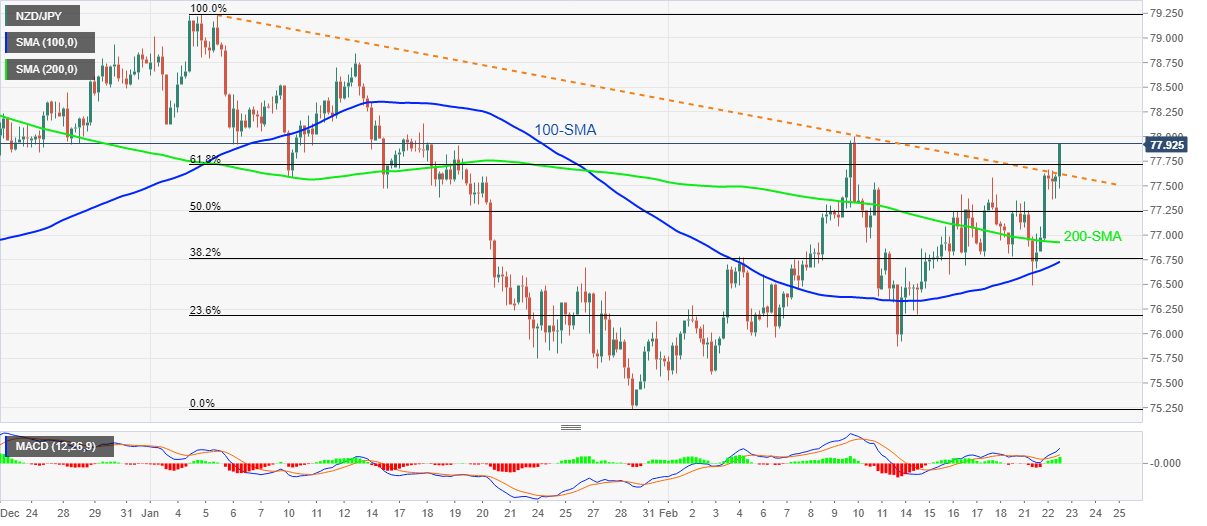
Trend: Further upside expected
In recent trade today, the People’s Bank of China (PBOC) set the yuan (CNY) at the strongest level since Jan. 26, at 6.3313 vs. last close 6.3271 and vs, the estimate of 6.3355.
About the fix
China maintains strict control of the yuan’s rate on the mainland.
The onshore yuan (CNY) differs from the offshore one (CNH) in trading restrictions, this last one is not as tightly controlled.
Each morning, the People’s Bank of China (PBOC) sets a so-called daily midpoint fix, based on the yuan’s previous day closing level and quotations taken from the inter-bank dealer.
- AUD/NZD skids below 1.0700 as a rate hike by RBNZ has underpinned the kiwi against the aussie.
- A 25 bps interest rate hike is in line with the market consensus.
- Kiwi’s inflation at 5.9% is significantly higher than the average range of 1-3% in the last two decades.
The AUD/NZD pair has slipped below 1.0700 as the Reserve Bank of New Zealand (RBNZ) raised its benchmark rates by 25 basis points (bps). The cross has remained in the positive territory since the first tick of the Asian session. The asset has rebounded after the successful retest of Tuesday’s low around 1.0700. However, it has eased its Wednesday’s gains now and heading for more weakness.
Should investors be cognizant that the RBNZ has raised its borrowing rates by 0.75% in the last six months? And, New Zealand’s central bank was already expected to come with one more rate hike of 25 bps for Wednesday’s monetary policy meeting as per the market consensus.
To contain the soaring inflation in the kiwi region, the RBNZ highly needed to bank upon the interest rate hike as the last resort. The latest print of kiwi’s inflation at 5.9% is significantly higher than the average range of 1-3% in the last two decades. However, the geopolitical jitters amid the Russia-Ukraine tussle have jeopardized the monetary policy decision-making for various central banks.
Meanwhile, the Australian Bureau of Statistics has reported the quarterly and yearly Wage Price Index data in the Asian session. The quarterly Wage Price Index has remained in line with the estimates at 0.7% but above the previous print of 0.6% while the yearly one comes lower than the market consensus of 2.4% at 2.3% but higher than the previous figure of 2.2%.
- NZD/USD takes the bids to refresh multi-day high during seven-day uptrend.
- RBNZ meets 0.25% rate-hike expectations, cites LSAP bond holdings to put upward pressure on rates.
- Market sentiment dwindles as traders await fresh clues on Russia-Ukraine strory after latest Western sanctions.
- Recently softer Fedspeak highlight each incoming US data for clear directions, geopolitical headlines are the key.
NZD/USD rises 25 pips to recently around 0.6765, up 0.45% intraday, as the Reserve Bank of New Zealand (RBNZ) announced third consecutive rate hike on early Wednesday.
Although the RBNZ matched wide marked expectations with its 0.25% rate-hike to 1.0% level, the comments line, “Sales of the bank’s LSAP bond holdings may put some upward pressure on longer-term interest rates,” seem to keep policy hawks hopeful.
Read: Breaking: RBNZ hikes by 25bps, NZD/USD attempts to break 0.6750
On a different page, recently easing odds of a diplomatic solution to the Russia-Ukraine tussles offered the latest blow to the market’s risk appetite as the US ruled out the scope of a summit between US President Joe Biden and his Russian counterpart Vladimir Putin. On the same line were comments from US Secretary of State Antony Blinken’s rejection of the need for Thursday’s meeting with Russian Foreign Minister Sergei Lavrov.
On the contrary, US President Biden’s comments like, “We have no intention of fighting Russia,” seem to have played the role of turning down the fears of a full-fledged war between the West and Moscow.
Read: White House: A summit between Biden and Putin is 'certainly not in the plans' at this point
At home, New Zealand (NZ) battles with the recently higher covid numbers but stays on the path to gradually ease activity restrictions and international boundaries. “There are a record 3297 new community cases of Covid-19 in New Zealand today - as the country moves closer to phase 3 of the Government's Omicron response,” said NZ Herald. The news also quotes the NZ Health Ministry Statement saying, “One hundred and seventy-nine people, also a record, are in hospital including one person in intensive care.”
Elsewhere, preliminary readings of the US Markit PMIs for February showed the successful transition of the world’s largest economy from the covid-led. However, the Fed policymakers remain cautious while pushing for the 0.50% rate hike. Recently, Dr. Raphael W. Bostic, Chief Executive Officer of the Federal Reserve Bank of Atlanta, said, “Fed is going to "let the data guide us" in upcoming decisions.” The policymaker’s comments were in line with Monday’s statements from Federal Reserve Board Governor Michelle Bowman who mentioned, “It is too soon to tell if the Fed should hike 25 or 50bps in March.”
While portraying the mood, S&P 500 Futures consolidate recent losses with 0.5% intraday gains while the US Treasury yields remain inactive, due to off in Japan, at around 1.94% after rising around 2.0% daily in the previous day.
Looking forward, comments from RBNZ Governor Adrian Orr, up for publishing at 02:00 AM GMT, will entertain NZD/USD traders for now. Following that, the risk catalysts and the Fedspeak are likely to provide fresh impulse amid a light calendar afterward.
Technical analysis
Following the RBNZ verdict, the NZD/USD pair stays above the key resistance confluence comprising 50-DMA and a descending trend line from October 2021, now support around 0.6730. The bullish breakout joins upbeat RSI and MACD signals to keep buyers hopeful of challenging the 0.6800 round figure. However, the 100-DMA and January’s peak, respectively near 0.6860 and 0.6890, will challenge the bulls afterward.
Alternatively, pullback moves remain elusive beyond 0.6730, a break of which will direct NZD/USD bears to December 2021 low surrounding 0.6700.
The Reserve Bank of New Zealand met market expectations on Wednesday by lifting the cash rate by 25bps.
Of most interest for the market in the statement and press conference will be the Bank's forecast OCR track and details regarding how it plans to run down its LSAP holdings.
Key notes
- RBNZ says more tightening needed.
- Says also agreed to commence the gradual reduction of the reserve bank’s bond holdings under the large scale asset purchase,LSAP, programme.
- Says agreed it remains appropriate to continue reducing monetary stimulus.
- Says some short-term economic disruption is expected given the current growing covid-19 health challenge.
- Says economic capacity pressures have continued to tighten
- Says headline Consumer Price Inflation is well above the reserve bank’s target range but will return towards the 2 percent midpoint over coming years.
- RBNZ says the committee agreed that further removal of monetary policy stimulus is expected over time.
- Says headline cpi inflation is well above the reserve bank’s target range but will return towards the 2 per cent midpoint over coming years.
- Says employment is now above its maximum sustainable level.
- Says a broad range of economic indicators highlighting that the New Zealand economy continues to perform above its current potential.
- Says managed sales of bond holdings, in addition to not investing the proceeds of maturities, were most consistent with achieving their mandate over time.
- Says intends to commence bonds sales in July.
OCR projections
- Sees OCR at 1.49% in June 2022 (pvs 1.51%).
- Sees OCRat 2.57% in March 2023 (pvs 2.3%).
- Sees TWI NZD at around 71.6% in March 2023 (pvs 75.1%).
- Sees annual Consumer Price Index 3.2% by march 2023 (pvs 2.9%).
- Sees OCR at 2.84% in June 2023 (pvs 2.4%).
- Sees OCR at 3.35% in March 2025.
RBNZ Minutes
Committee also affirmed that it was willing to move the OCR in larger increments if required over coming quarters.
OCR is expected to peak at a higher level than assumed at the November statement
Sales of the bank’s LSAP bond holdings may put some upward pressure on longer-term interest rates.
Many members saw this as a finely balanced decision whether to move the OCR up by 25 or 50 basis points.
Committee agreed that higher interest rates were consistent with house prices becoming more sustainable.
The impulse to growth from fiscal support is now ebbing and will wane.
Committee reached a consensus to not reinvest the proceeds of any upcoming LSAP bond maturities.
NZD/USD update
NZD/USD was trapped above old hourly highs acting as support near 0.6730 ahead of the event and has subsequently popped in to test the 0.6750 resistance on a more hawkish outcome than what might have been expected in the detail.
The following is a top-down analysis of NZD/USD drawn ahead of the event with an emphasis on the downside from a long-term point of view while below the 0.6770s:
- NZD/USD Price Analysis: RBNZ in focus, key levels and market structure to watch
Why the RBNZ matters to traders
The Reserve Bank of New Zealand (RBNZ) holds monetary policy meetings seven times a year, announcing their decision on interest rates and the economic assessments that influenced their decision. The central bank offers clues on the economic outlook and future policy path, which are of high relevance for the NZD valuation. Positive economic developments and an upbeat outlook could lead the RBNZ to tighten the policy by hiking interest rates, which tends to be NZD bullish. The policy announcements are usually followed by Governor Adrian Orr’s press conference.
AUD/USD was pressured slightly in recent trade following the Wage Price Index released by the Australian Bureau of Statistics is an indicator of labour cost inflation and of the tightness of labour markets.
The Reserve Bank of Australia pays close attention to it when setting interest rates. A high reading is positive (or bullish) for the AUD, while a low reading is seen as negative (or bearish). The data arrived with Australia Wage Price Index for the fourth quarter for 2021 +0.7% vs. expected 0.7% and year on year, 2.3% vs 2.4% expected. Following the data, the odds of an RBA rate hike in June dropped below 50%.
AUD/USD M5 chart

The AUD dropped vs the dollar o the release as seen in the above five minute chart.
- XAG/USD has rebounded from $24.10 as safe-haven appeal underpins bullions against the greenback.
- Western leaders might escalate sanctions further if Russia doesn’t call their troops back to their bases.
- The market may extend uncertainty as Blinken-Lavrov's meeting call-off.
Silver (XAG/USD) retreats from the lows of $24.10 in the Asian session as US Secretary of State Antony Blinken abandons meeting with Russian Foreign Minister Sergey Lavrov. The move from the former is the outcome of Moscow’s arbitrariness. The Kremlin has underestimated the threats of imposing sanctions from the Western leaders. This has underpinned the risk-off impulse in the markets and silver jumps eventually.
Russian leader Vladimir Putin labeled two regions in eastern Ukraine as ‘Independent’, which confirmed the warnings from the West that Russia is planning to invade Ukraine. Meanwhile, Moscow also built troops in those regions after getting a green signal and support from separatist leaders. This had forced Western leaders to come out with sanctions on Russia. Adding to that, the Western leaders might escalate sanctions further if Russia doesn’t call their troops back to their bases.
The US dollar index (DXY) is consolidating in a narrow range of 30 pips in the Asian session as it fails to capitalize upon the call-off of the Blinken-Lavrov meeting. Meanwhile, the odds of an aggressive monetary policy by the Federal Reserve (Fed) are losing traction, which has underpinned the silver against the greenback.
XAG/USD Technical Analysis
On a four-hour scale, Silver (XAG/USD) is trading in a rising channel in which every pullback towards the lower trendline is considered as an opportunity to initiate long positions. The 50 and 200 periods Exponential Moving Average (EMA) are trading higher, which indicates that bulls are confident for more upside. The Relative Strength Index (RSI) (14) is comfortably holding above 60.00, showing no signs of divergence and overbought.
-637811720375435089.png)
- GBP/JPY holds onto the previous day’s bounce off one-week low, retreats from daily top of late.
- Firmer Momentum, sustained trading beyond 200-SMA hints further upside.
- Bears need validation from 155.00 before retaking controls.
GBP/JPY edges higher around the weekly top, sidelined near 156.35-40 during Wednesday’s Asian session.
In doing so, the cross-currency pair battles 50-SMA resistance around 156.50 to justify the upside momentum portrayed by the Momentum indicator, as well as the pair’s ability to stay beyond the 200-SMA.
However, the upper line of a three-week-long symmetrical triangle, near 157.00 by the press time, challenges short-term advances of the GBP/JPY.
In a case where the quote rises past-157.00, the monthly high of 158.06 and October 2021 peak surrounding 158.25 can act as buffers during the rally targeting the 16.00 threshold.
On the flip side, pullback moves may initially aim for the 200-SMA level near 155.85 before directing the GBP/JPY sellers towards the stated triangle’s support line, near 155.50 at the latest.
Even if the pair drops below 155.50, the early February lows near 155.00 will offer an additional downside filter to the traders.
GBP/JPY: Four-hour chart
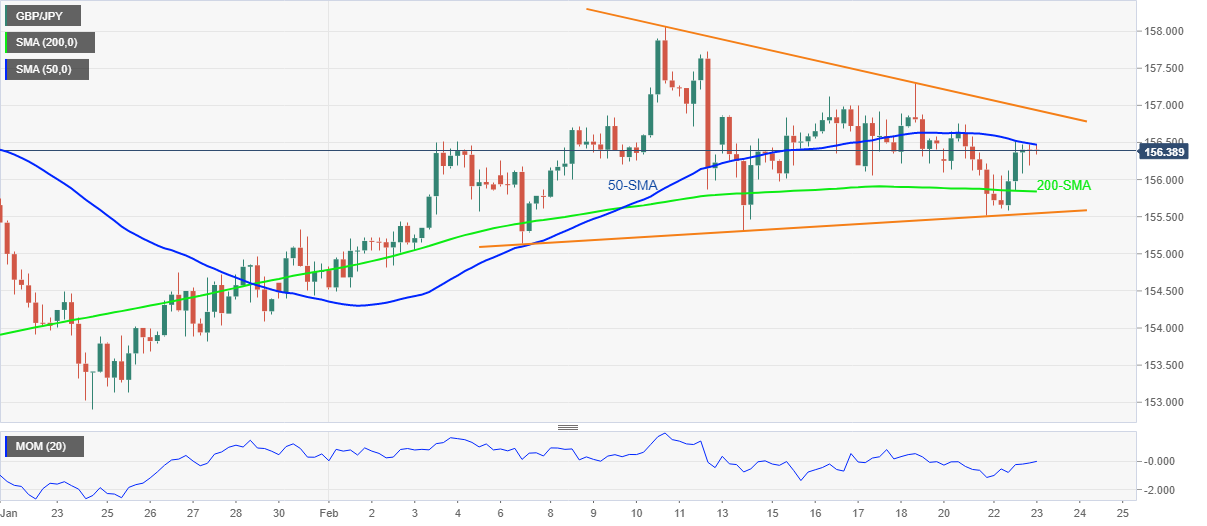
Trend: Further upside expected
- Gold prices struggle for clear direction after stepping back from eight-month high.
- Technical resistance join indecision over Russian invasion of Ukraine, Fed’s next action to restrict immediate moves.
- US turns down Blinken-Lavrov meeting, Biden-Putin summit as the West sanctions Moscow.
- Gold Price Forecast: Ukraine in the eye of the storm, fears boost safe-haven assets
Spot gold (XAU/USD) remains mildly offered around $1,900 during Wednesday’s Asian session, following the U-turn from the highest levels since June 2021 flashed the previous day.
The yellow metal’s recent inaction could be linked to the absence of Japanese traders, which indirectly affects US bond demand in Asia and restricts catalysts for gold. Also testing the gold traders are recently mixed concerns over the Fed’s next performance and cautious mood over Russia-Ukraine conditions as the West gets aggressive in sanctioning Moscow.
Recently receding odds of a diplomatic solution to the Russia-Ukraine tussles offered the latest blow to the market’s risk appetite, as well as favor gold buyers, as the US ruled out the scope of a summit between US President Joe Biden and his Russian counterpart Vladimir Putin. On the same line were comments from US Secretary of State Antony Blinken’s rejection of the need for Thursday’s meeting with Russian Foreign Minister Sergei Lavrov.
On the contrary, US President Biden’s comments like, “We have no intention of fighting Russia,” seem to have played the role of turning down the fears of a full-fledged war between the West and Moscow.
Elsewhere, Dr. Raphael W. Bostic, Chief Executive Officer of the Federal Reserve Bank of Atlanta, said, “Fed is going to "let the data guide us" in upcoming decisions.” The policymaker’s comments were in line with Monday’s statements from Federal Reserve Board Governor Michelle Bowman who mentioned, “It is too soon to tell if the Fed should hike 25 or 50bps in March.”
Against this backdrop, S&P 500 Futures consolidate recent losses with 0.5% intraday gains while the US Treasury yields remain inactive at around 1.94% after rising around 2.0% daily in the previous day.
Moving on, Fedspeak and geopolitical can keep the driver’s seat but the sluggish markets may allow gold to pare some of the latest gains.
Technical analysis
Overbought RSI joined a 17-month-old resistance line to trigger gold’s pullback from multi-day high on Tuesday.
Even so, the metal remains above November 2021 peak, as well as backed by a 13-day-old support line near $1,877, which in turn keeps gold buyers hopeful of overcoming the immediate hurdle surrounding $1,910. Also acting as an upside filter is November 2021 top surrounding $1,917.
Gold: Daily chart
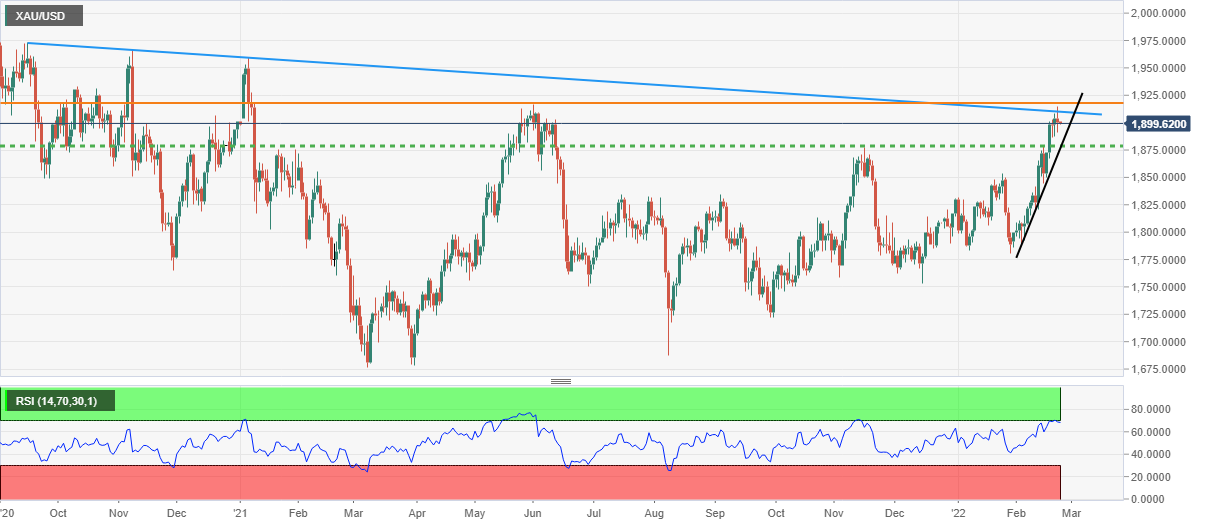
Meanwhile, a convergence of the previous resistance line from January 20 joins an upward sloping trend line from February 11 to highlight $1,890 as the immediate key support.
Following that, 50-DMA and a three-week-long rising trend line, respectively near $1,872 and $1,857, will lure the gold sellers before confirming their dominance.
Gold: Four-hour chart
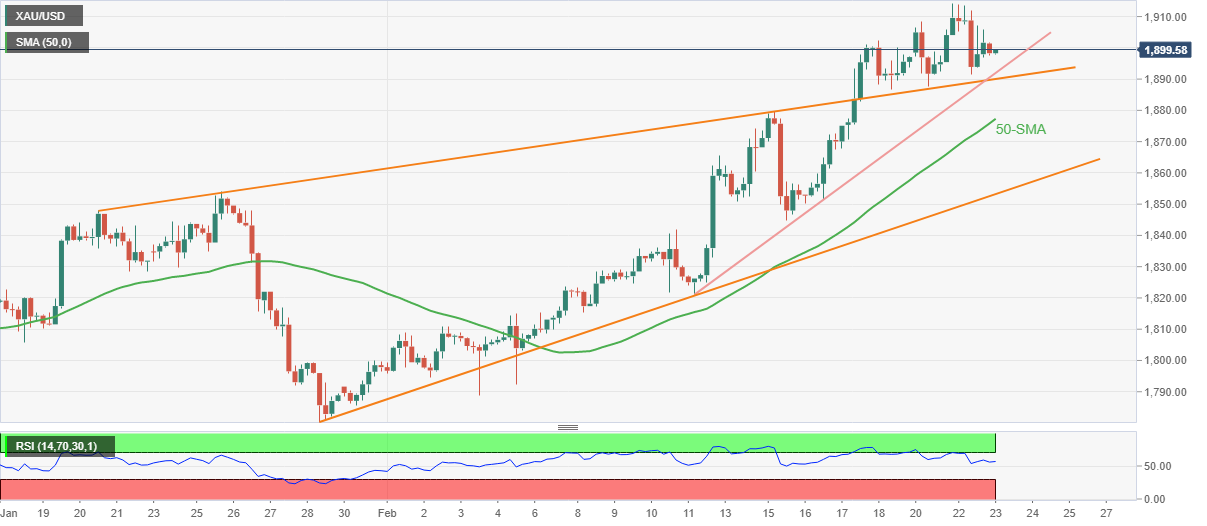
- NZD/USD is holding in a tight range into the RBNZ with breakout points above 0.6750 and below 0.6730 eyed.
- The longer-term charts are bearish, so the RBNZ will need to surprise if the bulls are to stay in control.
NZD/USD is the focus and a 25bp rate hike should reinforce NZD's carry status against the low-yielders, while the prospects of a 50bp hike increase would be an added benefit and will be expected to pole volt 0.6750.
The following is an analysis of the longer-term charts and the near term from an hourly perspective heading into the event.
NZD/USD weekly chart
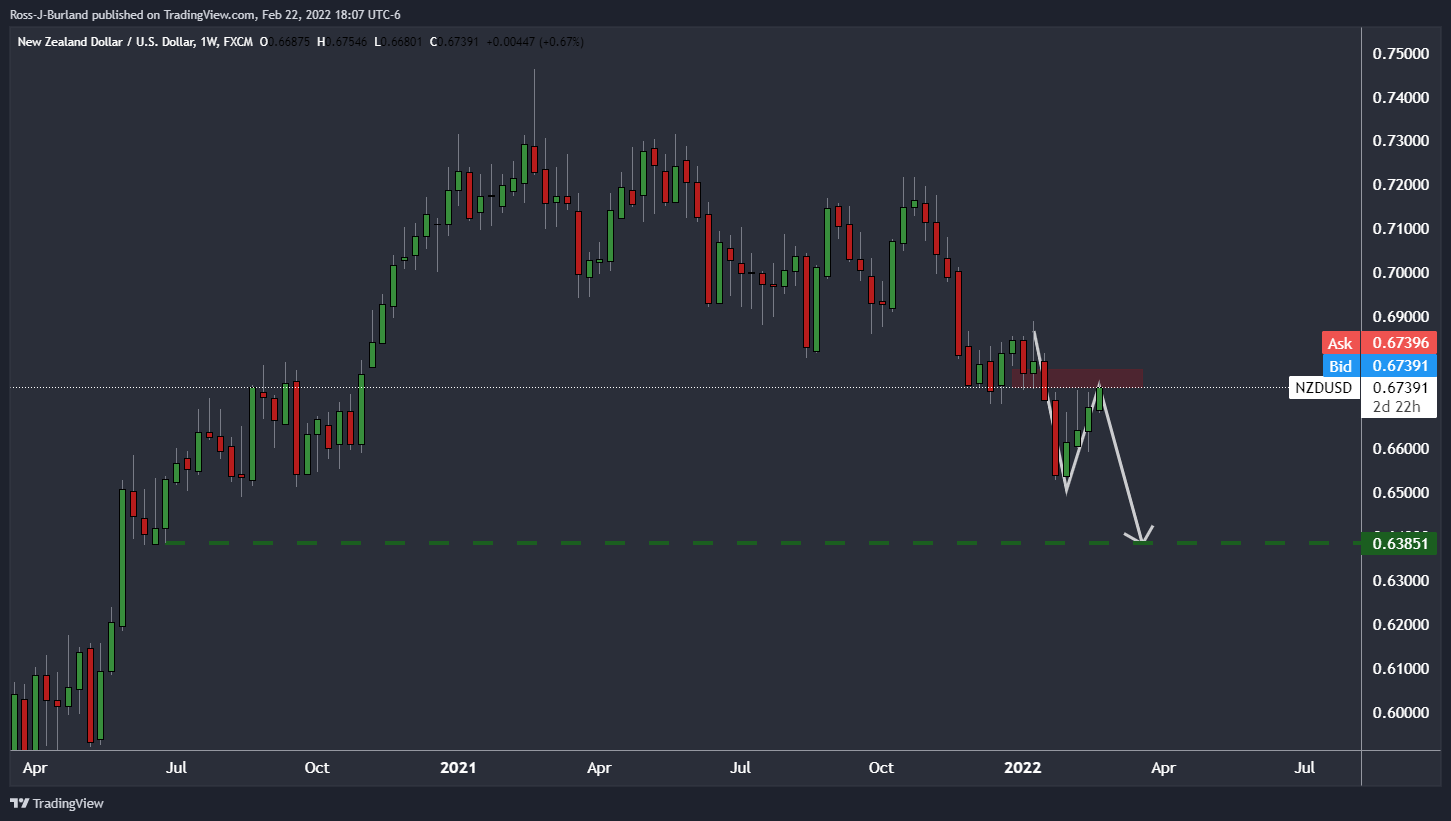
The weekly chart is bearish while below the M-formation's neckline resistance between 0.6730 and the 0.6770s. An extension to the downside could be on the cards for the weeks ahead with 0.6385 eyed as a -61.8% Fibo target and the confluence with prior lows.
NZD/USD daily chart
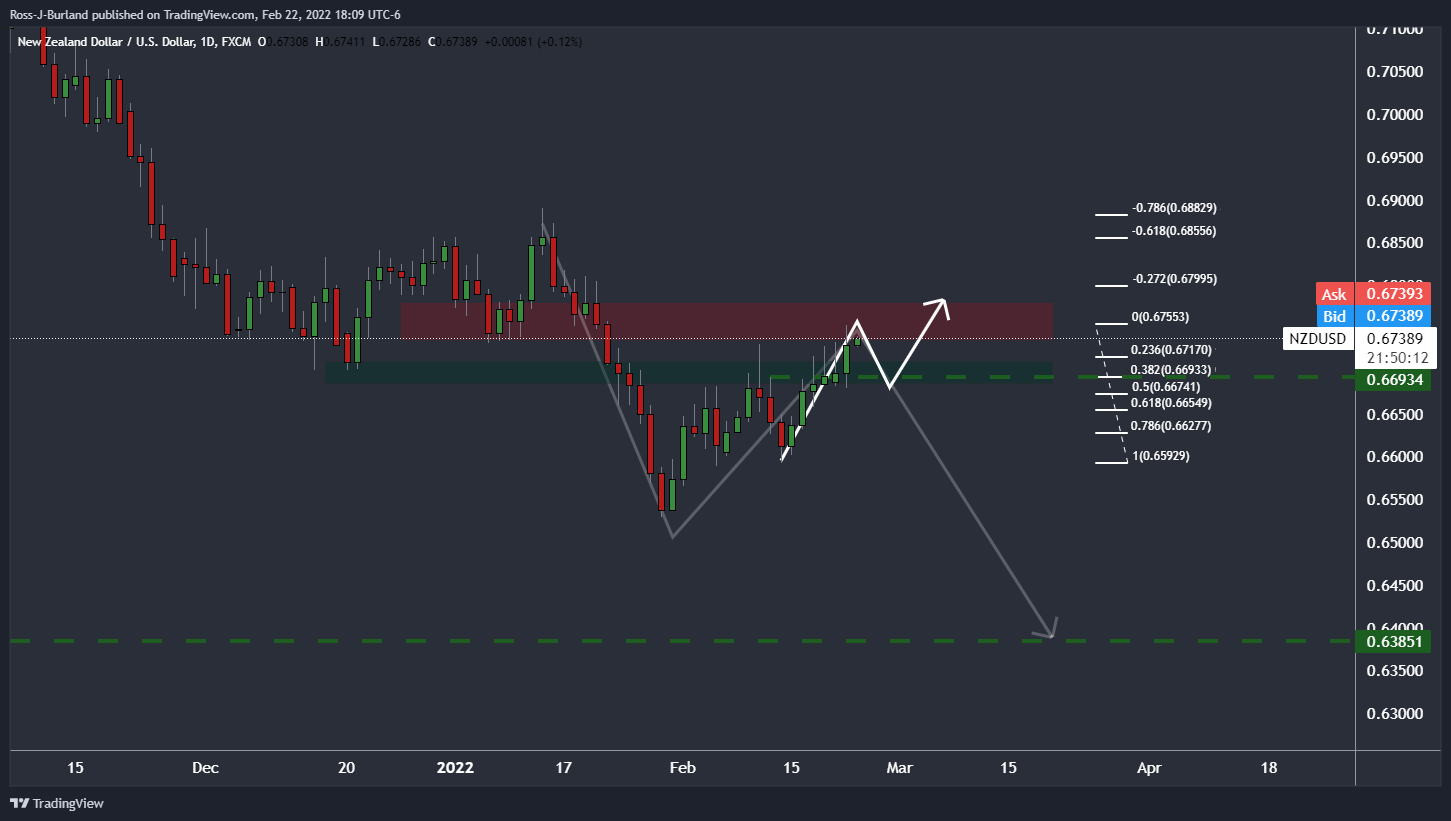
The daily chart shows the price eating its way into resistance but is overextended and could be due for a correction in coming sessions. The 38.2% Fibo meets with prior structure near 0.6690. If this were to hold, then the bulls could seek to engage at a discount and target a higher test in the weekly resistance towards the 0.6770s.
NZD/USD H1 chart
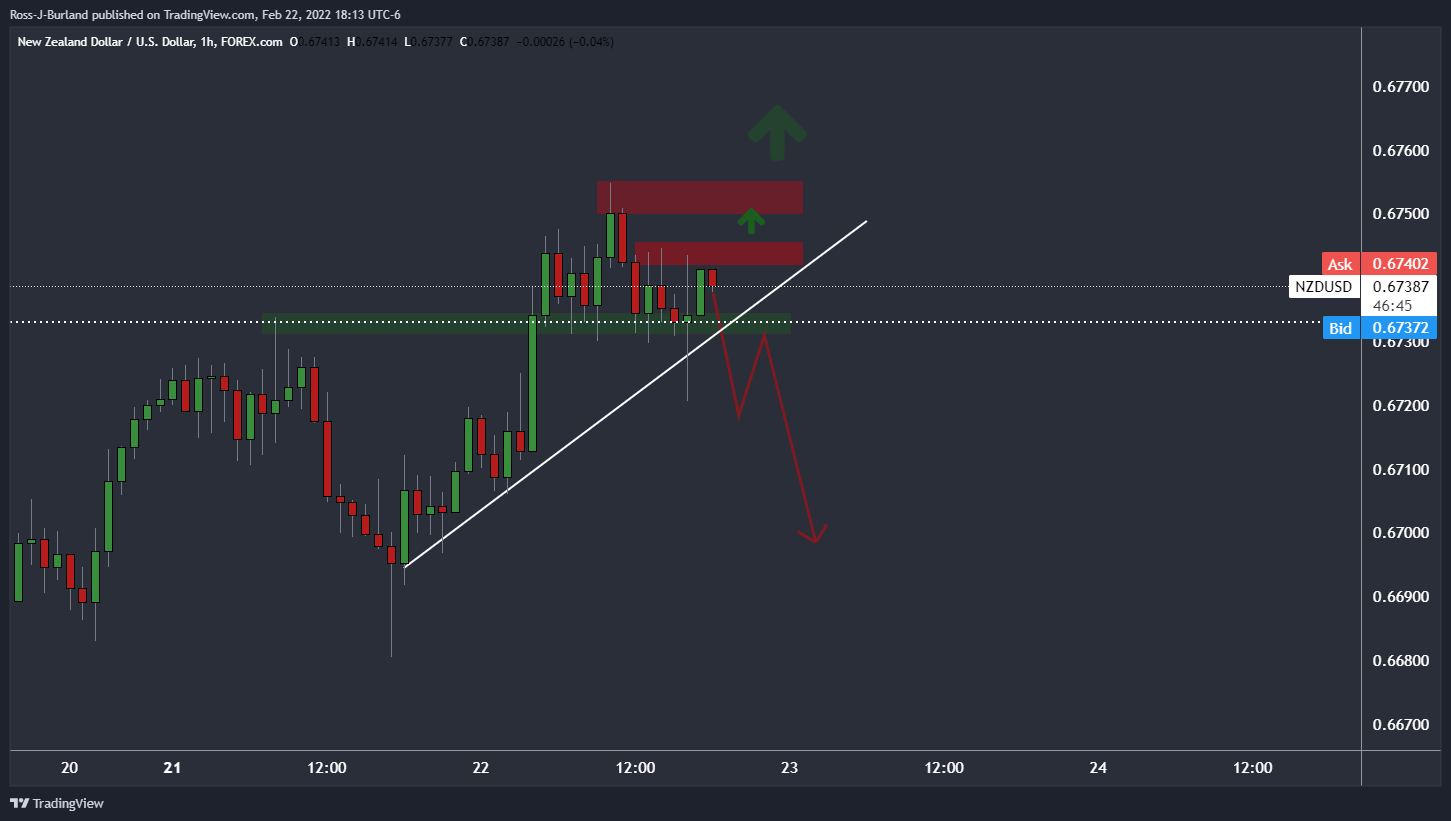
Should there be an uber hawkish surprise from the RBNZ, then a break of 0.6750 opens risk for a deeper test of the weekly resistance in the 0.6770s.
- Bulls are required to push GBP/USD above 1.3595 for further upside.
- Flat 50 and 100 EMAs are indicating a reversal after a downside move.
- The RSI (14) in 40.00-60.00 suggests that the asset is still inside the woods.
The GBP/USD pair is juggling in a narrow range of 1.3576-1.3604 after a juggernaut rally from Tuesday's low of 1.3538.
On an intraday scale, the cable is forming a bullish pennant pattern which signals a consolidation phase after a strong upside move and leads to a further upside in the coming trading sessions. Usually, the consolidation phase denotes the initiation of bids by investors who fail to enter in the initial rally or those investors who place bids, which prefer to enter in an auction after the establishment of a bullish bias.
The 50-period and 100-period Exponential Moving Averages (EMA) have turned flat after remaining downward in the previous trading periods. This signals that the asset is not bearish anymore and a reversal is on the cards.
The Relative Strength Index (RSI) (14) is oscillating in a 40.00-60.00 range, which points over consolidation in the cable.
For an upside momentum, bulls are required to push GBP/USD above the highs build in the early Asian session around 1.3595. The asset may find resistances near Tuesday’s high at 1.3604 and Monday’s average traded price at 1.3617 respectively.
On the flip side, bulls could lose their grip if the major slips 50-EMA, which is hovering around 1.3580 and additional losses could be witnessed towards 1.3568, from where the lower trendline is marked and Tuesday’s low of 1.3538 respectively.
GBP/USD 15-minute chart
-637811694487580063.png)
| Pare | Closed | Change, % |
|---|---|---|
| AUDUSD | 0.7218 | 0.42 |
| EURJPY | 130.321 | 0.41 |
| EURUSD | 1.13257 | 0.13 |
| GBPJPY | 156.326 | 0.2 |
| GBPUSD | 1.35854 | -0.1 |
| NZDUSD | 0.67332 | 0.5 |
| USDCAD | 1.27701 | 0.16 |
| USDCHF | 0.92158 | 0.67 |
| USDJPY | 115.07 | 0.3 |
Early Wednesday at 01:00 GMT market sees the key monetary policy decision by the Reserve Bank of New Zealand (RBNZ) amid hopes of a hawkish play.
Despite the return of higher covid numbers at home, firmer economics and broad inflation fears push the RBNZ policymakers towards a third consecutive 0.25% increase to the benchmark interest rate, currently around 0.75%.
Although such a rate-hike is already much-talked, recent geopolitical tensions surrounding Russia and Ukraine join some optimists calling for 50 basis points (bps) of a rate-lift to make today’s RBNZ Interest Rate Decision interesting for the NZD/USD traders.
Also in the publishing line are the economic projections and Governor Adrian Orr’s speech to watch.
Ahead of the event, Australia and New Zealand Banking Group (ANZ) said,
Market expectations continue to favor a 25bp (rather than 50bp) RBNZ OCR hike today; if delivered, that should provide a fairly solid base for the NZD on the view that measured hikes will be more digestible for the economy and are less likely to deliver a hard landing.
On the same line, TD Securities mentioned,
We expect the RBNZ to lift the cash rate by 25bps but we do acknowledge there is a chance the Bank could hike by 50bps - the Bank's Nov'21 OCR forecast track implied a 50bps hike in Feb'22 and price pressures remain.
Considering the market consensus, FXStreet’s Dhwani Mehta said,
On the interest rate decision, NZD/USD could see some initial reaction, depending on the dovish or hawkish outcome. The currency pair could see a ‘sell the fact’ trade unfold if the RBNZ delivers the expected 25 bps hike. The kiwi could correct sharply towards 0.6600. On a 50 bps surprise rate increase, the pair could receive a much-needed shot in the arm, which may trigger a fresh upswing towards January highs above 0.6800.
How could it affect NZD/USD?
NZD/USD grinds higher at monthly top following the six-day winning streak during the early Asian session on Wednesday.
The kiwi pair’s recent up-moves could be linked to the market’s hawkish hopes from the RBNZ, as well as the US dollar’s pullback amid mixed concerns over the Fed’s next moves. However, the bulls remain challenged by the faster spread of geopolitical fears.
Hence, the bulls keep reins ahead of the key event but the road to the north seems rather bumpy.
That said, a 25 bps rate hike is a well-known and priced-in action from the RBNZ policymakers. As a result, the NZD/USD prices may fail to extend the latest advances on either a negative surprise or matching the market forecasts. However, a 0.50% rate lift can help the pair buyers to consolidate heavy losses marked in November.
Other than the rate decision, RBNZ Governor Orr’s comments will also be important for near-term NZD/USD direction as hints for faster monetary policy tightening, or justification of the latest moves, can favor the pair buyers even if the rate hike fails to impress them on the initial readings.
Technically, NZD/USD remains stable above the key resistance confluence comprising 50-DMA and a descending trend line from October 2021, now support around 0.6730. The bullish breakout joins upbeat RSI and MACD signals to keep buyers hopeful of challenging the 0.6800 round figure. However, the 100-DMA and January’s peak, respectively near 0.6860 and 0.6890, will challenge the bulls afterward. Alternatively, pullback moves remain elusive beyond 0.6730, a break of which will direct NZD/USD bears to December 2021 low surrounding 0.6700.
Keynotes
Reserve Bank of New Zealand Preview: Kiwi needs a double shot hike to fly higher amid geopolitical risks
NZD/USD: RBNZ to distract traders momentarily from Ukraine crisis-risk
About the RBNZ interest rate decision and rate statement
The RBNZ interest rate decision is announced by the Reserve Bank of New Zealand. If the RBNZ is hawkish about the inflationary outlook of the economy and raises the interest rates it is positive, or bullish, for the NZD. The RBNZ rate statement contains the explanations of their decision on interest rates and commentary about the economic conditions that influenced their decision.
- AUD/USD grinds higher around two-week top during three-day uptrend.
- Bullish RSI divergence keep buyers hopeful, 100-DMA adds to the upside filters.
AUD/USD remains on the front foot around a fortnight high near 0.7230, recently easing from the intraday top during Wednesday’s Asian session.
The Aussie pair’s latest upside momentum could be linked to the bullish divergence of the RSI, spotted while prices and RSI both print higher lows.
However, a one-month-old triangle formation joins the 100-DMA to restrict the immediate upside of the pair around 0.7235-40 area.
Even if the quote rises past 0.7240, it needs to overcome a downward sloping trend line from November 15, around 0.7275 at the latest, to keep the AUD/USD bulls hopeful.
Meanwhile, pullback moves remain elusive beyond the stated triangle’s support line, close to 0.7155 by the press time.
Following that, a horizontal area from December 2021 near 0.7090-80 will be crucial for the AUD/USD bears to watch as a break of which will direct the quote towards the sub-0.7000 zone.
AUD/USD: Daily chart
23022022-637811713322208384.png)
Trend: Pullback expected
© 2000-2024. All rights reserved.
This site is managed by Teletrade D.J. LLC 2351 LLC 2022 (Euro House, Richmond Hill Road, Kingstown, VC0100, St. Vincent and the Grenadines).
The information on this website is for informational purposes only and does not constitute any investment advice.
The company does not serve or provide services to customers who are residents of the US, Canada, Iran, The Democratic People's Republic of Korea, Yemen and FATF blacklisted countries.
Making transactions on financial markets with marginal financial instruments opens up wide possibilities and allows investors who are willing to take risks to earn high profits, carrying a potentially high risk of losses at the same time. Therefore you should responsibly approach the issue of choosing the appropriate investment strategy, taking the available resources into account, before starting trading.
Use of the information: full or partial use of materials from this website must always be referenced to TeleTrade as the source of information. Use of the materials on the Internet must be accompanied by a hyperlink to teletrade.org. Automatic import of materials and information from this website is prohibited.
Please contact our PR department if you have any questions or need assistance at pr@teletrade.global.
